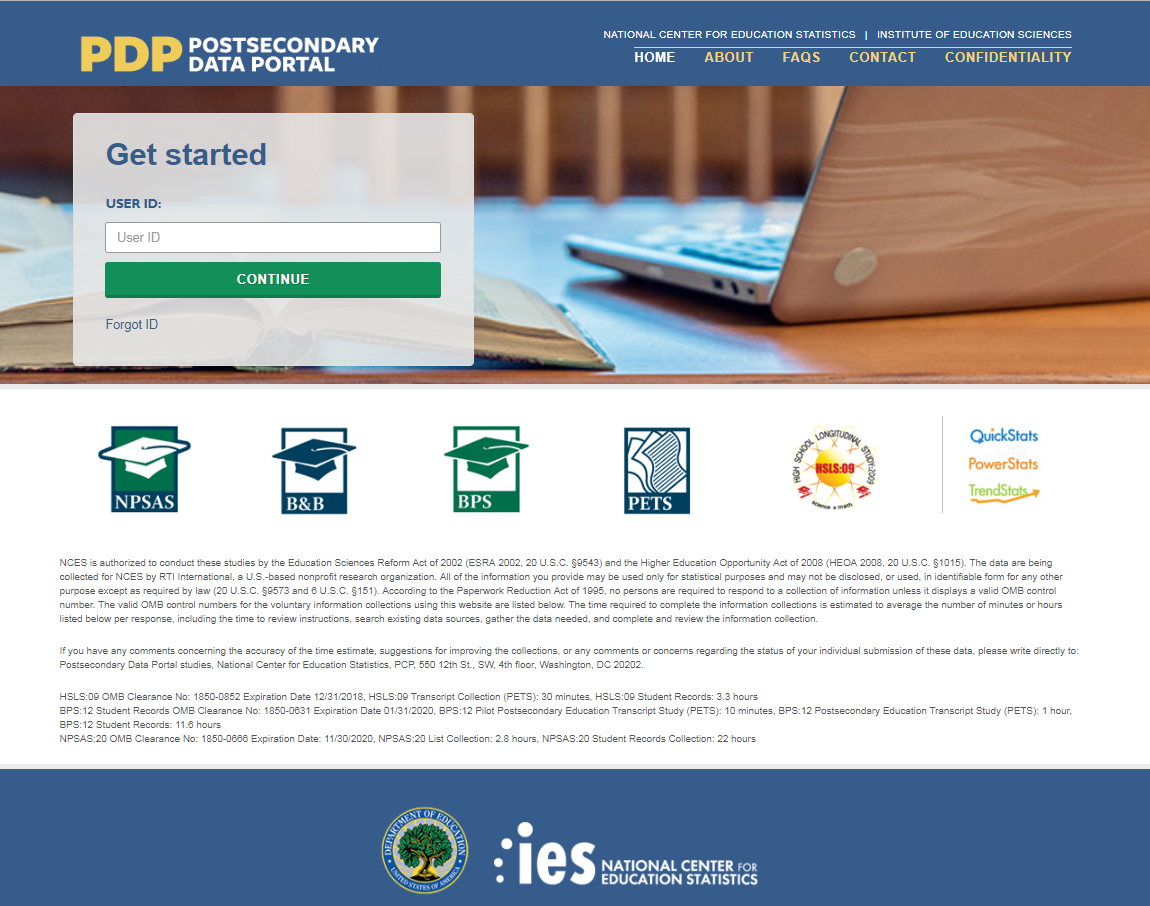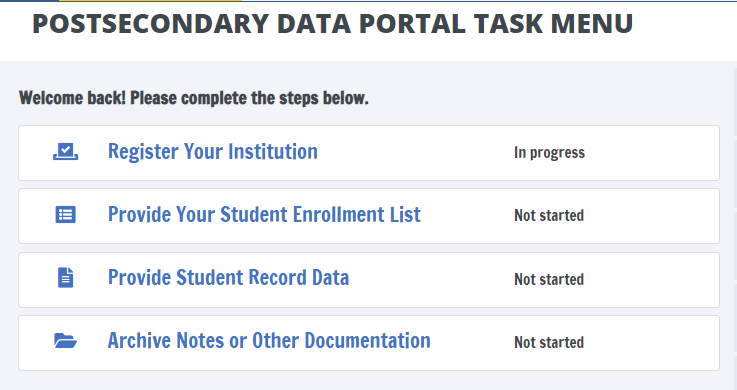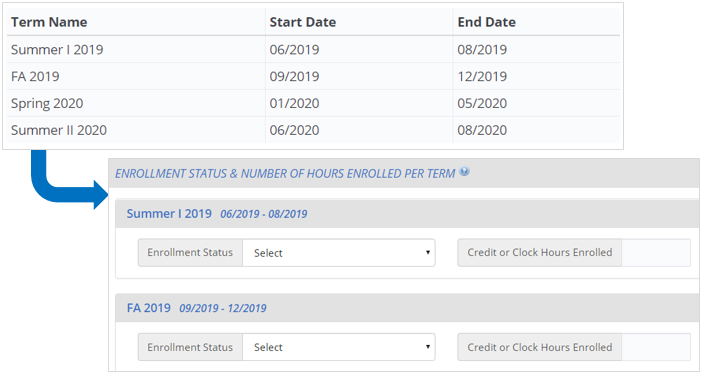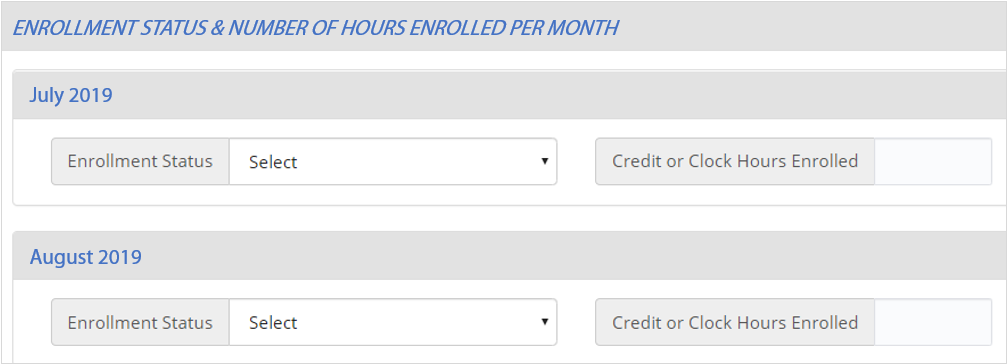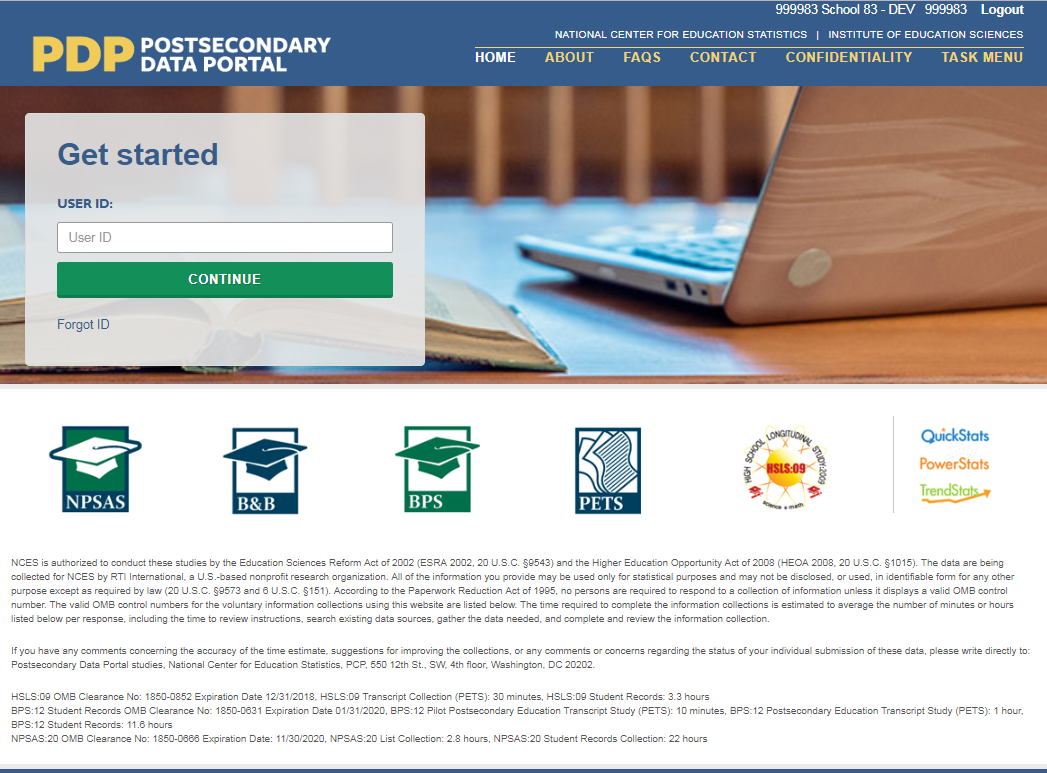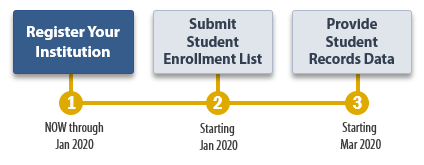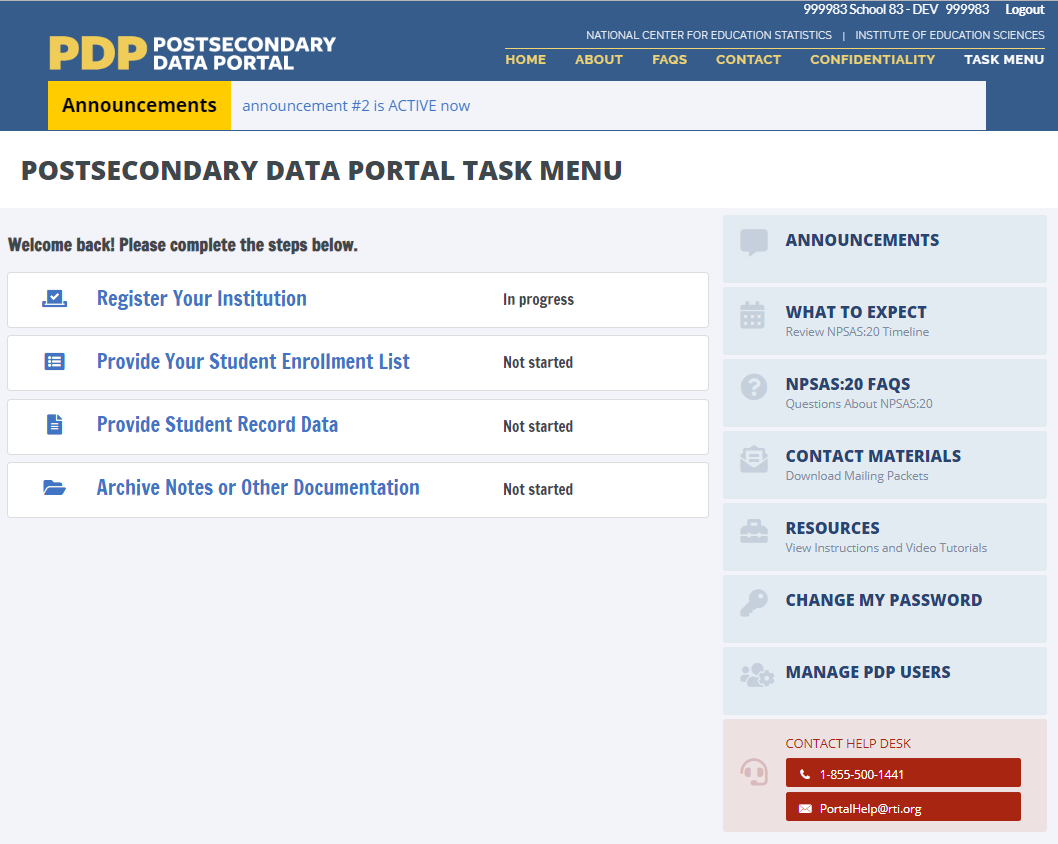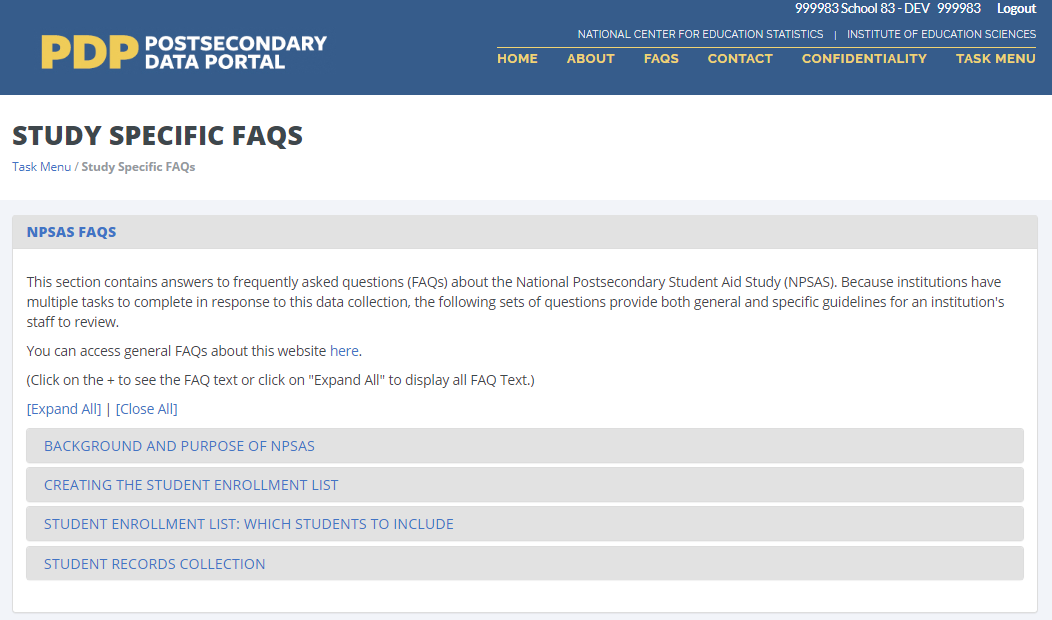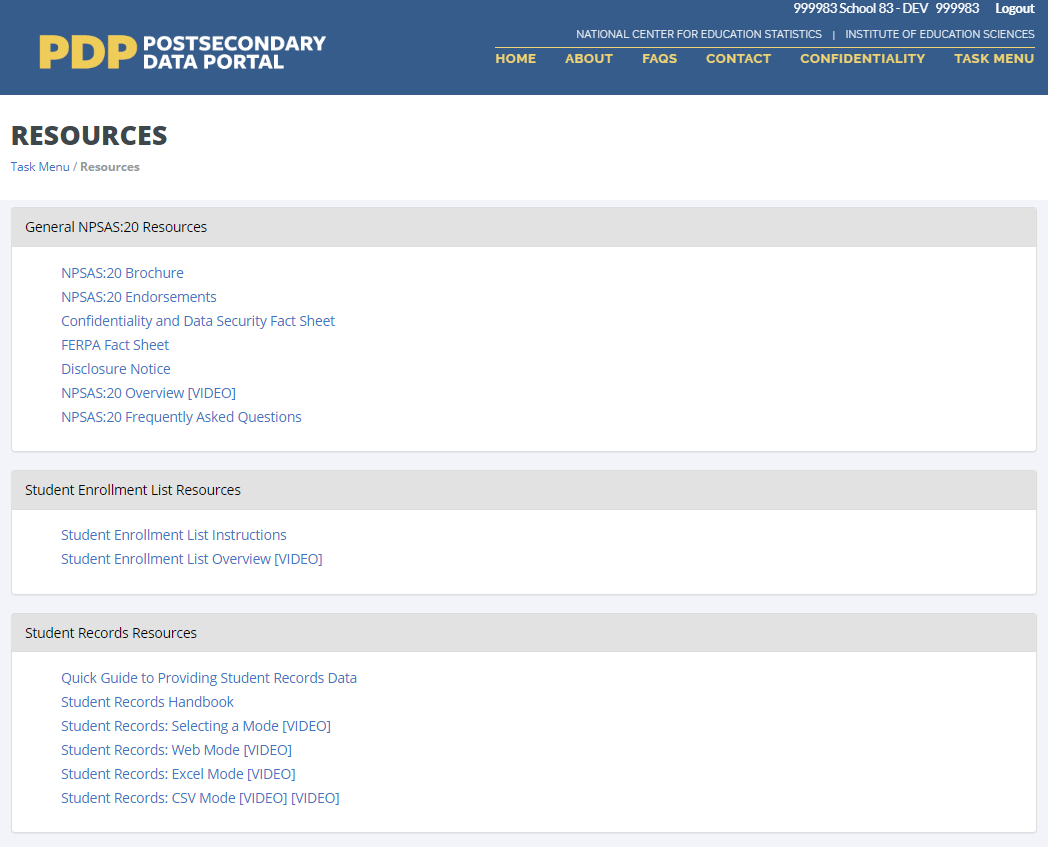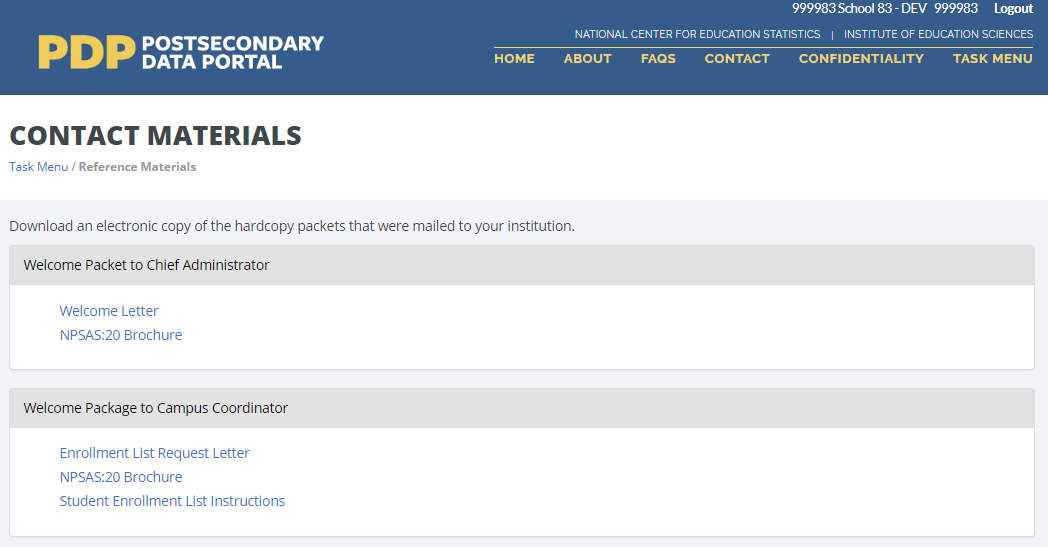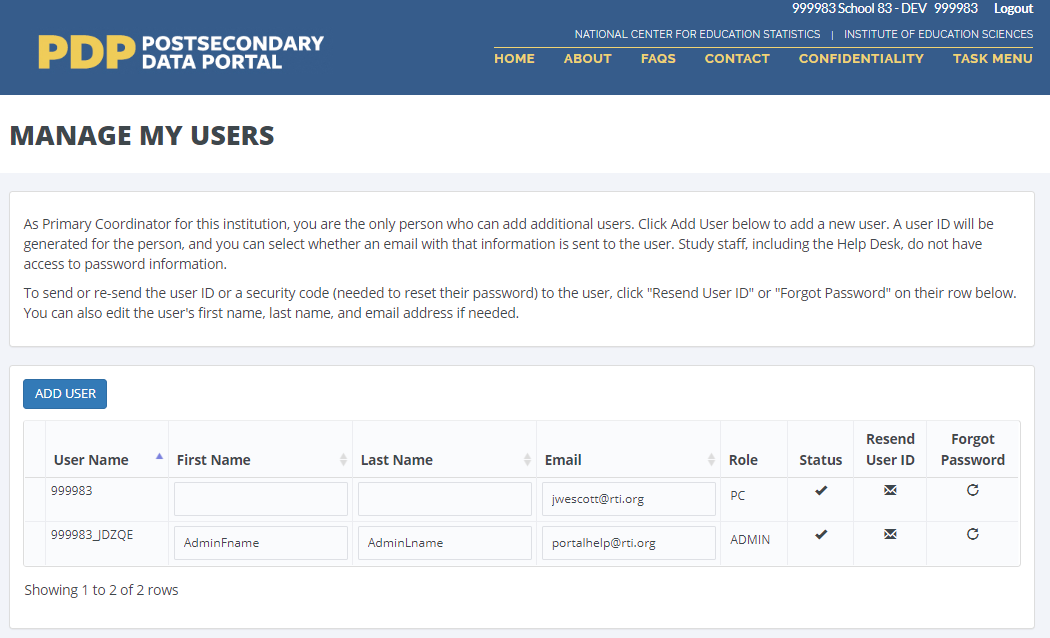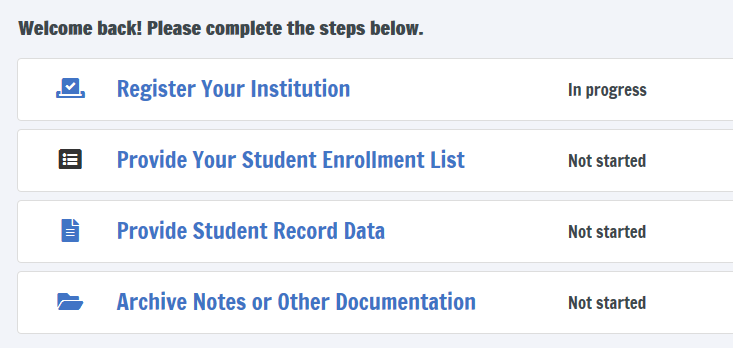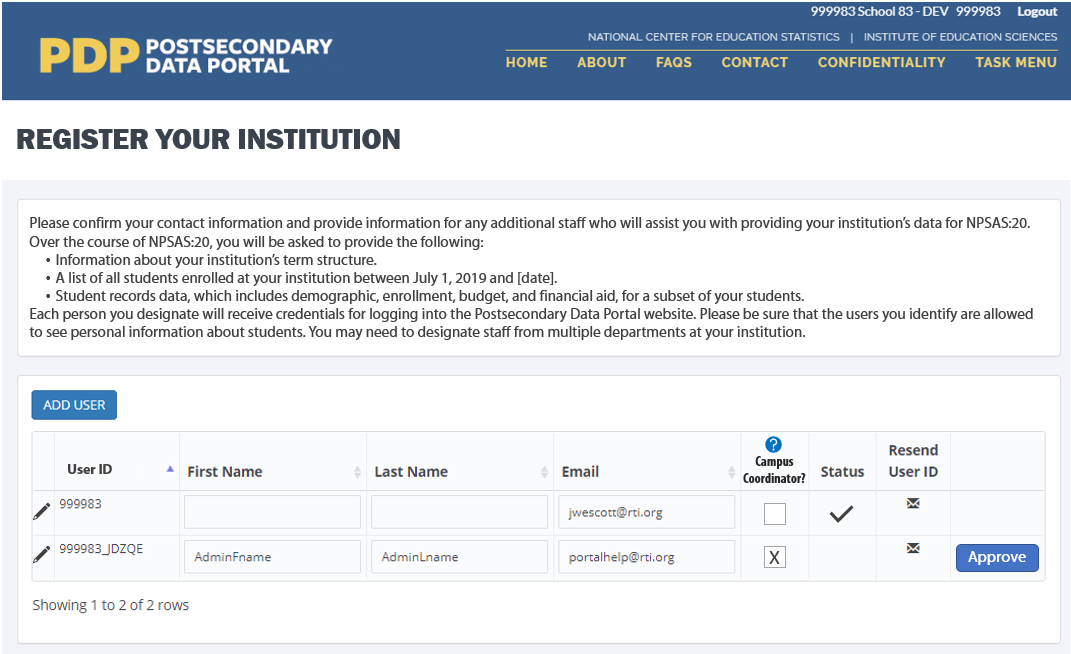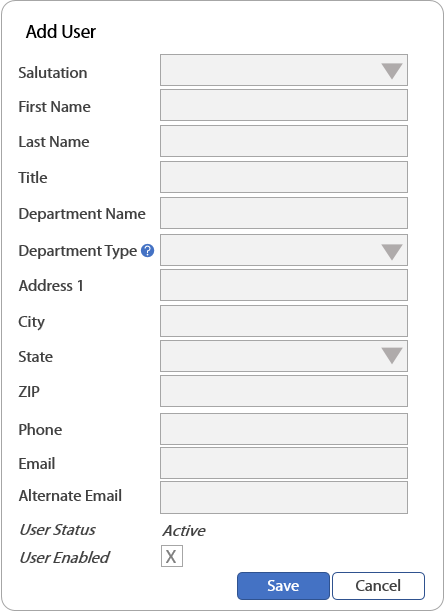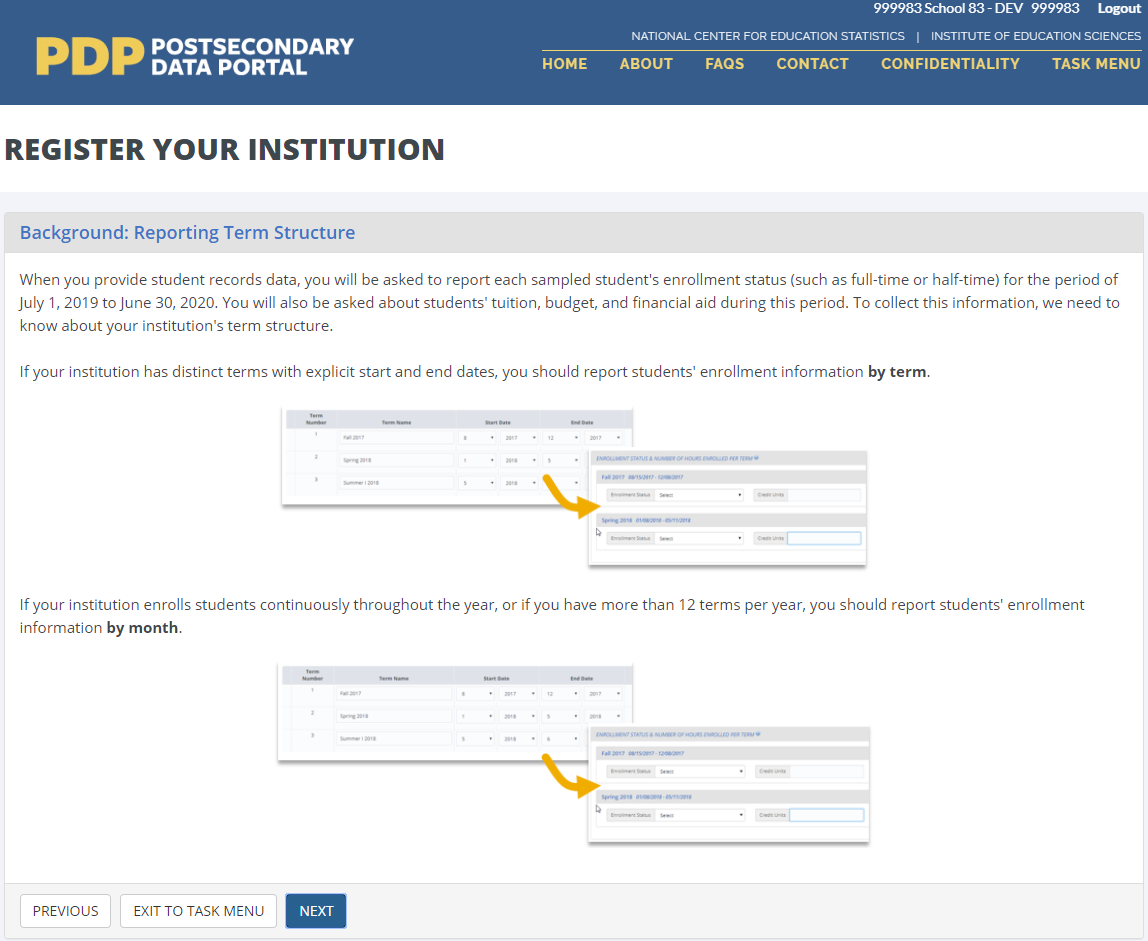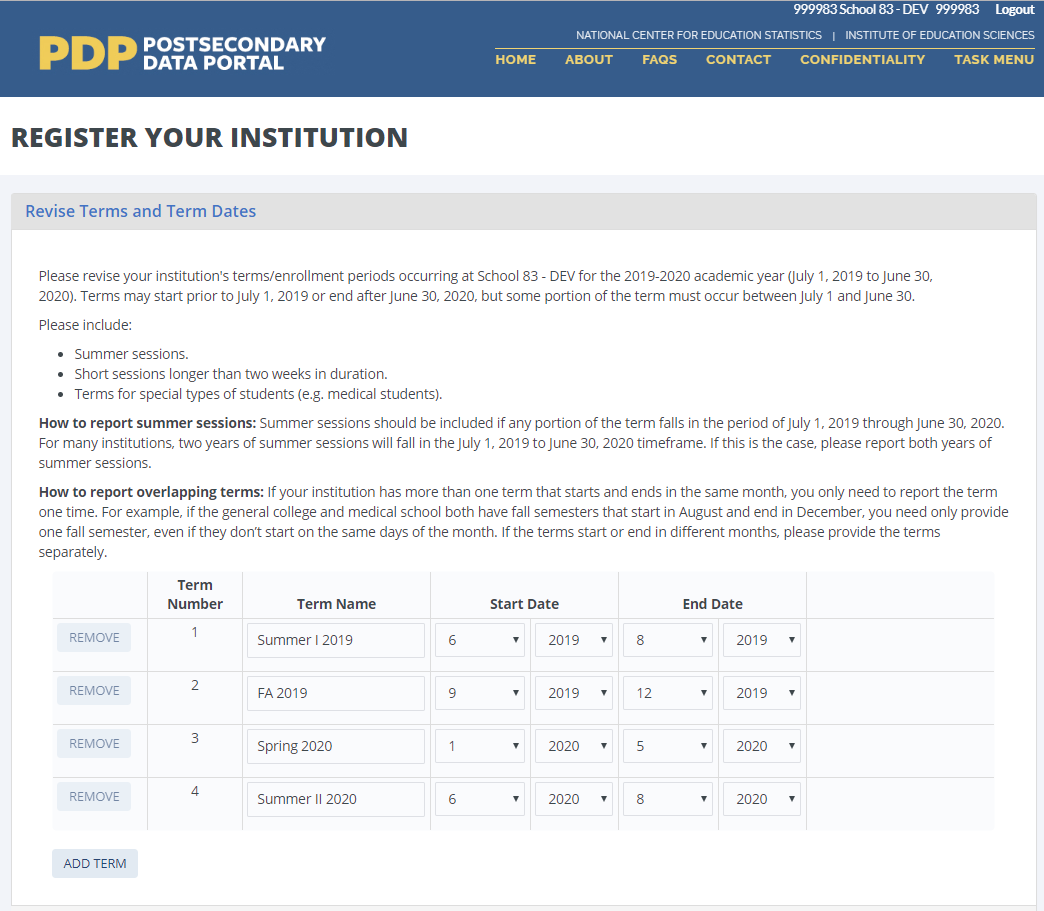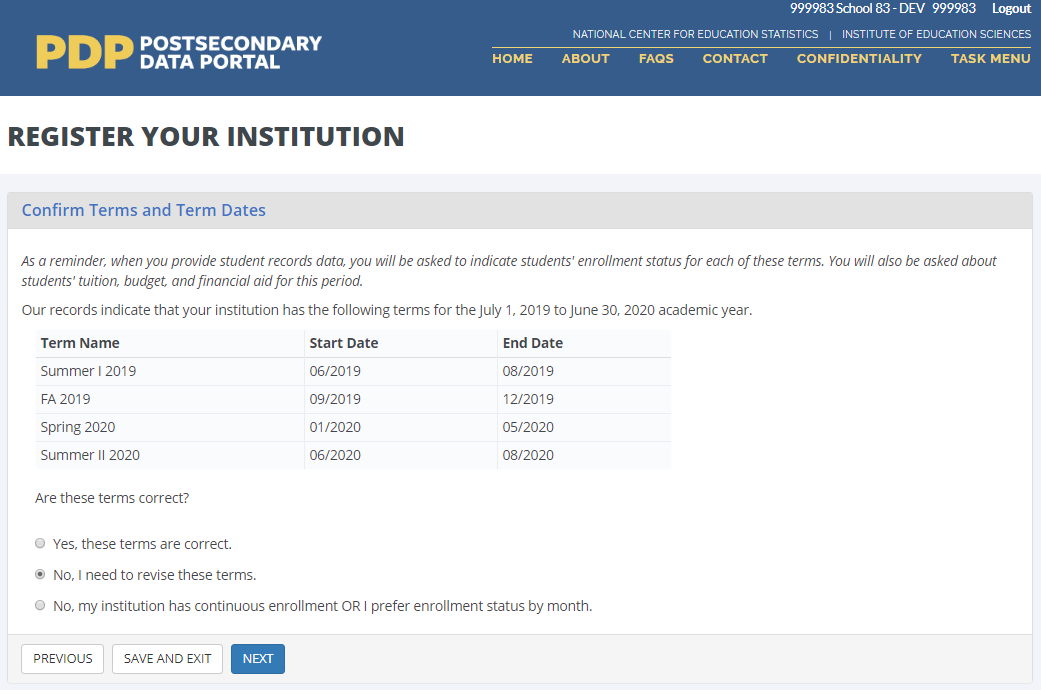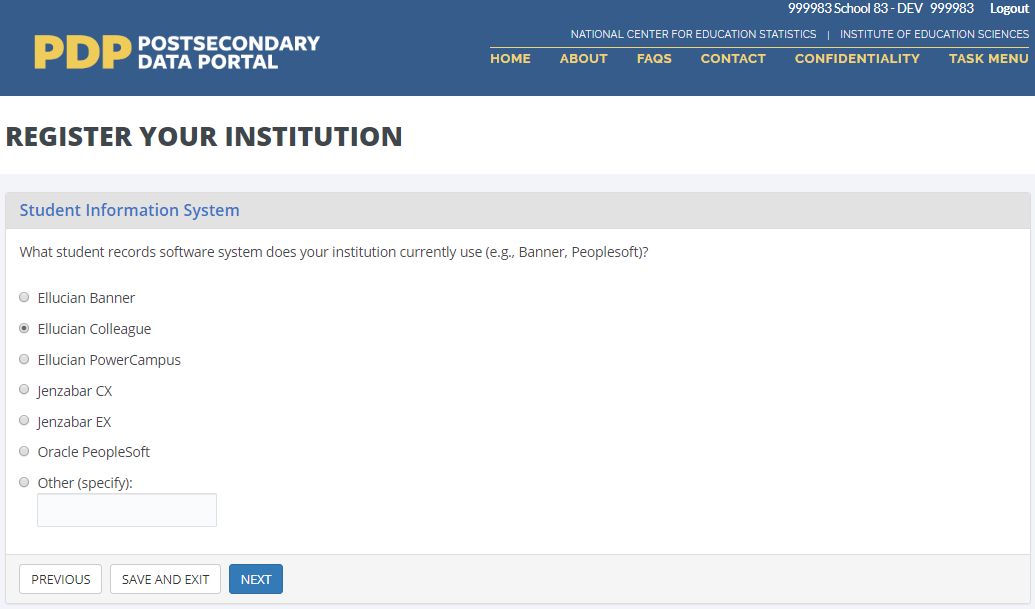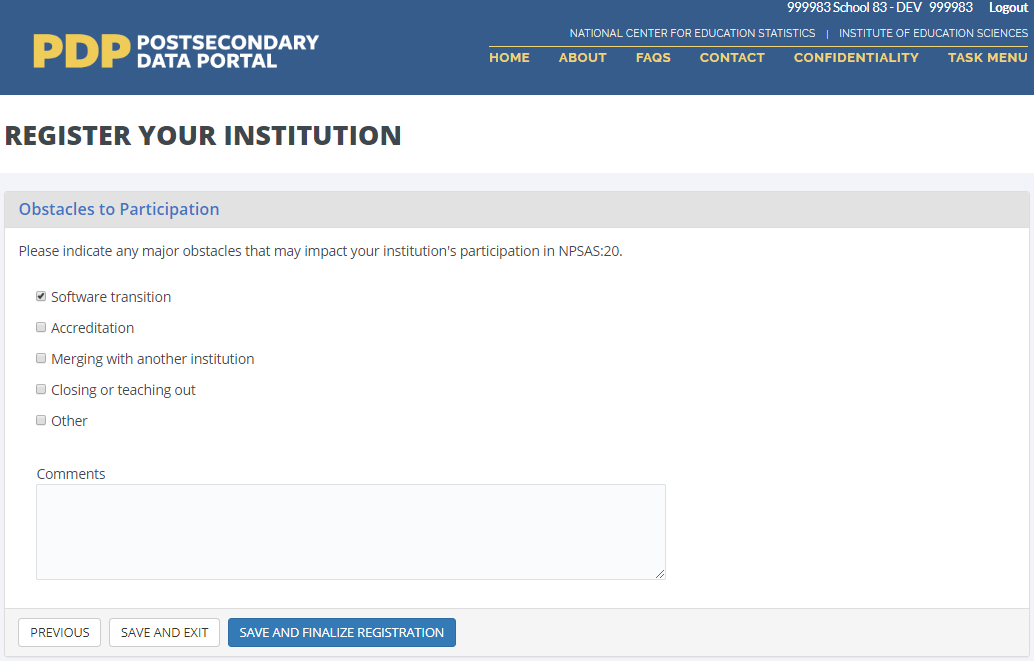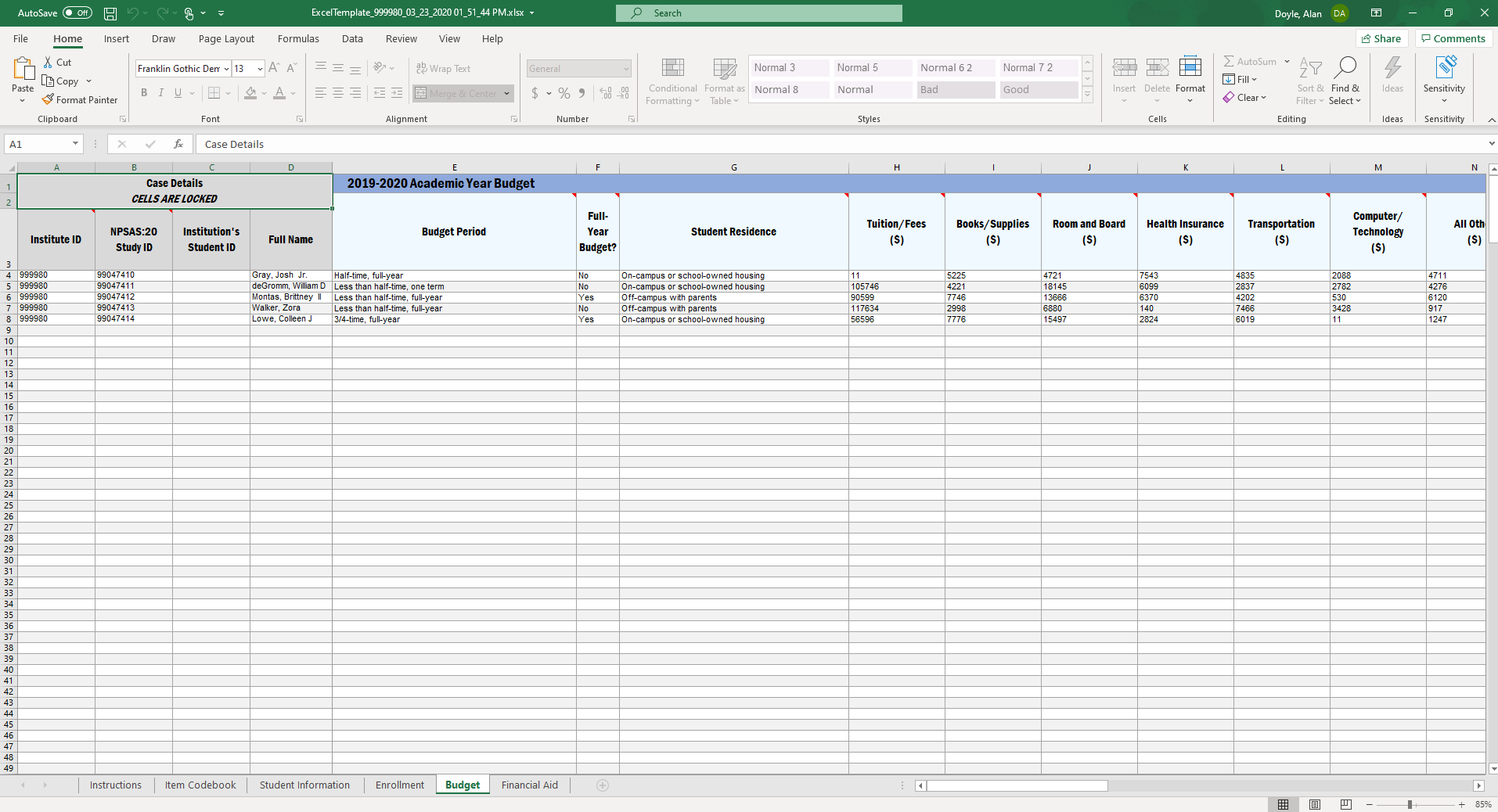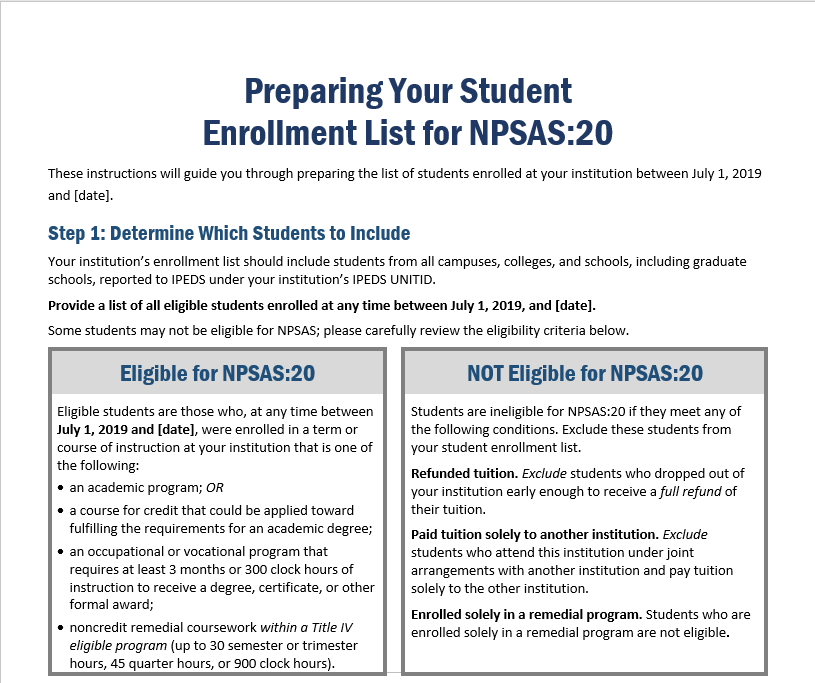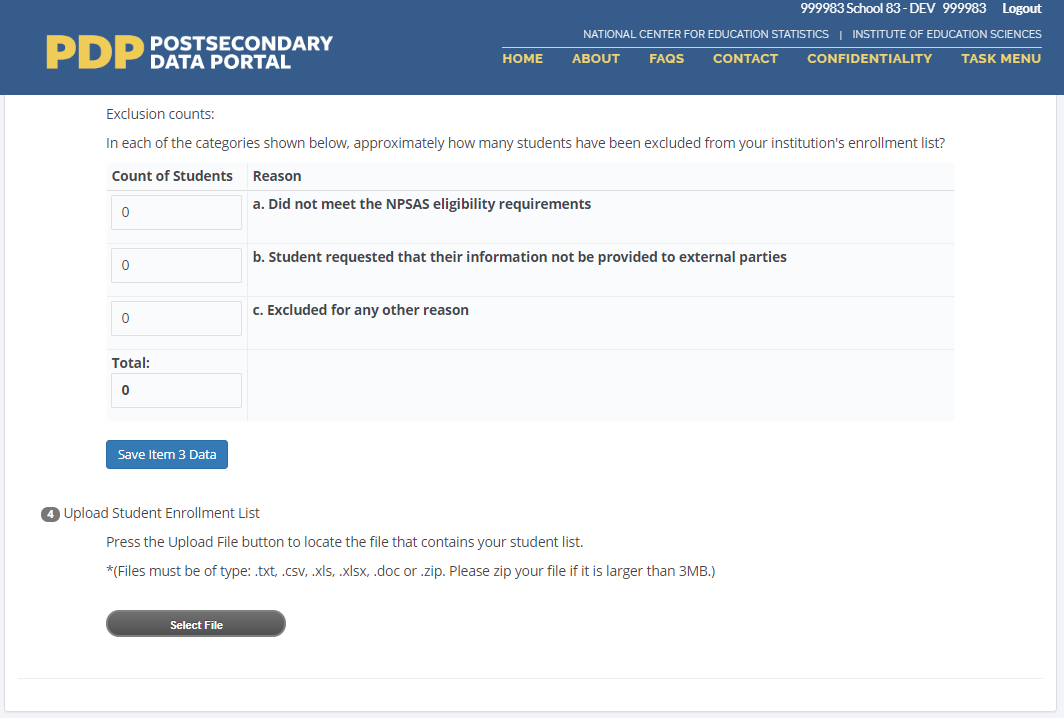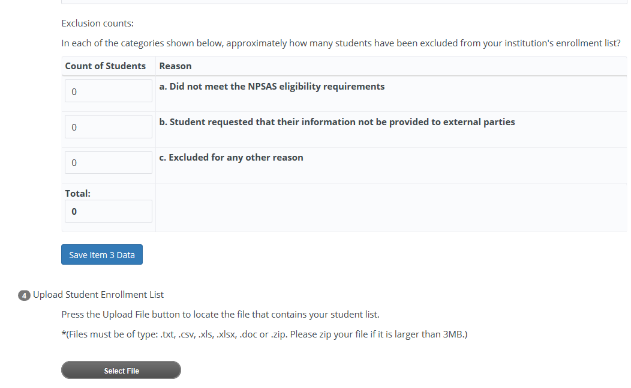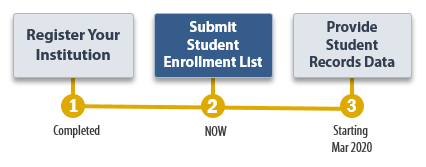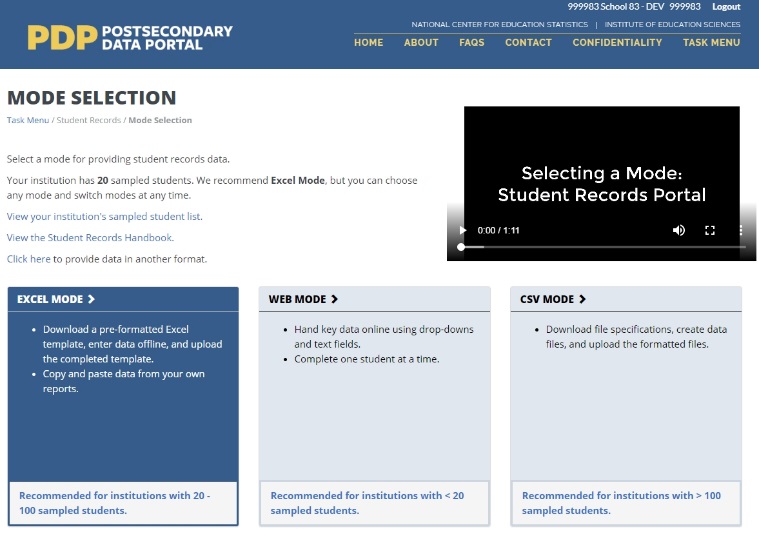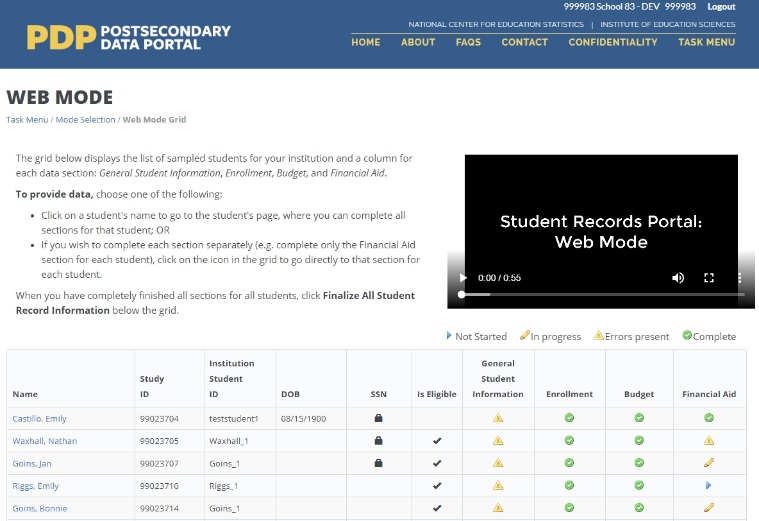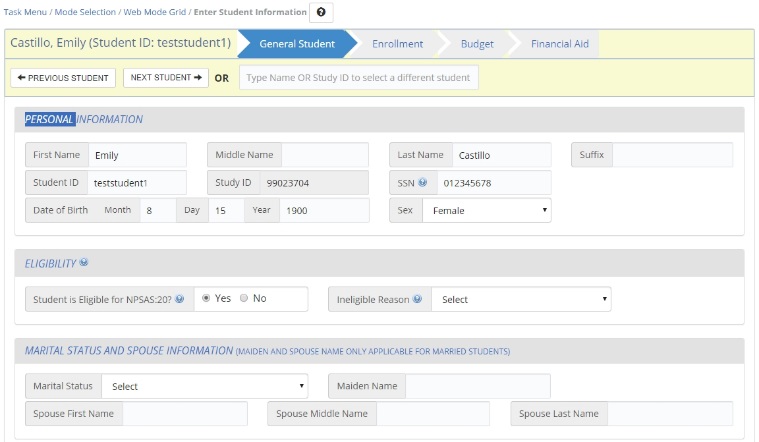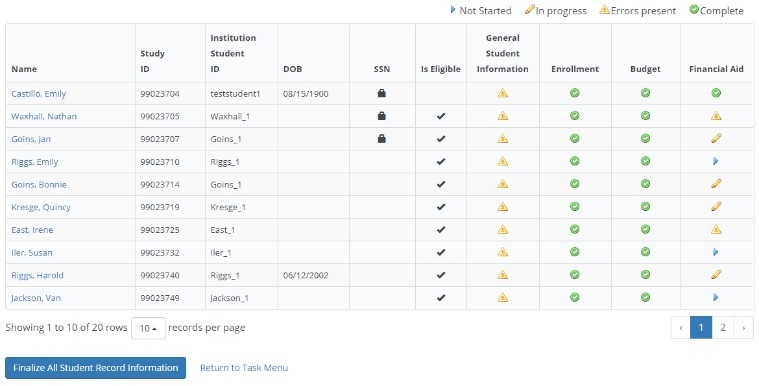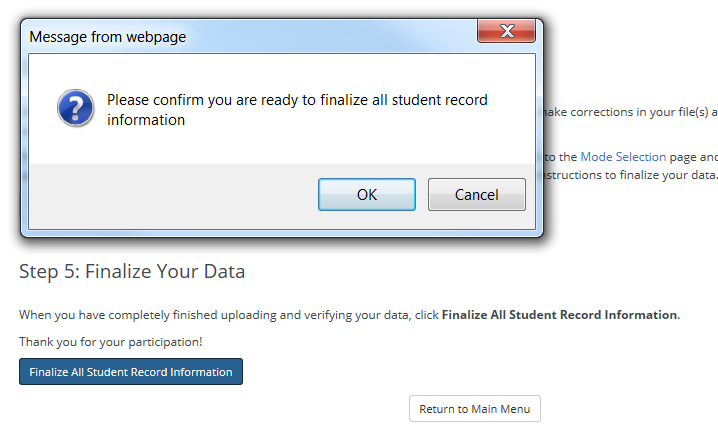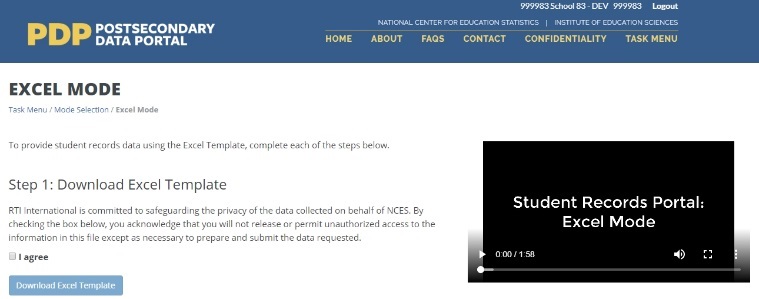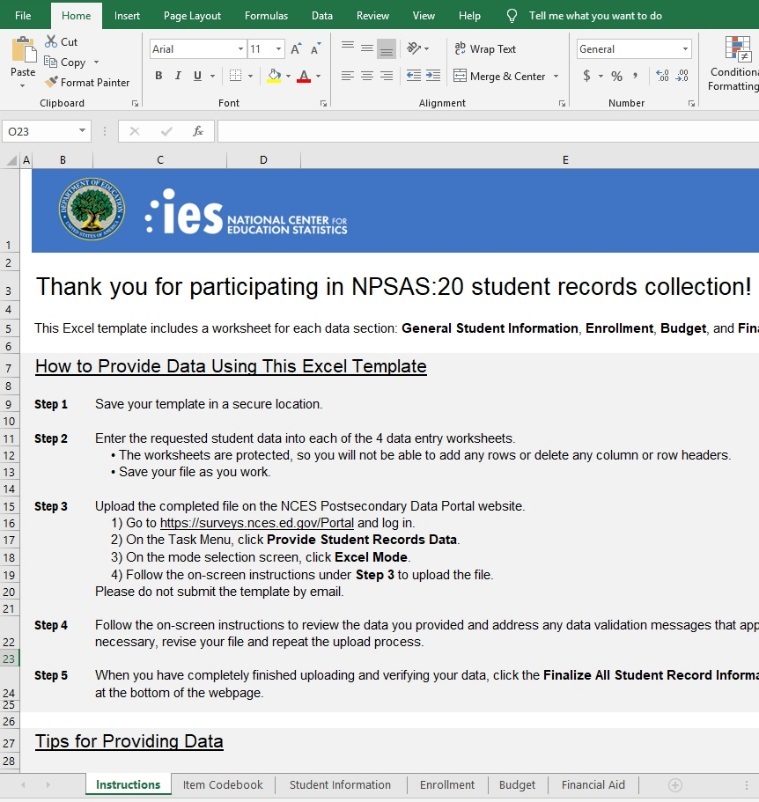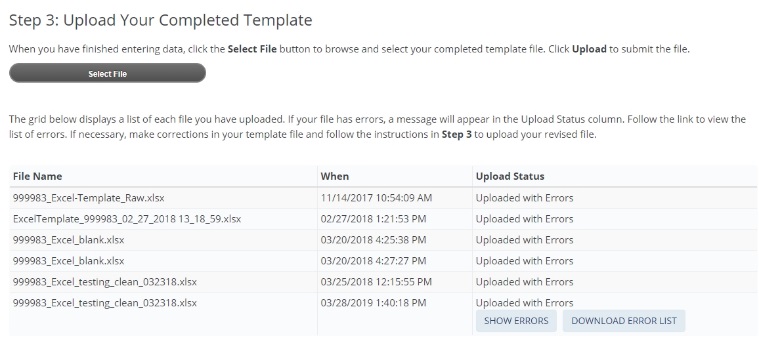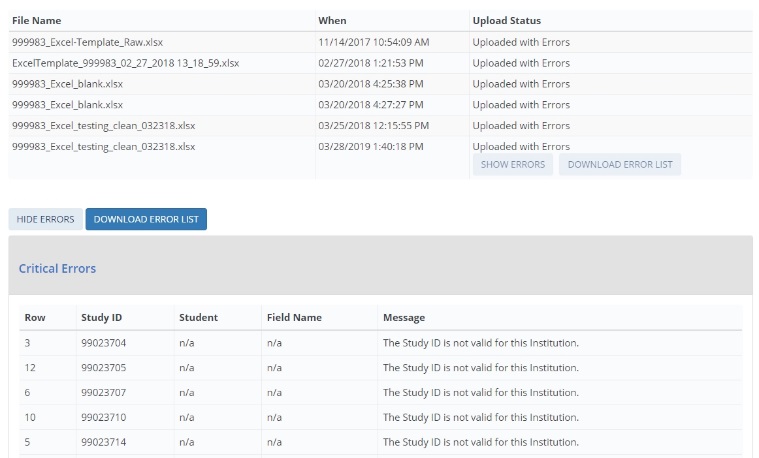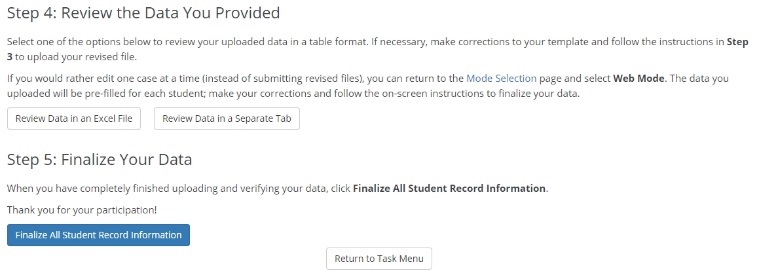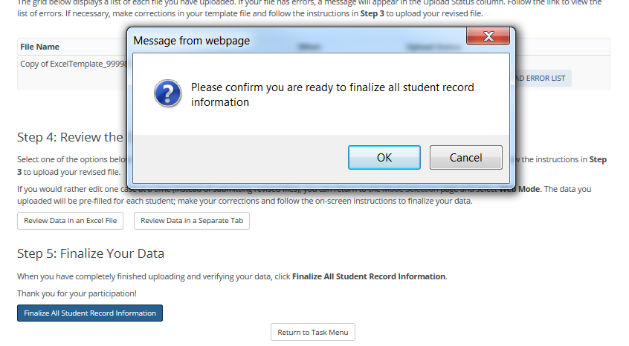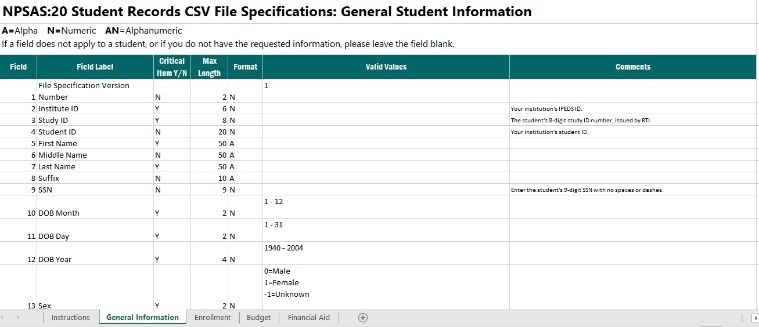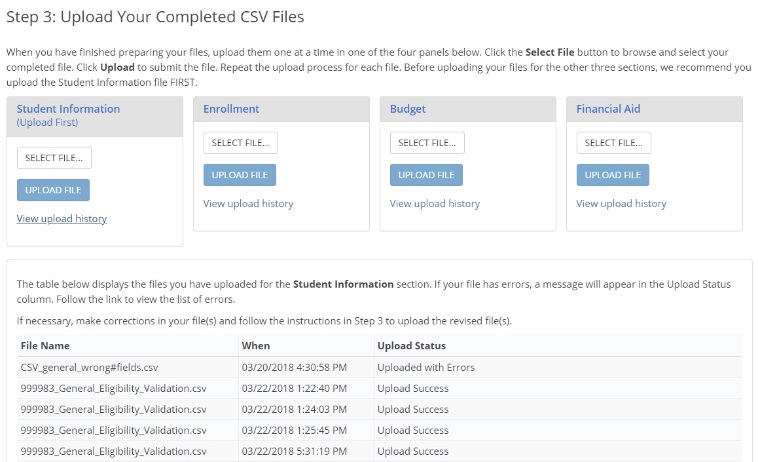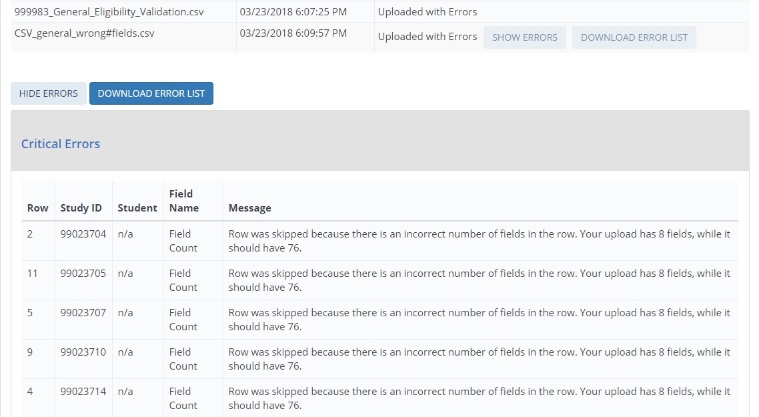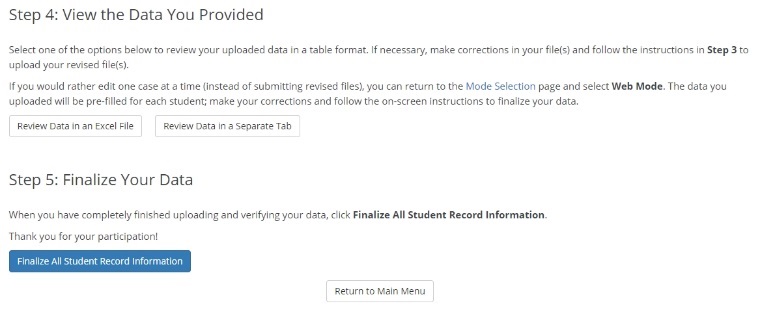Appendix D NPSAS24FT InstContactingMats_Updated
2023-24 National Postsecondary Student Aid Study (NPSAS:24) Field Test - Student Data Collection and Student Records
Appendix D NPSAS24FT InstContactingMats_Updated
OMB: 1850-0666
2023–24 NATIONAL POSTSECONDARY STUDENT AID STUDY (NPSAS:24) FIELD TEST
Student Data Collection and Student Records
Appendix D
Appendix D1: Institution Contacting Materials for Field Test Enrollment List Collection
(Carryover from OMB #1850-0666 v.33)
Appendix D2: Institution Contacting Materials for Field Test Student Records Collection
OMB # 1850-0666 v.34
Submitted by
National Center for Education Statistics
U.S. Department of Education
September 2022
edited November 2022
Appendix D1: Institution Contacting Materials for Field Test Enrollment List Collection
This appendix includes the contacting materials, instructions, and website text that will be used for recruiting institutions to participate in the 2023–24 National Postsecondary Student Aid Study (NPSAS:24) field test enrollment list collection.
The NPSAS:24 field test contacting materials are divided by mailing phase, such that all materials for one mailing packet are included together. Each mailing in this appendix is separated by a heading, and each section includes a description of the mailing and the materials that are included. These descriptions are located in the gray box, directly below the section heading. An institution contacting flowchart is provided in the Supporting Statement Part B section B.3 of this submission.
The instructions and website text included in this appendix are based primarily on those developed and approved for NPSAS:20 (OMB #1850-0666). In NPSAS:24, institutions will create their own student enrollment list files using the instructions and file specifications included in this appendix or provide enrollment lists using a pre-formatted template file, a new feature added for the NPSAS:24 field test. The new enrollment list template is still being developed; the instructions and website text included in this appendix are based on preliminary designs of the template. Once the designs are finalized and programmed, minor updates may be required to the materials below to provide institutions with accurate instructions and guidance for using the new template.
The materials for the NPSAS:24 full-scale data collection will be heavily based on the materials in this appendix, although we anticipate small changes based on the experiences of the field test. The finalized full-scale materials will undergo another review with a 30-day public comment period in summer 2023.
For the sake of space, text stating OMB authorization and the control number has not been included in each letter and e-mail. However, unless otherwise indicated, all letters will include the following text:
NCES is authorized to conduct the 2023–24 National Postsecondary Student Aid Study (NPSAS:24) field test by the Education Sciences Reform Act of 2002 (ESRA 2002, 20 U.S.C. §9543) and the Higher Education Opportunity Act of 2008 (HEOA 2008, 20 U.S.C. §1015). The data are being collected for NCES by RTI International, a U.S.-based nonprofit research organization. All of the information you provide may be used only for statistical purposes and may not be disclosed, or used, in identifiable form for any other purpose except as required by law (20 U.S.C. §9573 and 6 U.S.C. §151).
The Family Educational Rights and Privacy Act of 1974 (FERPA, 20 U.S.C. §1232g) allows for the release of institution record information to the Secretary of Education or his agent without prior consent of survey members (34 CFR §§ 99.31(a)(3)(iii) and 99.35).
According to the Paperwork Reduction Act of 1995, no persons are required to respond to a collection of information unless it displays a valid OMB control number. The valid OMB control number for this voluntary information collection is 1850-0666. The time required to complete this information collection is estimated to average the number of minutes or hours listed below per response, including the time to review instructions, search existing data sources, gather the data needed, and complete and review the information collection. If you have any comments concerning the accuracy of the time estimate, suggestions for improving this information collection, or any comments or concerns regarding the status of your individual submission of these data, please write directly to: Postsecondary Data Portal studies, National Center for Education Statistics, PCP, 550 12th St., SW, Room 4007, Washington, DC 20202.
NPSAS:24 Field Test OMB Clearance No: 1850-0666 Expiration Date: xx/xx/xxxx
NPSAS:24 Field Test List Collection: 5 hours
Similarly, unless otherwise indicated, mailings sent by e-mail will include the following text:
OMB Control Number: 1850-0666
Learn more about our confidentiality procedures at: https://surveys.nces.ed.gov/xxxx.
Contents
Appendix D1: Institution Contacting Materials for Field Test Enrollment List Collection 2
Contents 4
Chief Administrator Mailing 6
Chief Administrator Letter and E-mail – Campus Coordinator Recommended 7
Chief Administrator Letter and E-mail – No Campus Coordinator Recommended 9
Study Brochure 11
Chief Administrator Reminder E-mail from NCES 13
Campus Coordinator Welcome Mailing 14
Registration Letter and E-mail 15
Quick Guide to NPSAS:24 16
Registration Instructions 19
Registration Reminder Letter and E-mail 22
Coordinator List Request Mailing 23
Registration Thank You E-mail 24
List Request Letter and E-mail 25
Student Enrollment List Preparation Instructions 26
List Request Reminder Letter and E-mail 36
List Thank You E-mail 37
Other Contact Materials 38
Registration/List Collection Is Ending Mailer and Email 38
Final Weeks of List Collection E-mail – From NCES 39
Postsecondary Data Portal Login Instructions 40
NPSAS Study Timeline Graphic 42
PDP Website Content – Pre-Login (Not Study Specific) 43
About the PDP 44
FAQs (prior to log-in) 44
Contact Us 46
Confidentiality 46
PDP Website Content – After Login 48
Welcome Page 48
Task Menu 48
Designate A Coordinator Page 49
Registration Page 49
Enrollment List Page 56
Archive Notes or Other Documentation Page 57
FAQs (after log-in) 58
Contact Materials Page 62
Resources Page 62
Resource Materials 64
Confidentiality and Data Security Fact Sheet 64
FERPA Fact Sheet 66
Disclosure Notice 74
Scripts and Storyboards for Instructional Videos 75
Appendix D2: Institution Contacting Materials for Field Test Student Records Collection 84
Contents 86
Student Records Request Mailing and Follow-ups 87
Student Records Request Letter and E-mail (same text) 88
Student Records Reminder Letter and E-mail 89
NPSAS:24 Field Test Participation Complete E-mail 91
NPSAS:24 Field Test Participation Thank You Letter and Email to Campus Coordinator 92
End of Data Collection E-mails 93
Final Weeks of Student Records E-mail – From Project Director 94
Final Weeks of Student Records E-mail – From NCES 95
NPSAS Field Test Is Complete Thank You E-mail – From Project Director 96
PDP Website Content for Student Records Collection 97
Frequently Asked Questions – Student Records (SR) Collection 97
Student Records Debriefing 98
Scripts and Storyboards for Instructional Videos 99
Resources 110
Financial Aid Types Cheat Sheet 110
Student Records Codebook 111
Student Records Handbook 156
Student Records Item Overview Handout 175
Chief Administrator Mailing
This mailing is sent to each institution’s chief administrator at the start of data collection. The mailing includes a letter/email requesting the institution’s participation in the NPSAS:24 field test and a NPSAS:24 field test brochure. There will be two versions of the letter/email to be sent to:
The materials for this mailing are included below. |
Chief Administrator Letter and E-mail – Campus Coordinator Recommended
(Date)
(Salutation) (FirstName) (LastName)
(Title)
(Institution)
(Address)
(City), (State) (Zip)
Dear (Salutation) (LastName):
The U.S. Department of Education’s National Center for Education Statistics (NCES) is beginning its next cycle of the National Postsecondary Student Aid Study (NPSAS). I am pleased to inform you that [Institution] has been selected to participate in the NPSAS:24 field test, which will focus on students enrolled during the 2022–23 academic year.
The purpose of the NPSAS:24 field test is to evaluate our data collection procedures and survey instruments to ensure effectiveness of the full-scale study. This includes exploring ways to reduce burden on institutions and therefore make participation during the full-scale study easier. By participating in the NPSAS:24 field test, you will help us refine our approach and make the full-scale study in 2023–24 as successful as possible. We have provided a general timeline of field test activities for you below.
[Timeline graphic – see page D-42]
What’s required of you and your staff?
The last time [Institution] participated in NPSAS, [fill last CC we had] served as your Campus Coordinator. Soon, we will contact them with guidance on how to proceed with the NPSAS:24 field test data collection. If you wish to name a new Coordinator, you may do so through the NCES Postsecondary Data Portal (PDP). We provide credentials allowing you to access the PDP at the bottom of this letter.
Data from NPSAS collections are used to inform a wide range of critical education policies. For the study to be successful and to be representative of institutions like yours, we need your help and participation. NPSAS is endorsed by [fill name of organization most closely tied to institution]. Because we know your staff time is limited, we have been working very hard to simplify the reporting requirements and minimize the time and effort needed to participate.
Want to learn more?
To learn more about NPSAS, visit the NCES study website (https://nces.ed.gov/surveys/npsas/).
We look forward to working with you over the next year. If you have questions about your participation in the NPSAS:24 field test, please contact [fill RTI contact name and title], at XXXXXX (e-mail). I can be reached at XXXXXX (e-mail).
Sincerely,
(NCES staff name)
(NCES staff title)
National Center for Education Statistics (NCES)
Institute of Education Sciences
U.S. Department of Education
Enclosures
Please note: If you wish to update your Campus Coordinator, log in to the Postsecondary Data Portal using the following information:
Chief Administrator Letter and E-mail – No Campus Coordinator Recommended
(Date)
(Salutation) (FirstName) (LastName)
(Title)
(Institution)
(Address)
(City), (State) (Zip)
Dear (Salutation) (LastName):
The U.S. Department of Education’s National Center for Education Statistics (NCES) is beginning its next cycle of the National Postsecondary Student Aid Study (NPSAS), a congressionally mandated study of how students and their families pay for college. I am pleased to inform you that [Institution] has been selected to participate in the NPSAS:24 field test, which will focus on students enrolled during the 2022–23 academic year.
The purpose of the NPSAS:24 field test is to evaluate our data collection procedures and survey instruments to ensure effectiveness of the full-scale study. This includes exploring ways to reduce burden on institutions and therefore make participation during the full-scale study easier. By participating in the NPSAS:24 field test, you will help us refine our approach and make the full-scale study in 2023–24 as successful as possible.
Data from NPSAS collections are used to inform a wide range of critical education policies. For the study to be successful and to be representative of institutions like yours, we need your help and participation. NPSAS is endorsed by [fill name of organization most closely tied to institution].
What’s required of you and your staff?
Participation in the NPSAS:24 field test occurs in steps, laid out for you below. All you have to do is name a Campus Coordinator. This coordinator will then be asked to register your institution in the Postsecondary Data Portal (PDP), the data collection system for NPSAS:24, and provide a 2022–23 enrollment list to our contractor, RTI International (RTI), the research organization carrying out the NPSAS:24 data collection on behalf of NCES. RTI will select a sample of students from your list and, later, collect data on sampled students’ enrollment, budget, and financial aid for 2022–23. Because we know your staff time is limited, we have been working very hard to simplify the reporting requirements and minimize the time and effort needed to participate.
[Timeline graphic – see page D-42]
To name [Institution]’s Campus Coordinator, please visit the PDP:
-
Your user ID: (UserID)
Want to learn more?
To learn more about NPSAS, I invite you to visit the NCES study website (https://nces.ed.gov/surveys/npsas/).
We look forward to working with you over the next year. If you have questions about your participation in the NPSAS:24 field test, please contact [fill RTI contact name and title], at XXXXXX (e-mail). I can be reached at XXXXXX (e-mail).
Sincerely,
(NCES staff name)
(NCES staff title)
National Center for Education Statistics (NCES)
Institute of Education Sciences
U.S. Department of Education
Enclosures
Study Brochure
2023–24 National Postsecondary Student Aid Study (NPSAS:24) Field Test
What Is NPSAS?
The National Postsecondary Student Aid Study (NPSAS) is a nationally representative study focused primarily on how students and their families pay for postsecondary education. Student interview data are combined with institution and administrative record data to form a comprehensive research dataset with information on student enrollment, financial aid, and employment. NPSAS data are used by federal and state government, postsecondary institutions, associations advocating for higher education, researchers, employers, and other private agencies. It is the primary source of information used to analyze the effectiveness of student financial aid and to inform public policy on programs such as Pell grants and Direct/Stafford loans.
What Is the Purpose of the NPSAS:24 Field Test and Why Should My Institution Participate?
The purpose of the NPSAS:24 field test is to evaluate our data collection procedures and survey instruments to ensure the effectiveness of the full-scale study. This includes exploring ways to reduce burden on institutions and therefore make participation during the full-scale study easier. By participating in the NPSAS:24 field test, you will help us refine our approach and make the full-scale study as successful as possible.
How Are the Data Used?
After each NPSAS is completed, NCES releases key statistics on financial aid then makes the data available to researchers who conduct their own analyses. NPSAS data are an important resource for informing decisions related to student financial aid programs and effecting change to the benefit of students and their families. Analysis of NPSAS data from prior years has led to reinstatement of year-round Pell grants and the “prior-prior year” change to the FAFSA, which enables students to better research their aid options and file for aid earlier. “Prior-prior year” means that students are able to use tax information from two years ago to file their FAFSA.
In addition to these more prominent examples, NPSAS data are regularly cited in association and other national reports, scholarly journals, newspaper articles, and other publications, on a variety of topics, including student demographics, financial aid and debt accumulation, and work while enrolled in postsecondary education.
Can I Access NPSAS National Data for My Own Use?
Absolutely! NCES’s DataLab (https://nces.ed.gov/datalab) provides a suite of powerful and intuitive online data tools for creating tables and conducting analyses using NPSAS and other NCES datasets. Many different reports and publications are also available for download from the main NCES website.
Institutions can use NPSAS data to expand their benchmarking work and provide a useful complement to their Integrated Postsecondary Education Data System (IPEDS) data.
About NCES
NCES is authorized by federal law to collect, collate, analyze, and report complete statistics on the condition of education in the United States and other nations. Through the Higher Education Opportunity Act of 2008 (20 U.S.C. §1015), Congress requires that NCES collect information from postsecondary institutions about how students and their families finance education beyond high school. NPSAS has collected information from postsecondary students and institutions since 1987.
Confidentiality of Data
NCES is required to follow strict procedures to protect personal information in the collection, reporting, and publication of data. All of the information provided by individuals or institutions may be used only for statistical purposes and may not be disclosed, or used, in identifiable form for any other purpose except as required by law (20 U.S.C. §9573 and 6 U.S.C. §151).
The Family Educational Rights and Privacy Act of 1974 (FERPA, 34 CFR §§ 99.31(a)(3)(iii) and 99.35) permits institutions to disclose personally identifiable information from students’ education records, without consent, to authorized representatives of the Secretary of Education in connection with an evaluation of federally supported education programs. RTI International, as the contractor for NCES, has been given the authority to collect information from institution records on behalf of NCES.
Protection of Electronic Files
All
electronic files from institution records will be protected. Computer
accounts used to access data will be password protected with
multilevel access controls to ensure that only authorized individuals
are allowed access to confidential data. For the web-based data
collection, proven methods of protection for online sessions and data
security over the Internet will be used. Secure Sockets Layer (SSL)
protocol will be used to encrypt the data. All the data entry modules
on the website will be password protected, which will require the
user to log in to the site before accessing confidential data.
Preparation of Data for Public Release
It
will not be possible to identify specific individuals in any data
released to the public (e.g., statistical tables and data files).
For assistance, please contact the Help Desk:
or visit the website: https://XXXXX
Postsecondary Data Portal Help Desk
1-XXX-XXX-XXXX
If you have questions or concerns about NPSAS:24, contact:
RTI International
Jennifer Wine, Ph.D.
Director, NPSAS:24
1-XXX-XXX-XXX
National Center for Education Statistics (NCES)
Tracy Hunt-White, Ph.D.
NCES Study Director, NPSAS:24
(XXX) XXX-XXXX
Conducted by
<NCES logo>
U.S. Department of Education
National Center for Education Statistics (NCES), Washington, DC
OMB Control Number: XXXX-XXXX. Learn more about our confidentiality procedures at: https://surveys.nces.ed.gov/XXX.
Chief Administrator Reminder E-mail from NCES
We recently contacted you, asking that you name a Campus Coordinator to facilitate [fill institution]’s participation in the 2023–24 National Postsecondary Student Aid Study (NPSAS:24) field test.
By participating in the field test, you will help us tailor our approach to NPSAS:24, which includes exploring ways to reduce burden on institutions, and therefore ensure a successful full-scale study.
It’s easy to kick off your participation. Just name your Campus Coordinator by visiting the Postsecondary Data Portal (PDP):
NPSAS is endorsed by [fill name of organization most closely tied to institution]. If you have questions about your participation, please contact [fill RTI contact name and title] at XXXXXX (e-mail). I can be reached at XXXX (e-mail).
(NCES staff name)
(NCES staff title)
National Center for Education Statistics (NCES)
Institute of Education Sciences
U.S. Department of Education
Campus Coordinator Welcome Mailing
This mailing is sent to each institution’s NPSAS:24 field test coordinator. It includes a letter/e-mail welcoming the coordinator to the NPSAS:24 field test, a NPSAS:24 field test brochure, and a guide for getting started. The same brochure included in the chief administrator mailing is included. The guide for getting started is included below. |
Registration Letter and E-mail
[Date]
[Salutation] [FirstName] [LastName]
[Title]
[Institution]
[Address]
[City], [State] [Zip]
Dear [Salutation] [LastName]:
The U.S. Department of Education’s National Center for Education Statistics (NCES) is beginning its next cycle of the National Postsecondary Student Aid Study (NPSAS), a congressionally mandated study of how students and their families pay for college. [Institution] has been selected to participate in the NPSAS:24 field test, which will focus on students enrolled during the 2022–23 academic year.
The purpose of the NPSAS:24 field test is to evaluate our data collection procedures and survey instruments to ensure effectiveness of the full-scale study. This includes exploring ways to reduce burden on institutions and therefore make participation during the full-scale study easier. By participating in the NPSAS:24 field test, you will help us refine our approach and make the full-scale study in 2023–24 as successful as possible.
You are receiving this letter because you were designated by the chief administrative officer of your institution to serve as your institution’s Campus Coordinator for the NPSAS:24 field test or you previously served in this role for NPSAS (in which case we have notified the chief administrative officer of your institution that we would be contacting you).
As a coordinator for the NPSAS:24 field test, you will be asked to complete the following tasks:
[Timeline graphic – see page D-42]
As the study progresses, we will provide you with detailed instructions for completing each portion of the study. At this time, we ask that you log in to the NCES Postsecondary Data Portal (PDP) and complete the Registration Page using the information provided in the box below. Enclosed is a guide to help you. During Registration, you will be asked to name colleagues at your institution who may be involved in providing data. Users you name will gain access to the PDP and receive information on the study. For this reason, please be sure that the users you identify are allowed to see personal information about students.
Because we know your staff time is limited, we have been working very hard to simplify the reporting requirements and minimize the time and effort needed to participate in NPSAS. A representative of RTI International, our contractor for NPSAS:24, will reach out soon to answer any questions you may have.
For more information on NPSAS, please visit the NCES study website (https://nces.ed.gov/surveys/npsas/).
We look forward to working with you over the next year. If you have questions about your participation in NPSAS:24, please contact [fill RTI contact name and title] at [RTIe-mail]. I can be reached at [NCESe-mail].
Sincerely,
NCES staff name
NCES staff title
National Center for Education Statistics (NCES)
Institute of Education Sciences
U.S. Department of Education
Enclosures
Quick Guide to NPSAS:24
The Postsecondary Data Portal (PDP) is the data collection website for all institution-based postsecondary sample surveys conducted by the National Center for Education Statistics (NCES). You can access the PDP at surveys.nces.ed.gov/xxxx. The PDP provides information on the studies that have collected or are currently collecting data from colleges, universities, and vocational and trade schools throughout the United States. You can also find links to the studies’ pages at NCES and to DataLab, which provides a suite of powerful and intuitive online data tools for creating tables and conducting analyses using NPSAS and other NCES datasets.
|
This image is provided as an example. The PDP website is still being developed and the final image may include aesthetic changes that do not impact the content of the page. |
The PDP includes resources to help you complete NPSAS:24. On the FAQs page, you can learn about NCES and how your institution was chosen to participate. The Contact page lists the names, telephone numbers, and e-mail addresses for staff involved with the collections at NCES and at RTI International, the nonprofit organization collecting the data on behalf of NCES. Efforts to protect study data are detailed on the Confidentiality page.
Log in to the PDP using the user ID listed on your welcome letter. You will be e-mailed a security code that will allow you to complete the log in process. Once logged in, you may download your welcome packet, view instructional videos, and add additional users from your institution. Please note that for security purposes, your session will end and you will be logged out of the PDP if you remain idle for 30 or more minutes.
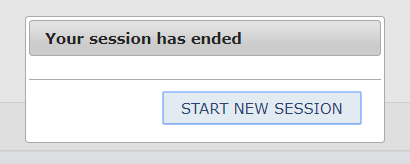
This image is provided as an example. The PDP website is still being developed and the
final image may include aesthetic changes that do not impact the content of the page.
The PDP Task Menu will show you the steps you need to complete as a participating institution.
|
This image is provided as an example. The PDP website is still being developed and the final image may include aesthetic changes that do not impact the content of the page. |
The NPSAS:24 Help Desk is available, 9 AM to 8 PM ET, to answer your questions about NPSAS:24, troubleshoot technical issues, and discuss any obstacles to participation. Contact us at.
[number]
As a NPSAS:24 Field Test participating institution, you will be asked to complete the following steps over the 2022-23 academic year:
[Timeline graphic - see page D-42]
1. Register Your Institution by designating staff who will provide your institution’s data, specifying your institution’s term structure, and answering some brief background questions about your institution.
Registration also sets the due date for the next step in the NPSAS:24 data collection. Due dates will vary based on the term structure you specify.
[graphic]
2. Submit Your 2022-23 Student Enrollment List, which will be used to select your institution’s student sample. When it is time to prepare your list, RTI will send you detailed instructions about which students should be included on your enrollment list.
[graphic]
3. Provide Student Record Data for the students at your institution sampled for the NPSAS:24 Field Test. Student records data include demographic, enrollment, budget, and financial aid information. You will receive your list of sampled students approximately 4 to 6 weeks after you submit your student enrollment list.
There are three modes for submitting student records data:
Web mode - recommended for samples of up to 20 students;
Excel mode - recommended for samples of 20 to 100 students; and
CSV mode - recommended for samples greater than 100.
[Other options for delivery of student record data – such as SAS or STATA files – can be arranged by contacting the Help Desk.]
[graphic]
Registration Instructions
Registering your institution through the Postsecondary Data Portal (PDP) is an important first step in the NPSAS:24 data collection. As you register, you will be able to confirm your contact information, specify your institution’s term structure, provide needed information about your institution, and establish a due date for the next step in data collection, providing a student enrollment list. This guide will help you make sure you have all the information you need to be successful.
To get started, log on to the Postsecondary Data Portal (PDP) at surveys.nces.ed.gov/XXX and select “Register Your Institution” from the Task Menu. There you will find a brief video tutorial about registering your institution to help you get started.
1) Designate PDP Users
To begin, you will be asked to confirm your contact information and provide information for any additional staff who will assist you with providing your institution’s NPSAS:24 data on the PDP. You may choose to designate staff from multiple departments at your institution in order to provide the general demographic, enrollment, budget, and financial aid data needed. Each person you designate will receive credentials for logging into the Postsecondary Data Portal website. For this reason, please be sure that the users you identify are allowed to see personal information about students.
2) Provide Your Term Structure
Next, you will need to specify your institution’s term structure for the 2022-23 academic year, that is from July 1, 2022 to June 30, 2023. Later, when you provide your institution’s student records data, you will report each sampled student’s enrollment status (e.g., full-time, half-time), and financial aid received, for the entire 2022-23 academic year by term. For that reason, setting up the correct term structure is the most important step in the registration process.
If your institution has distinct terms with explicit start and end dates, you should report this information by term.
|
|
This image is provided as an example. The PDP website is still being developed and the final image may include aesthetic changes that do not impact the contact of the page. |
|
If your institution enrolls students continuously throughout the year, or if you have more than 12 terms per year, you should report your student data by month.
|
This image is provided as an example. The PDP website is still being developed and the final image may include aesthetic changes that do not impact the contact of the page. |
Whenever possible, we will preload information about your institution’s term structure, and you will be asked to confirm or update the preloaded information.
Which Terms Should I Report?
You should enter the starting and ending month and year for all terms/enrollment periods at your institution for the 2022-23 academic year. Terms may start prior to July 1, 2022 or end after June 30, 2023, but some portion of the term must occur between July 1 and June 30.
Be sure to include:
Summer sessions (instructions provided below).
Short sessions longer than two weeks in duration (e.g., Maymester, January term).
Terms for special types of students (e.g. medical students).
Unique Situations in Terms:
Summer sessions: Summer sessions should be included if any portion of the term falls in the period of July 1, 2022 through June 30, 2023. If your institution’s summer terms cross the June 30/July 1 cutoff (sometimes called “crossover terms”), enter summer terms for both the 2022 and 2023 summer sessions.
Terms starting and ending in the same month, but on different days: If your institution has terms that share the same start and end month, but start and end on different days in the month, you can save time by only entering that term once (as month/year).
For example, the following sessions may be reported as a single term because they share the same start and end month:
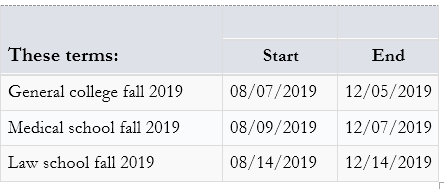


Terms starting and ending in different months: If your institution has terms that start or end in different months, please enter the terms separately.
Term: |
Start |
End |
General college spring 2023 |
01/2023 |
05/2023 |
Medical school spring 2023 |
01/2023 |
04/2023 |
Law school spring 2023 |
02/2023 |
05/2023 |
3) Provide Background Information
Finally, you will be asked some brief questions about your institution, such as the type(s) of Student Information System(s) (SIS) you use and how you define standard academic credits.
What Happens After Registration?
After you register, staff from RTI International, the data collection contractor, will contact you to confirm your due date for your enrollment list and provide detailed instructions for preparing the enrollment list file.
The enrollment list file will include the following information:
General and Demographic Information |
Enrollment Information |
Student name |
Degree program |
Student ID number |
Class level |
Social Security Number |
Major |
Date of Birth |
High school completion date |
Sex |
Dual enrollment in high school |
Ethnicity |
Date first enrolled in your institution |
Race |
First-time beginning student indicator |
Veteran/active duty military status |
|
Local address |
|
Permanent address |
|
E-mail address |
|
Phone number |
|
Once received, project staff will review your list to make sure it has all the necessary components. They may contact you if there are any questions about your list.
What Happens After You Submit Your Enrollment List?
After your enrollment list is accepted, your institution’s student sample will be selected. Project staff will contact you again, about 4 to 6 weeks after you submit your list, with instructions for providing student records data for the sampled students.
The NPSAS:24 Help Desk
The Help Desk is available, 9 AM to 8 PM ET, to answer your questions about NPSAS:24, troubleshoot technical issues, and discuss any obstacles to participation. Contact us at [number] or [email protected].
Registration Reminder Letter and E-mail
[Date]
[Salutation] [FirstName] [LastName]
[Title]
[Institution]
[Address]
[City], [State] [Zip]
Dear [Salutation] [LastName]:
I am writing to remind you that [Institution] has been selected for the 2023–24 National Postsecondary Student Aid Study (NPSAS:24) field test, and that you have been identified as your institution’s Campus Coordinator.
Your participation is very important! By participating in the field test, you will help us tailor our approach to NPSAS:24, which includes exploring ways to reduce burden on institutions, and therefore ensure a successful full-scale study.
Please log in to the Postsecondary Data Portal (PDP) and register your institution in our study data collection system at the website below.
PDP Website: surveys.nces.ed.gov/xxxx
Your User ID: [UserID]
If you have any further questions about the study, please contact us at [email protected], or [HelpDeskNumber].
Sincerely,
[RTI Contact Name and Title]
Coordinator List Request Mailing
This mailing is sent to each institution’s coordinator after the Registration Page has been completed. It includes a letter/email that confirms the institution’s due date for providing its student enrollment list and instructions for preparing the list. The letter and the instructions for this mailing are included below. |
Registration Thank You E-mail
Subject: NPSAS:24 Field Test Registration Completed
Dear [Salutation] [LastName]:
Thank you for completing the NPSAS:24 field test registration for [Institution]! This e-mail serves as a record that you have completed this task.
The next step in the study is submission of your 2022–23 Enrollment List. When this phase of the study begins, you will receive a request with instructions for completing this step.
We very much appreciate your participation in this important study!
List Request Letter and E-mail
[Date]
[Salutation] [FirstName] [LastName]
[Title]
[Institution]
[Address]
[City], [State] [Zip]
Thank you very much for registering for the 2023–24 National Postsecondary Student Aid Study (NPSAS:24) field test. We are pleased that [Institution] will participate in this important study, conducted by the U.S. Department of Education’s National Center for Education Statistics (NCES) and administered by RTI International.
Below is a summary of where you are in the study. The next step is providing your Student Enrollment List.
[Timeline graphic – see page D-42]
Your Student Enrollment List due date is: [DueDate].
Please contact us at [PortalHelpe-mail] or [PortalHelpNumber] if you would like to discuss this date.
Enclosed are instructions for providing the Student Enrollment List, which should include all eligible students enrolled in your institution between July 1, 2022 and [date]. This list will be used to create a sample of students for the Student Records portion of the study.
Postsecondary Data Portal Website: surveys.nces.ed.gov/xxxx
Your User ID: [UserID]
Thank you for your efforts in support of NPSAS:24. If you have questions about your participation, please contact [RTI Contact Name and Title], at [RTIe-mail]. I can be reached at [NCESe-mail].
Sincerely,
Jennifer Wine, Ph.D. NCES staff name
Director, NPSAS:24 NCES staff title
RTI International National Center for Education Statistics (NCES)
U.S. Department of Education
Enclosures
Student Enrollment List Preparation Instructions
The student enrollment list instructions will vary based on institutions’ term structures. Term-based institutions will be asked to provide a list of eligible students enrolled between July 1, 2022 and April 30, 2023. Continuous enrollment institutions will be asked to provide a list of eligible students enrolled between July 1, 2022 and December 31, 2022. Institutions will be asked to provide all data elements listed in the Student Enrollment List File Layout Specifications. If an institution states that it cannot provide all the requested data elements, data collection staff will work with the institution to agree to a reduced data element list on a case-by-case basis. |
Preparing Your Student Enrollment List for the NPSAS:24 Field Test
These instructions will guide you through preparing the list of students enrolled at your institution between July 1, 2022 and [date].
Step 1: Determine Which Students to Include
Your institution’s enrollment list should include students from all campuses, colleges, and schools, including graduate schools, reported to IPEDS under your institution’s IPEDS UNITID.
Provide a list of all eligible students enrolled at any time between July 1, 2022, and [date].
Some students may not be eligible for NPSAS; please carefully review the eligibility criteria below.
Eligible for the NPSAS:24 Field Test
Eligible students are those who, at any time between July 1, 2022 and [date], were enrolled in a term or course of instruction at your institution that is one of the following:
an academic program; OR
a course for credit that could be applied toward fulfilling the requirements for an academic degree;
an occupational or vocational program that requires at least 3 months or 300 clock hours of instruction to receive a degree, certificate, or other formal award;
noncredit remedial coursework within a Title IV eligible program (up to 30 semester or trimester hours, 45 quarter hours, or 900 clock hours).
NOT Eligible for the NPSAS:24 Field Test
Students are ineligible for the NPSAS:24 field test if they meet any of the following conditions. Exclude these students from your student enrollment list.
Refunded tuition. Exclude students who dropped out of your institution early enough to receive a full refund of their tuition.
Paid tuition solely to another institution. Exclude students who attend this institution under joint arrangements with another institution and pay tuition solely to the other institution.
Enrolled solely in a remedial program. Students who are enrolled solely in a remedial program are not eligible.
For additional help determining which students should be included on your enrollment list, see the Frequently Asked Questions section on page 3 of this document.
Step 2: Prepare the Student Enrollment List
Prepare your student enrollment list using one of the options provided.
Option A: Use the enrollment list template Excel file
Download the pre-formatted enrollment list Excel template file from the Postsecondary Data Portal (PDP) website and add your institution’s student enrollment list to the template.
Log in to the PDP website at [link].
From the Task Menu, select Provide Your Student Enrollment List and follow the on-screen instructions to download your template.
Option B: Create your own enrollment list file
Create your own enrollment list file, preferably as an Excel (.xls or xlsx) or comma-separated values (.csv) file, using the Student Enrollment List File Layout Specifications included on page 5 of this document.
Step 3: Check for Errors
Please take a moment and review your enrollment list file for errors. Examples of common errors found on student enrollment lists include:
1. Data elements are not associated with the correct student because rows shifted during sorting, merging files, or copying and pasting.
2. Required data elements are not provided for all students.
3. Eligible students are omitted from the list because they attend campus/school other than the main campus (e.g., law school, medical school).
Step 4: Submit Your Student Enrollment List
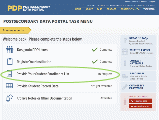
When you are ready to submit your list, log in to the PDP website at [link].
From the Task Menu, select Provide Your Student Enrollment List and follow the on-screen instructions to upload your list.
If you used the Excel template file, the PDP will check your file and notify you of any data errors.
If you created your own enrollment list file, the PDP will first check whether your file follows the file layout specifications. If it does, the PDP will check your file and notify you of any data errors. If it does not, a member of our team will review your file and contact you about any problems.
You will be asked to provide the following information:
1. Date the list was prepared: Please record the date your student list was prepared, even if it is not the same as the date you submit the list.
2. Contact information: Please provide the name, department, e-mail address, and phone number for all individuals responsible for preparing your list in case we have questions about the list.
3. Comments: Provide any details that will clarify the layout of the enrollment list you are submitting, as well as any information necessary to correctly interpret the data provided. Define any special codes or abbreviations (e.g., major codes, class levels).
4. Exclusion counts: Provide counts of the students that were excluded from your Student Enrollment List for the following reasons:
student did not meet the NPSAS eligibility requirements listed in Step 1
student requested that their information not be provided to external parties
student was excluded for any other reason.
To ensure data quality, the number of students submitted on your list will be compared to enrollment counts reported to IPEDS. Providing us with information about the number of excluded students will help to explain discrepancies and will expedite the processing of your list.
5. An estimate of how long it took your institution to prepare the student enrollment list.
Frequently Asked Questions
Should I include non-degree seeking students?
Yes. Non-degree seeking students should be included if they are enrolled in a course for credit that could be applied toward fulfilling the requirements for an academic degree.
Should I include students taking remedial courses?
It depends. Students who are taking noncredit remedial coursework within a Title IV eligible program are eligible and should be included. Students who are enrolled solely in a remedial program are not eligible and should not be included.
Should I include students at branch or extension campuses on the list?
Yes, if the branch or extension campus reports to IPEDS through the same IPEDS UNITID as the institution that was selected for NPSAS:24. If the branch or extension campus reports to IPEDS through a different IPEDS UNITID, do not include the students from the branch or extension campus on the student list.
Our law/dental/medical/veterinary school has its own registrar’s office. Should I include students from those schools on the list of enrolled students?
Yes, if the other registrar's office reports to IPEDS through the same IPEDS UNITID as the institution that was selected for NPSAS:24. If the other registrar's office reports to IPEDS using a separate IPEDS UNITID, then students registered by that office should not be included.
I understand that NPSAS is a financial aid study. Should I include students who did not apply for or did not receive financial aid?
Yes. NPSAS includes aided as well as non-aided students.
I understand that students on the list need to have been enrolled between July 1, 2022 and [date]. Does it matter if the student also had enrollment outside of that period?
No. A student is eligible as long as he or she was enrolled at any time between July 1, 2022 and [date] and meets the other eligibility criteria, regardless of whether he or she also had enrollment outside of that timeframe.
Should I include students who enrolled but later withdrew without completing any courses?
Include all eligible students who enrolled and paid their tuition and fees UNLESS they withdrew early enough to receive a full refund of their tuition and fees.
Should I include students taking courses on this campus when this is not the students' home institution?
No, do not include students on your enrollment list who pay their tuition solely to another institution. We consider students to be enrolled at the institution to which they pay their tuition.
Should I include...nonmatriculated students?
...non-degree seeking students? |
Yes, include these students on the list if they otherwise satisfy the student eligibility requirements on page 1. |
...part-time students? |
|
...postbaccalaureate students? |
|
...students taking correspondence courses? |
|
...distance education students? |
|
...foreign exchange students? |
|
...continuing education students? |
|
...extension division students? …incarcerated students? |
Note that students may be eligible for NPSAS:24 even if they are not in a formal degree program. For example, someone who is taking a credit-bearing computer programming course to enhance his or her job skills would be considered eligible and should be included on the enrollment list.
Should I include graduate students on the list if they were enrolled in a graduate program but were only auditing courses (e.g., because they did not need any more credits for graduation)?
Yes. Students enrolled in academic programs are eligible for this study, even if they are no longer enrolled in courses for credit.
Should I include international students on the student enrollment list?
Yes. International students should be included on the student enrollment list if they meet the other eligibility criteria. Note that study abroad students who are paying tuition to another institution are not eligible.
My institution uses different student degree program classifications than you request. How should I provide degree program?
If possible, please categorize your students within the student degree program categories that we request. However, if this is not possible, please classify the students as indicated in your institution's records and provide us with the definitions of these classifications. You can upload these classifications with your list, or e-mail them to [E-MAIL ADDRESS].
What should I do if I cannot provide students’ first names, middle initials, last names, and name suffixes as four separate fields?
When uploading your file on the website, let us know how your file is constructed by providing comments in the text box located on the upload page or in an e-mail to [E-MAIL ADDRESS].
What if my institution does not have student ID numbers separate from SSNs?
If your institution does not have separate student ID numbers, you can either leave the student ID field blank or use SSN in the student ID field and the SSN field.
What degree program should I report for students who are currently taking undergraduate courses but have previously earned a bachelor’s, master’s, or doctoral degree?
Report the student’s degree program based on their current courses/program of study and not on a past degree. In this example, the degree program should be reported as “Enrolled in undergraduate courses, not in a degree program.”
NPSAS:24 Field Test Student Enrollment List File Layout Specifications
These file specifications provide a list of the student enrollment list data elements that we are requesting and the valid values for each element.
If you choose to use the Excel template file, these data fields will appear in the template in the order listed below. When you upload, the PDP will check your file and notify you of any data errors.
If you choose to create your own file, we encourage you to follow these file layout specifications using an Excel (.xls or xlsx) or comma-separated values (.csv) file. If your file follows the specifications, the PDP will check your file and immediately notify you of any data errors. If your file does not follow the specifications, a member of our team will review your file and contact you about any problems.
Tips for successful file upload:
Use the Item Label values (e.g., VERSION, INSTID, STUDID) as a header row in your file. The header row will allow the PDP to check whether all the required data fields are provided.
Whenever possible, use the value codes listed in the specifications (e.g., 1=Yes, 0=No). If you use codes other than the valid values listed in the file layout specifications, please provide us with a detailed description of the codes.
If any of the requested elements do not apply to your institution, you may leave the field blank.
Field # |
Item Label |
Item Description |
RequiredData Item? |
Valid Values |
Notes |
|
|
VERSION |
File Specification Version Number |
Yes |
1 |
If you create your own files, enter “1” in the first column for each row. This value will tell the PDP website how to process your enrollment list file. |
|
|
INSTID |
IPEDS UNITID |
Yes |
|
|
|
|
STUDID |
Student ID |
|
|
|
|
|
FNAME |
First name |
Yes |
|
|
|
|
MNAME |
Middle initial |
|
|
|
|
|
LNAME |
Last name |
Yes |
|
|
|
|
SUFFIX |
Name suffix (e.g., Jr., Sr., III, etc.) |
|
|
|
|
|
SSN |
Social Security Number (SSN) |
Yes |
|
Enter the student's 9-digit SSN with no spaces or dashes. We will use SSNs to identify students that attend multiple institutions. We will also match students to the U.S. Department of Education's Central Processing System (CPS) database, which contains information from the Free Application for Federal Student Aid (FAFSA), the National Student Loan Data System (NSLDS), and other databases prior to selecting the student sample. Matching to these databases prior to sampling will help us to select a representative sample of students. |
|
|
DOBM |
Date of birth month (MM) |
Yes |
01-12 |
|
|
|
DOBD |
Date of birth day (DD) |
Yes |
01-31 |
|
|
|
DOBY |
Date of birth year (YYYY) |
Yes |
1932-2007 |
|
|
|
SEX |
Sex |
|
0 = Male 1 = Female 2 = Other -1 = Unknown |
|
|
|
VETERAN |
Veteran or Active Duty Military status |
|
0 = No 1 = Yes, veteran 2 = Yes, active duty military -1 = Unknown |
Please indicate whether the sample member is a veteran of the U.S. Armed Forces or is serving on active duty (not whether the sample member is receiving veteran's benefits). |
|
|
DUAL |
Student was solely a dual enrollment high school student or completing high school requirements? |
Yes |
1 = Yes, student was enrolled in high school between July 1, 2022 and April 30, 2023 0 = No, student was not enrolled in high school between July 1, 2022 and April 30, 2023 -1 = Unknown |
The purpose of this item is to identify students who are not eligible for NPSAS:24 field test because they were dually enrolled in high school or completing high school requirements for their entire period of enrollment at your institution in the July 1, 2022 to April 30, 2023 timeframe. Answer YES if the student was dually enrolled in high school or completing high school requirements for all enrollment at your institution within the July 1, 2022 to April 30, 2023 timeframe. Answer NO if the student was dually enrolled but completed high school and continued to be enrolled at your institution in a postsecondary course of study at any time between July 1, 2022 and April 30, 2023. |
|
|
HSCOMPM |
High school completion date month (MM) |
Yes |
|
|
|
|
HSCOMPD |
High school completion date day (DD) |
Yes |
|
|
|
|
HSCOMPY |
High school completion date year (YYYY) |
Yes |
|
|
|
|
ETHNICITY |
Ethnicity |
|
0 = Not Hispanic or Latino 1 = Hispanic or Latino -1 = Unknown |
If the student declined to provide his or her ethnicity or race, indicate “Unknown.”
Note that these ethnicity and race categories differ from those reported to IPEDS but are consistent with IPEDS requirements for the collection of ethnicity and race.
For more information about IPEDS requirements for the collection and reporting of ethnicity and race, visit https://surveys.nces.ed.gov/ipeds/visfaq_re.aspx#1. |
|
|
RACEW |
Race: White |
|
1 = Yes 0 = No -1 = Unknown |
If the student declined to provide his or her ethnicity or race, indicate “Unknown.”
Note that these ethnicity and race categories differ from those reported to IPEDS but are consistent with IPEDS requirements for the collection of ethnicity and race.
For more information about IPEDS requirements for the collection and reporting of ethnicity and race, visit https://surveys.nces.ed.gov/ipeds/public/hrsoc-browse/faq-re. |
|
|
RACEB |
Race: Black or African American |
|
1 = Yes 0 = No -1 = Unknown |
|
|
|
RACEAS |
Race: Asian |
|
1 = Yes 0 = No -1 = Unknown |
|
|
|
RACEAI |
Race: American Indian or Alaska Native |
|
1 = Yes 0 = No -1 = Unknown |
|
|
|
RACENH |
Race: Native Hawaiian or Pacific Islander |
|
1 = Yes 0 = No -1 = Unknown |
|
|
|
PMADD1 |
Permanent address 1 |
|
|
|
|
|
PMADD2 |
Permanent address 2 |
|
|
|
|
|
PMADDC |
Permanent city |
|
|
|
|
|
PMADDC |
Permanent state |
|
|
|
|
|
PMADDZ |
Permanent ZIP code |
|
|
|
|
|
PMADDCY |
Permanent country (if not U.S.) |
|
|
|
|
|
LADD1 |
Local/most recent address 1 |
|
|
|
|
|
LADD2 |
Local/most recent address 2 |
|
|
|
|
|
LADDC |
Local/most recent city |
|
|
|
|
|
LADDS |
Local/most recent state |
|
|
|
|
|
LADDZ |
Local/most recent ZIP code |
|
|
|
|
|
PHONE1 |
Phone number 1 |
|
|
Enter a valid 10-digit phone number with no spaces, parentheses, or dashes. |
|
|
TYPE1 |
Phone number 1 type |
|
1=Home 2=Mobile 3=Other |
|
|
|
PHONE2 |
Phone number 2 |
|
|
Enter a valid 10-digit phone number with no spaces, parentheses, or dashes. |
|
|
TYPE2 |
Phone number 2 type |
|
1=Home 2=Mobile 3=Other |
|
|
|
CAMEMAIL |
Campus e-mail |
Yes |
|
|
|
|
PERMEMAIL |
Permanent e-mail |
Yes |
|
|
|
|
FDATEM |
Date first enrolled at this institution (month) |
|
1 - 12 |
|
|
|
FDATED |
Date first enrolled at this institution (day) |
|
1 - 31 |
|
|
|
FDATEY |
Date first enrolled at this institution (year) |
|
1940 - 2023 |
|
|
|
EXPECT |
Expected to complete degree requirements before June 30, 2023? |
Yes |
0=No 1=Yes 2 = Does not apply -1=Unknown/unable to determine
|
Is the student expected to have completed the requirements for their current degree program on or before June 30, 2023? This item is used to identify potential eligible sample members for the Baccalaureate and Beyond Longitudinal Study. This item applies ONLY to students enrolled in bachelor’s degree programs. Completion of the requirements means all required classes have been taken and passed and sufficient credit or clock hours have been earned. Some students may not yet have been awarded their degree or certificate by the institution, even though the requirements have been completed. Enter “Does not apply” (2) if any of the following apply:
Enter “Unknown/unable to determine” (-1) if the student is enrolled in a bachelor’s degree program, but cannot state whether the student is likely to complete degree requirements by June 30, 2023. |
|
|
RECBACH |
Received Bachelor's Degree? |
|
1=Yes 0=No -1=Unknown |
Select Yes if the student has already obtained a bachelor's degree, even if it was not awarded by this institution. |
|
|
BACHDATEM |
Date Bachelor's Received (Month) |
|
1 - 12 |
If the student has obtained a bachelor's degree, enter the date the degree was received. If the student has not yet received a bachelor’s degree, leave this item blank. |
|
|
BACHDATED |
Date Bachelor's Received (Day) |
|
1 - 31 |
|
|
|
BACHDATEY |
Date Bachelor's Received (Year) |
|
1950 - 2023 |
|
|
|
PROGRAM |
Degree Program |
Yes |
1 = Enrolled in undergraduate courses, not in a degree program 2 = Undergraduate certificate or diploma (occupational or technical program) 3 = Associate's degree 4 = Bachelor's degree 5 = Enrolled in graduate courses, not in a degree program 6 = Post-baccalaureate certificate program 7 = Dual bachelor's/master's degree 8 = Master's degree program 9 = Post-master's certificate 10 = Doctoral degree - research/scholarship 11 = Doctoral degree - professional practice 12 = Doctoral degree – other -1 = Unknown |
In what degree program is this student enrolled? If the student is no longer enrolled, report the degree program for his or her last term enrolled.
If the student was enrolled in more than one program, enter the highest degree program. If the student was enrolled in a dual degree program in which both degrees are the same level (such as a dual MD/PhD or dual MA/MBA), respond based on the student’s primary degree program. |
|
|
CLASSLVL |
Class level |
Yes |
1 = 1st Year/Freshman 2 = Sophomore 3 = Junior 4 = Senior 5 = 5th Year or higher undergraduate 6 = Undergraduate (unclassified) 7 = Student with bachelor's or advanced degree taking undergraduate courses 8 = 1st year graduate 9 = Beyond 1st year graduate 10 = Graduate (unclassified) -1=Unknown |
Enter the student's class level. If the student is no longer enrolled, provide the student’s class level during his or her last term enrolled. If class level was used to determine financial aid eligibility, report that class level for this item. Otherwise, report the class level as defined by your institution. Institutions typically define class level based on the number of earned credits. An example of a commonly used classification: • 0-29 earned credit hours for first-year/freshman • 30-59 earned credit hours for sophomore • 60-89 earned credit hours for junior • 90+ earned credit hours for senior. |
|
|
MAJOR1 |
Student’s first major |
|
|
If your institution’s majors include codes or abbreviations, please include an explanation with your enrollment list. |
|
|
MAJOR1CIP |
Classification of Instructional Programs (CIP) code for student’s first major |
|
Format = NNNNNN (no decimal) |
The Classification of Instructional Programs (CIP) provides a taxonomic scheme that supports the accurate tracking and reporting of fields of study and program completions. The current taxonomy, CIP 2020, is preferred. For more information about the Classification of Instructional Programs, see https://nces.ed.gov/ipeds/cipcode/. |
|
|
MAJOR2 |
Student’s second major |
|
|
If your institution’s majors include codes or abbreviations, please include an explanation with your enrollment list. |
|
|
MAJOR2CIP |
Classification of Instructional Programs (CIP) code for student’s second major |
|
Format = NNNNNN |
|
|
|
PROGCLOCK |
Total Number of Clock Hours in Program |
Yes* |
|
If this student is enrolled in a clock hour program, what is the total length of the program in clock/contact hours? If the student is not enrolled in a clock hour program, leave blank.
*Required ONLY for institutions that award bachelor’s degrees and offer clock hour programs; if this does not apply to your institution, leave blank. |
|
|
CUMCLOCK |
Cumulative Clock Hours Completed |
Yes* |
|
Please provide the total cumulative clock hours earned by this student as of the date this list was prepared. Include all clock hours earned, even if they do not count toward the student’s degree/program requirements.
*Required ONLY for institutions that award bachelor’s degrees and offer clock hour programs; if this does not apply to your institution, leave blank. |
|
|
PROGCRED |
Total Number of Credit Hours in Program |
Yes* |
|
If this student is enrolled in a credit hour program, what is the total length of the program in credit/contact hours? If the student is not enrolled in a credit hour program, leave blank.
*Required ONLY for institutions that award bachelor’s degrees and offer credit hour programs; if this does not apply to your institution, leave blank. |
|
|
CUMCRED |
Cumulative Credit Hours Completed |
Yes* |
|
Please provide the total cumulative credit hours earned by this student as of the date this list was prepared. Include all credit hours earned, even if they do not count toward the student’s degree/program requirements.
*Required ONLY for institutions that award bachelor’s degrees and offer credit hour programs; if this does not apply to your institution, leave blank. |
List Request Reminder Letter and E-mail
[Date]
[Salutation] [FirstName] [LastName]
[Title]
[Institution]
[Address]
[City], [State] [Zip]
Dear [Salutation] [LastName]:
I am writing to remind you of the [upcoming/recently passed] due date for your Student Enrollment List. This portion of the 2023–24 National Postsecondary Student Aid Study (NPSAS:24) field test will allow us to draw a sample of students enrolled at [Institution] for inclusion in the Student Records and Student Interview portions of the study.
Your current due date is [DueDate].
Please log into the Postsecondary Data Portal (PDP) and submit your Student Enrollment List.
PDP Website: surveys.nces.ed.gov/xxxx
Your User ID: [UserID]
If you need to set a new due date, or you have any further questions about the study, please contact us at [email protected], or [HelpDeskNumber].
Sincerely,
[RTI Contact Name and Title]
List Thank You E-mail
Subject: NPSAS:24 Field Test Enrollment List Submitted
Dear [Salutation] [LastName]:
Thank you for submitting the NPSAS:24 field test Student Enrollment List for [Institution]! This e-mail serves as a record that you have completed this task. We may contact you shortly if there are any questions about your file.
The next step in the study is submission of your student records data. When your institution’s student sample is selected, you will receive a request with instructions for completing this step.
We very much appreciate your participation in this important study!
[RTI Contact Name and Title]
Other Contact Materials
Registration/List Collection Is Ending Mailer and Email
NPSAS Registration/List Collection is coming to an end…
…and we need your participation.
We are moving into the next phase of the NPSAS:24 field test. So that [Institution] can move to the next phase as well, please log in to the Postsecondary Data Portal (PDP) and [complete the NPSAS:24 field test registration/submit your student enrollment list] at your earliest convenience.
By participating in the field test, you will help us tailor our approach to NPSAS:24, which includes exploring ways to reduce burden on institutions, and therefore ensure a successful full-scale study.
Please log in to the Postsecondary Data Portal (PDP) and [register your institution/submit a student enrollment list] at your earliest convenience.
PDP Website: surveys.nces.ed.gov/xxxx
Your User ID: [UserID]
If you need to set a new due date, or you have any further questions about the study, please contact us at [email protected], or [HelpDeskNumber].
Sincerely,
[RTI Contact Name and Title]
Final Weeks of List Collection E-mail – From NCES
Dear [Salutation] [LastName]:
I am e-mailing to encourage your institution’s participation in the 2023–24 National Postsecondary Student Aid Study (NPSAS:24) field test. The last day to provide a student enrollment list and be included in the study is [EndDate]. NPSAS:24 is conducted by the National Center for Education Statistics (NCES) under a congressional mandate to gather information from postsecondary institutions on how students and their families finance college. Your participation is important to making this study a success.
NPSAS data play a key role in evaluating the effectiveness of federal financial aid programs in meeting the needs of students. NPSAS data are cited in journal and newspaper articles, foundation policy briefs, and a wide array of other publications and reports, and are focused on a variety of topics, including financial aid use and debt accumulation, education outcomes, and the changing demographics of today’s students. We want to make sure these data accurately represent, and are available to, institutions like yours. Participation in the field test will go a long way toward ensuring NPSAS:24 is a success.
We try to accommodate institutions’ individual needs whenever possible, and we do have some flexibility in certain aspects of the study. To discuss this, or if you have any questions about your participation in, please contact the NPSAS Project Director, Dr. Jennifer Wine, at [PhoneNumber] or via e-mail at [e-mailAddr]. If you have any comments or general feedback that you would like to provide to NCES about this data collection, please contact me at [PhoneNumber] (e-mail address: [e-mailAddr]).
Please let us know how we can assist you. Thank you again for your cooperation and interest.
Please log on and provide data at: https://surveys.nces.ed.gov/xxxx Your
user name: «UserID» If
you do not recall your password, click Forgot Password. 
NCES staff person
NCES staff title
National Center for Education Statistics (NCES)
Institute of Education Sciences
U.S. Department of Education
.
Postsecondary Data Portal Login Instructions
These instructions will be sent to institutions that have difficulty with the login process on an as-needed basis. |
In order to safeguard all data transmitted between your institution and NCES, we use a secure HTML website with two-factor authentication. This site is called the Postsecondary Data Portal (PDP) and can be accessed at surveys.nces.ed.gov/xxxx. Below are instructions on how to access the Portal and what to do if you are unable to gain access.
1) Go to the PDP website and enter your User ID.
You can find your User ID in the letter or E-mail we sent to you. If you cannot find that letter or e-mail, please contact our HelpDesk at xxx-xxx-xxxx and we will send your User ID to the e-mail address associated with the account. Once you have entered your User ID, click “Continue”.
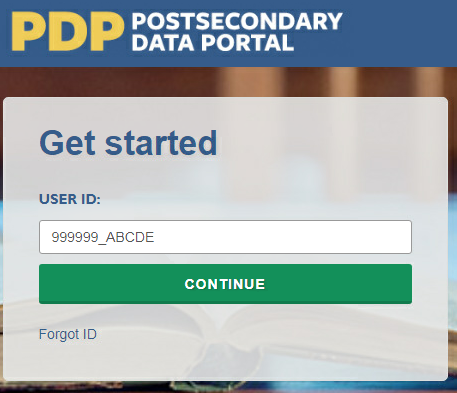
2) Create a Password (First Time Users)
The first time you access the PDP, you will need to create a password. You will also be prompted to create a new password every 60 days. Should you forget your password, you will be able to set a new password using the “Forgot Password” link. Below are the specifications for creating a password that the system will accept.
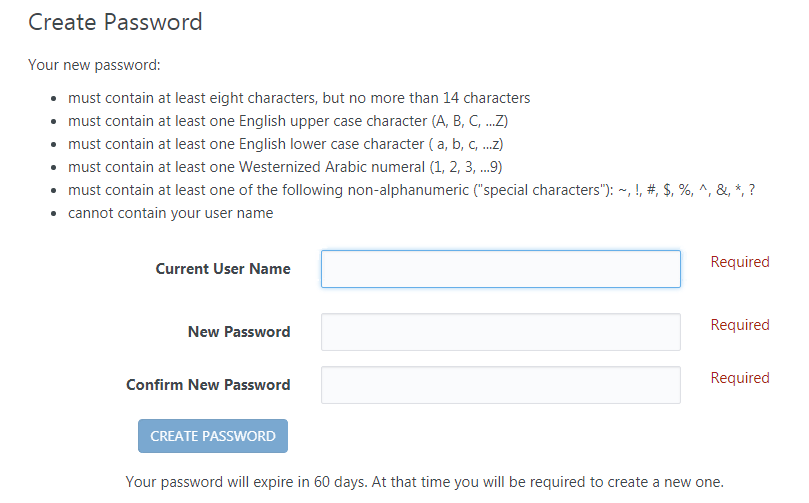
3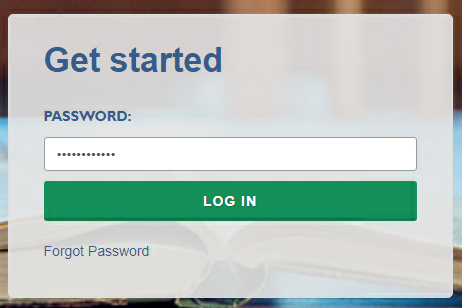 ) Complete
Two-Factor Authentication
) Complete
Two-Factor Authentication
After you create your password the first time, it will be valid for 60 days. The next step is to enter your password when prompted, and click “Log In”.
Entering the correct password will prompt the system to send a code via e-mail to the e-mail address associated with your User ID. It will come from the address [email protected]. This e-mail can take up to 10 minutes to arrive in your inbox, depending on your institution’s e-mail system. If you do not see it in your main inbox, please check any alternative inboxes you may have (“Other” inbox in Outlook, “Promotions” inbox in Gmail, etc.), as well as your Spam folder. If you still do not see the e-mail, please contact our Help Desk at xxx-xxx-xxxx or [helpdesk e-mail].

Thank you for beginning the log-in process at the NCES Postsecondary Data Portal (PDP) Website. Please enter the 6-digit security code shown below on the website to finish logging in. The code expires in 30 minutes.
123456
Enter the code provided in the e-mail when prompted, and you will be logged into the PDP.
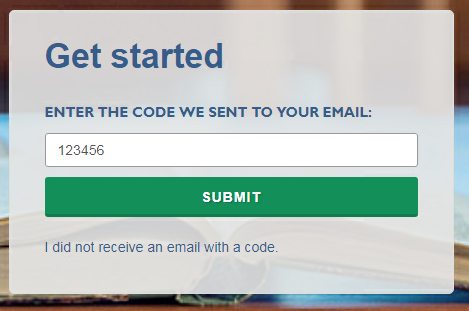
NPSAS Study Timeline Graphic
The timeline graphics below will be used throughout the contact materials, PDP website text, instructions, and materials included in this appendix. “[Timeline graphic]” is used throughout the materials to indicate where the images will be inserted. The graphic will be updated throughout collection based on the intended audience for the materials (Chief Administrator or Campus Coordinator) and the institutions’ current step in the data collection process. The two examples below illustrate how the timelines will appear and how they will be updated throughout data collection. |
Example A: Initial timeline sent to Campus Coordinators.
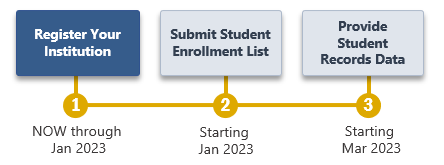
Example B: Timeline sent to Campus Coordinators with the enrollment list request materials, after the initial steps have been completed.
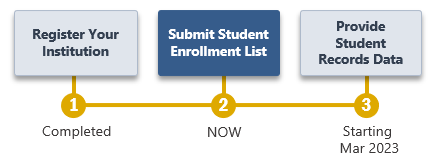
PDP Website Content – Pre-Login (Not Study Specific)
The Postsecondary Data Portal (PDP) is the web-based data collection system for all NCES sample studies that collect data from postsecondary institutions. The sections of the website that are accessible prior to login include generic information about NCES postsecondary studies and the PDP itself, including answers to frequently asked questions. The content of these pages is included below. Study-specific information that is available after login is included in the next section. |
Home page
The PDP website hosts data collection for multiple studies, and therefore some information may be added or removed as studies that use the PDP begin and end. This content includes the list of studies, their OMB numbers, and time estimates; links to the NCES websites for each study; and the list of contact persons.
Before a study is added, revisions and additions to the portal’s content will be submitted to OMB for review as part of the study’s clearance request; the website will be changed after the request is approved.
Page Header
About the PDP
PDP FAQs
Contact Us
Confidentiality
Login Area
Get Started
USERID __________
Forgot ID? Click Send User ID below to have your user ID sent to the e-mail address that you enter. Otherwise, click Cancel.
E-mail Address: __________________________________
Studies That Use the PDP
National Postsecondary Student Aid Study – Learn more <link to NCES website for NPSAS>
Baccalaureate & Beyond Longitudinal Study – Learn more <link to NCES website for B&B>
Beginning Postsecondary Students Longitudinal Study – Learn more <link to NCES website for BPS>
High School Longitudinal Study of 2009 – Learn more <link to NCES website for HSLS:09>
[DataLab logo] DataLab – Learn more <link to https://nces.ed.gov/datalab/>
PRA Statement
NCES is authorized to conduct these studies by the Education Sciences Reform Act of 2002 (ESRA 2002, 20 U.S.C. §9543) and the Higher Education Opportunity Act of 2008 (HEOA 2008, 20 U.S.C. §1015). The data are being collected for NCES by RTI International, a U.S.-based nonprofit research organization. All of the information you provide may be used only for statistical purposes and may not be disclosed, or used, in identifiable form for any other purpose except as required by law (20 U.S.C. §9573 and 6 U.S.C. §151).
The Family Educational Rights and Privacy Act of 1974 (FERPA, 20 U.S.C. §1232g) allows for the release of institution record information to the Secretary of Education or his agent without prior consent of survey members (34 CFR §§ 99.31(a)(3)(iii) and 99.35).
According to the Paperwork Reduction Act of 1995, no persons are required to respond to a collection of information unless it displays a valid OMB control number. The valid OMB control numbers for the voluntary information collections using this website are listed below. The time required to complete the information collections is estimated to average the number of hours listed below per response, including the time to review instructions, search existing data sources, gather the data needed, and complete and review the information collection.
If you have any comments concerning the accuracy of the time estimate, suggestions for improving the collections, or any comments or concerns regarding the status of your individual submission of these data, please write directly to: Postsecondary Data Portal studies, National Center for Education Statistics, PCP, 550 12th St., SW, Room 4007, Washington, DC 20202.
NPSAS:24 List Collection: X hours
Header
<Link to https://nces.ed.gov/>
About the PDP
About this website
The Postsecondary Data Portal (PDP) is the data collection website for all NCES institution-based postsecondary sample surveys. The PDP reduces the time it takes to respond to NCES data requests and makes the data submission process as simple and straightforward as possible.
Benefits of the PDP include the following:
Centralization. It is a central hub for uploading postsecondary institution data for all NCES sample studies.
Continuity. Future data requests will remain as static as possible, and reports or programs you create to provide the data can be updated minimally to complete future requests.
Security. Data are secured through password-protected access and Secure Sockets Layer (SSL) encryption.
Tools at Your Fingertips. You can access DataLab, our powerful, easy-to-use suite of online data analysis tools that includes more than 30 federal education datasets.
Any data released to the public will be in aggregate form (e.g., statistical tables, graphs). Review the FAQs or log in to learn more about confidentiality and data security on the PDP. Background information on each study can be accessed from the Home page.
The Education Sciences Reform Act of 2002 (ESRA 2002, 20 U.S.C. §9543) and the Higher Education Opportunity Act of 2008 (HEOA 2008, 20 U.S.C. §1015) authorize NCES to collect and disseminate information about education in the United States. NCES is the primary federal statistical entity for collecting and analyzing data related to education in the U.S. and other nations. NCES is located within the Institute of Education Sciences of the U.S. Department of Education. NCES fulfills a Congressional mandate to collect, collate, analyze, and report complete statistics on the condition of American education; conduct and publish reports; and review and report on education activities internationally.
NCES has contracted with RTI International to administer the studies included on this website. RTI is an independent, nonprofit contract research organization located in Research Triangle Park, NC, that was established by a joint action of three major universities in North Carolina: University of North Carolina at Chapel Hill, North Carolina State University, and Duke University. RTI began operations in 1958 and has provided contract support to NCES on postsecondary research dating back to 1971.
Annually, NCES also conducts a system of interrelated surveys entitled the Integrated Postsecondary Education Data System (IPEDS) through a different website. IPEDS gathers information from every college, university, and technical and vocational institution that participates in the federal student financial aid programs. IPEDS data are made available to students and parents through the College Navigator college search website and to researchers and others through the IPEDS Data Center.
FAQs (prior to log-in)
These FAQs are available from the PDP home page before the user logs in.
Who is collecting these data?
The National Center for Education Statistics (NCES), part of the U.S. Department of Education's Institute of Education Sciences, conducts the studies listed on the Home page of this website. NCES, the primary federal statistical entity for collecting and analyzing data related to education in the U.S. and other nations, contracts with RTI International to collect data for these studies. RTI International is an independent, nonprofit research organization based in the Research Triangle of North Carolina.
By what authority does NCES collect this information?
NCES is authorized by Congress to conduct these studies in the Education Sciences Reform Act of 2002 (ESRA 2002, 20 U.S.C. §9543) and the Higher Education Opportunity Act of 2008 (HEOA 2008, 20 U.S.C. §1015). Each study has been approved by the U.S. Office of Management and Budget (OMB).
How was my institution selected?
For the National Postsecondary Student Aid Study (NPSAS), institutions are sampled from all Title IV institutions included in the Integrated Postsecondary Education Data System (IPEDS), a repository of data on all Title IV institutions.
Why is participation important?
The National Postsecondary Student Aid Study (NPSAS) is the primary source of data used by federal government agencies and higher education associations to analyze the effectiveness of current federal student financial aid programs. NPSAS provides comprehensive data on postsecondary students’ enrollment status, education goals, employment, and demographic characteristics. Many agencies and organizations, including the U.S. Department of Education, the Congressional Budget Office (CBO), the Government Accountability Office (GAO), the Office of Management and Budget (OMB), the American Council on Education (ACE), the National Association of Independent Colleges and Universities (NAICU), and the National Association of Student Financial Aid Administrators (NASFAA) use NPSAS data to prepare reports that influence the direction of federal student aid policies.
NPSAS also serves as the base year study for two longitudinal postsecondary studies, the Beginning Postsecondary Students Longitudinal Study (BPS) and the Baccalaureate and Beyond Longitudinal Study (B&B). These studies follow students over time and capture both education and employment outcomes for postsecondary students across the nation. The combination of data collected by these studies allows for analyses of the important links between the cost of postsecondary education, financial aid burden, academic performance, and employment and financial outcomes over time.
The data collected through the studies are used by researchers, policymakers, and administrators to analyze and nationally benchmark information about current postsecondary students; to analyze national trends over time; and to inform decisions about postsecondary education at the institutional, state, and national levels.
Participation of each sampled institution is critical to the success of the study. Full participation assures that the data used accurately represent students attending all different types of postsecondary institutions in the United States.
Do we need to have the student's permission before providing this information?
No. Student or parental consent is not required for release of student record information for the purposes of these studies. The data request for NPSAS fully conforms to the requirements of the Family Educational Rights and Privacy Act of 1974 (FERPA). FERPA, under provision of 34 CFR §§ 99.31(a)(3)(iii) and 99.35, permits institutions to disclose without consent individual student education records to NCES, as an authorized representative of the Secretary of Education, in connection with an evaluation of federally supported education programs. Student data are subject to strict protections that are adhered to by NCES and its contractor organizations. You can review this regulation on the U.S. Department of Education's website at https://www2.ed.gov/policy/gen/reg/ferpa.
FERPA regulations also stipulate that all disclosures be reported in the student record, with an indication of who received the information and their legitimate interests in the information. For schools without electronic student record systems, a Disclosure Notice can be printed from the Resources page of this website. These notices fulfill the requirements of 34 CFR 99.32(a) pursuant to the Family Educational Rights and Privacy Act (20 U.S.C. §1232g). Electronic student record systems will require the insertion of a similar statement. The Resources page also includes a FERPA Fact Sheet, which includes more information about how NPSAS conforms to FERPA requirements.
Are the collected data kept secure and confidential?
Both NCES and RTI International follow strict procedures to protect study participants’ information. For more information on confidentiality and data security see surveys.nces.ed.gov/xxxx/Home/Confidentiality.
What assistance is available from RTI staff?
The Help Desk at RTI International is available to answer your questions about the studies and navigating this website. Please call 1-XXX-XXX-XXXX or e-mail [E-MAIL ADDRESS] with your questions or concerns. Help Desk staff are available Monday to Friday from 9 AM to 8 PM ET.
Contact Us
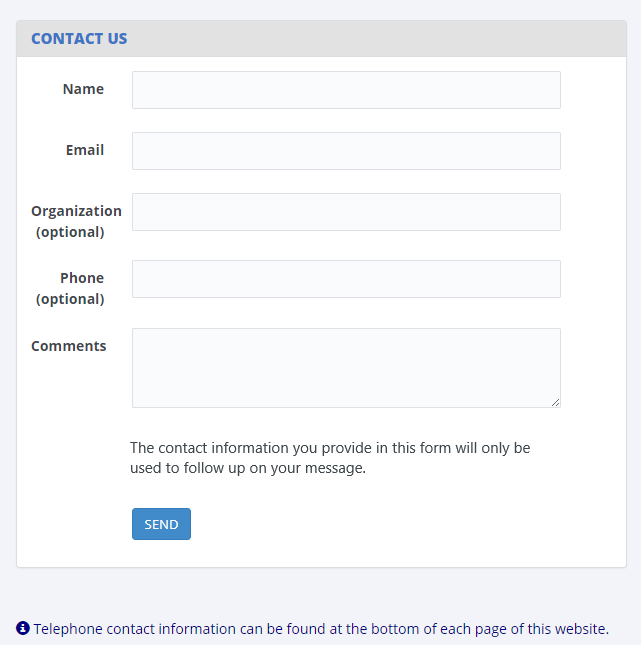
Confidentiality
Confidentiality and Data Security
All of the information provided as part of NCES sample studies may be used only for statistical purposes and may not be disclosed, or used, in identifiable form for any other purpose except as required by law (20 U.S.C. §9573 and 6 U.S.C. §151). Any student data released to the general public (for example, in statistical tables) are formatted so that it is not possible to identify specific individuals.
Specific measures have been taken to protect data submitted through this website:
Data are collected over a secure server and connection, protected by Secure Sockets Layer technology (SSL; 128-bit encryption). A unique study identification variable (not the Social Security number or institution student ID) are created and maintained for each sampled student to protect against inadvertent disclosure of confidential data.
All electronic data are secured in protected data files, and personally identifiable information (PII) is stored in files separate from the descriptive information. The data are stored securely on an Enhanced Security Network, which is certified and accredited as a NIST moderate security level network. NCES and RTI employ strict procedures for the transfer of PII; maintenance, storage, and use of direct identifiers; replacement of direct identifiers with internal codes; security of master survey files; and reporting of data security breaches in accord with the U.S. Department of Education Incident Handling Procedures. For more information on NIST security level, please see FIPS Publication 199 at https://nvlpubs.nist.gov/nistpubs/FIPS/NIST.FIPS.199.pdf.
All NCES staff and contractors are subject to severe fines and possible imprisonment for disclosing individual responses.
All RTI project staff members have signed Confidentiality Agreements and Affidavits of Nondisclosure and are prohibited by law from using the obtained information for any purposes other than this research study.
Data security procedures are reviewed and approved by NCES data security staff.
Confidentiality and data security protection procedures have been put in place for the studies accessible through this website to ensure that the contractor and its subcontractors comply with all privacy requirements, including:
1. The statement of work of each contract;
2. Family Educational Rights and Privacy Act (FERPA) of 1974 (20 U.S.C. §1232(g));
3. Privacy Act of 1974 (5 U.S.C. §552a);
4. Privacy Act Regulations (34 CFR Part 5b);
5. Computer Security Act of 1987;
6. U.S.A. Patriot Act of 2001 (P.L. 107-56);
7. Education Sciences Reform Act of 2002 (ESRA 2002, 20 U.S.C. §9573);
8. Cybersecurity Enhancement Act of 2015 (6 U.S.C. §151);
9. Foundations of Evidence-Based Policymaking Act of 2018, Title III, Part B, Confidential Information Protection;
10. The U.S. Department of Education General Handbook for Information Technology Security General Support Systems and Major Applications Inventory Procedures (March 2005);
11. The U.S. Department of Education Incident Handling Procedures (February 2009);
12. The U.S. Department of Education, ACS Directive OM: 5-101, Contractor Employee Personnel Security Screenings;
13. NCES Statistical Standards; and
14. All new legislation that impacts the data collected through the contract for this study.
The data collection contractor complies with the U.S. Department of Education’s IT security policy requirements as set forth in the Handbook for Information Assurance Security Policy and related procedures and guidance, as well as IT security requirements in the Federal Information Security Management Act (FISMA), Federal Information Processing Standards (FIPS) publications, Office of Management and Budget (OMB) Circulars, and the National Institute of Standards and Technology (NIST) standards and guidance. All data products and publications will also adhere to the NCES Statistical Standards, as described at the website: https://nces.ed.gov/statprog/2012 /.
PDP Website Content – After Login
This section includes content of the Postsecondary Data Portal (PDP) that is available to users after logging in to the website. The post-login webpages are customized based on the study or studies for which the institution has been sampled. The Task Menu, Designate a Coordinator, and Designate PDP Users pages are used for all studies that collect data through the PDP. The remaining pages in this section are specific to the NPSAS:24 enrollment list collection. The content of these pages, included below, was based primarily on the materials developed and approved for NPSAS:20 (OMB #1850-0666). |
Welcome Page
Welcome to NPSAS:24! This page provides an overview of what to expect during NPSAS:24. [You can view this page any time by clicking What to Expect in the Help Menu at right.]
Announcements
This section will be used to post announcements on the PDP during data collection, if needed. Content of these announcements may include upcoming website maintenance or updates about technical problems with the PDP (such as bug fixes).
What to Expect During the NPSAS:24 Field Test
The Introduction to NPSAS:24 Video (right) introduces what to expect during NPSAS:24 and the resources available to you on the Postsecondary Data Portal website.
[NPSAS:24 Overview Video]
NPSAS:24 Field Test Timeline
[Graphic depicting steps in NPSAS:24 data collection – see page D-42]
As an institution participating in the NPSAS:24 Field Test, you will be expected to complete the following steps during the 2022-23 academic year:
1. Register Your Institution – starting October 2022
Designate staff who will provide your institution’s data, specify your institution’s term structure, and answer some brief background questions about your institution.
2. Provide Your Student Enrollment List – starting [date]
Submit a list of all students enrolled at your institution between July 1, 2022 and April 20, 2023 (July 1, 2022 to December 31, 2022 for continuous enrollment institutions). The due date for providing your list will vary based on your institution’s term structure.
3. Provide Student Records Data – starting March 2023
Submit additional information for the students at your institution who are sampled for the NPSAS:24 field test. The student records data includes demographic, enrollment, budget, and financial aid information. You will receive your list of sampled students approximately 2 to 4 weeks after you submit your student enrollment list.
You can view this page any time by clicking “What to Expect” in the Help Menu at right.
Task Menu
The Task Menu displays a checklist of items that the institution completes to provide data. The specific items that appear on the Task Menu are customized for each study. The Task Menu below shows an example for an institution that has been selected for NPSAS:24 only. There are currently no planned data collections that will overlap with NPSAS:24.
Welcome back! Please complete the steps below.
Designate a Coordinator
Register Your Institution
Provide Your Student Enrollment List
Provide Student Record Data
Archive Notes or Other Documentation
Designate A Coordinator Page
[For institutions with no pre-filled coordinator:] Please provide the name and contact information for the person who will serve as your institution’s Campus Coordinator for the NPSAS:24 field test. We will follow up with the Coordinator to provide instructions and upcoming deadlines.
[For institutions with a pre-filled coordinator:] The last time your institution participated in NPSAS, the person listed below served as your Campus Coordinator. If this person should continue to serve as coordinator for the NPSAS:24 field test, review and correct the information as needed. If you wish to name a new Coordinator, update the information below.
When you are finished, click Submit at the bottom of this page.
Please note that we need a 'FedEx-friendly' address - no PO Box addresses, please!
Campus Coordinator
Salutation |
|
|
Name |
|
|
Title |
|
|
Department |
|
Select the option that most closely matches the Campus Coordinator’s department at your institution. |
Address |
|
|
Telephone |
|
|
|
|
|
Alternate e-mail |
|
|
Registration Page
On this page, institutions will be asked to confirm their term structure or provide terms for the 2022-23 NPSAS year. Institutions will receive a subset of these of items depending on whether (1) their term structure was preloaded into the PDP, (2) whether they are a continuous enrollment institution, and (3) whether the institution is set up as a reporter institution (i.e., the institution will provide data via a central contact person for several campuses/schools in the NPSAS study). |
DESIGNATE (All institutions)
Please confirm your contact information and provide information for any additional staff who will assist you with providing your institution’s data for NPSAS:24. Over the course of the NPSAS:24 Field Test, you will be asked to provide the following:
Information about your institution’s term structure.
A list of all students enrolled at your institution between July 1, 2022 and [date].
Student records data, which includes demographic, enrollment, budget, and financial aid, for a subset of your students.
Each person you designate will receive credentials for logging into the Postsecondary Data Portal website. Please be sure that the users you identify are allowed to see personal information about students. You may need to designate staff from multiple departments at your institution.
You cannot delete the Campus Coordinator user account until you designate another person to be the Campus Coordinator.
Campus Coordinator (User 1)
Salutation |
[Coordinator salutation] |
|
Name |
[Coordinator name] |
|
Title |
[Coordinator title] |
|
Department |
[Coordinator department] |
Select the option that most closely matches this user’s department at your institution. |
Address |
[Coordinator address] |
|
Telephone |
[Coordinator telephone] |
|
[Coordinator e-mail] |
|
|
Alternate e-mail |
|
|
Campus Coordinator? |
Yes/No |
|
Should be copied on e-mails about NPSAS:24? |
Yes/No |
|
[ADD USER]
User 2 |
|
|
Salutation |
|
|
Name |
|
|
Title |
|
|
Department |
|
Select the option that most closely matches this user’s department at your institution. |
Address |
|
|
Telephone |
|
|
|
|
|
Alternate e-mail |
|
|
Campus Coordinator? |
Yes/No |
|
Should be copied on e-mails about NPSAS:24? |
Yes/No |
|
You can add users any time by selecting “Manage PDP Users” from the right-hand menu.
[ADD USER] [DELETE USER] [APPROVE USER]
REGINST (All institutions)
As a reminder, participating in NPSAS:24 involves a few steps.
[Timeline graphic – see page D-42]
Next you will designate your PDP users and register your institution to participate in NPSAS:24. This step will involve answering some brief questions about your institution and providing information about your institution’s term structure.
Before you begin, watch this brief video that walks you through the registration process.
[Registration page video]
INSTNAME (All institutions)
Our records indicate that the name of your institution is <name>.
Is that correct?
1 = Yes
0 = No
If no, please enter the correct name of your institution: _______________
TERMINST (All institutions)
When you provide student records data, you will be asked to report each sampled student’s enrollment status (such as full-time or half-time) for the period of July 1, 2022 to June 30, 2023. You will also be asked about students’ tuition, budget, and financial aid during this period. To collect this information, we need to know about your institution’s term structure.
If your institution has distinct terms with explicit start and end dates, you should report students’ enrollment information by term.
If your institution enrolls students continuously throughout the year, or if you have more than 12 terms per year, you should report students’ enrollment information by month.
REPORTTERM (For Reporter institutions only)
Click here to review the list of institutions selected for the NPSAS:24 Field Test.
Do all these institutions have the same term structure? For example,
Do all these institutions enroll continuously throughout the year?
Do all of these institutions have explicit terms with the same start and end dates?
1 = All institutions are on the same schedule
2 = Some institutions have different schedules
REPORTDIFF (For Reporter institutions only)
Thank you. We will contact you to discuss the best way to report enrollment status for your sampled students.
CONTCONF (For institutions that are preloaded as continuous enrollment institutions)
As a reminder, when you provide student records data, to report each sampled student’s enrollment status (such as full-time or half-time) between July 1, 2022 and June 30, 2023. To collect this information, we need to learn about your institution’s term structure.
Our records indicate that your institution offers continuous enrollment for your students, rather than terms with explicit start and end dates. Is this correct?
1 = Yes
0 = No
TERMCONF (For institutions with terms preloaded)
Our records indicate that your institution has the following terms for the July 1, 2022 to June 30, 2023 academic year.
As a reminder, when you provide student records data, you will be asked to indicate students’ enrollment status for each of these terms. You will also be asked about students’ tuition, budget, and financial aid for this period.
[Term name] |
[start date] |
[end date] |
[academic year] |
[Term name] |
[start date] |
[end date] |
[academic year] |
[Term name] |
[start date] |
[end date] |
[academic year] |
[Term name] |
[start date] |
[end date] |
[academic year] |
[Term name] |
[start date] |
[end date] |
[academic year] |
[Term name] |
[start date] |
[end date] |
[academic year] |
Are these terms correct? To review the instructions about which terms should be included, click here.
1= Yes, these terms are correct
2 = No, I need to revise these terms
3 = No, my institution has continuous enrollment
BENRTYPE (For institutions with no term information preloaded)
As a reminder, when you provide student records data, you will be asked to report each sampled student’s enrollment status (such as full-time or half-time) for the period of July 1, 2022 to June 30, 2023. You will also be asked about students’ tuition, budget, and financial aid during this period.
Please indicate whether you will report students’ enrollment status by term or by month. If you are not sure which to choose, contact our Help Desk at [number].
Report by term. Provide term names and dates for each term in the July 1, 2022 to June 30, 2023 timeframe. For details about which terms should be included, review Step 4 below.
Report by month. Report enrollment status for each calendar month within the academic year. Recommended for institutions that enroll continuously throughout the academic year, or for institutions with more than 12 terms in the academic year.
1 = Report Enrollment Status by Term
2 = Report Enrollment Status by Month
PROVTERM (For institutions with no term information preloaded)
Enter the name, start date, end date, and academic year of each of the terms/enrollment periods occurring at <institution name> in the July 1, 2022 to June 30, 2023 timeframe. For each term, indicate the academic year as defined by your institution’s academic calendar. Terms may start prior to July 1, 2022 or end after June 30, 2023, but some portion of the term must occur between July 1 and June 30.
Please include:
Summer sessions.
Short sessions longer than two weeks in duration (e.g., Maymester, January term).
Terms for special types of students (e.g. medical students).
How to report summer sessions: Summer sessions should be included if any portion of the term falls in the period of July 1, 2022 through June 30, 2023. For institutions with summer terms that cross the June 30/July 1 cutoff (sometimes called “crossover terms”), two years of summer sessions will fall in the July 1, 2022 to June 30, 2023 timeframe. If this is the case, please report both years of summer sessions and indicate the academic year for each term as defined by your institution’s academic calendar.
How to report overlapping terms: If your institution has more than one term that starts and ends in the same month, you only need to report the term one time. For example, if the general college and medical school both have fall semesters that start in August and end in December, you need only provide one fall semester, even if they don’t start on the same days of the month. If the terms start or end in different months, please provide the terms separately. For additional help, click here.
[Term name] |
[start date] |
[end date] |
[academic year] |
Remove |
[Term name] |
[start date] |
[end date] |
[academic year] |
Remove |
[Term name] |
[start date] |
[end date] |
[academic year] |
Remove |
[Term name] |
[start date] |
[end date] |
[academic year] |
Remove |
[Term name] |
[start date] |
[end date] |
[academic year] |
Remove |
[Term name] |
[start date] |
[end date] |
[academic year] |
Remove |
If multiple terms share the same start and end month, you can save time by only entering that term once.
The following sessions may be reported as a single term because they start and end in the same month:
Term Name |
Start Date |
End Date |
General college fall 2022 |
08/07/2022 |
12/05/2022 |
Medical school fall 2022 |
08/09/2022 |
12/07/2022 |
Law school fall 2022 |
08/14/2022 |
12/14/2022 |
The following sessions should be reported as separate terms because they start and end in different months:
Term Name |
Start Date |
End Date |
General college spring 2023 |
01/22/2023 |
05/05/2023 |
Medical school spring 2023 |
01/09/2023 |
04/28/2023 |
Law school spring 2023 |
02/04/2023 |
05/14/2023 |
Once you finalize, you will not be able to change these terms without assistance from NPSAS staff. Be sure your term structure is accurately reflected on this page before finalizing your Registration. If you need assistance, please contact the Help Desk.
REVTERM (For institutions with term information preloaded)
Please revise your institution’s terms/enrollment periods occurring at <institution name> in the July 1, 2022 to June 30, 2023 timeframe. For each term, indicate the academic year as defined by your institution’s academic calendar. Terms may start prior to July 1, 2022 or end after June 30, 2023, but some portion of the term must occur between July 1 and June 30.
Please include:
Summer sessions.
Short sessions longer than two weeks in duration.
Terms for special types of students (e.g. medical students).
How to report summer sessions: Summer sessions should be included if any portion of the term falls in the period of July 1, 2022 through June 30, 2023. For institutions with summer terms that cross the June 30/July 1 cutoff (sometimes called “crossover terms”), two years of summer sessions will fall in the July 1, 2022 to June 30, 2023 timeframe. If this is the case, please report both years of summer sessions and indicate the academic year for each term as defined by your institution’s academic calendar.
How to report overlapping terms: If your institution has more than one term that starts and ends in the same month, you only need to report the term one time. For example, if the general college and medical school both have fall semesters that start in August and end in December, you need only provide one fall semester, even if they don’t start on the same days of the month. If the terms start or end in different months, please provide the terms separately. For additional help, click here.
[Term name] |
[start date] |
[end date] |
[academic year] |
Remove |
[Term name] |
[start date] |
[end date] |
[academic year] |
Remove |
[Term name] |
[start date] |
[end date] |
[academic year] |
Remove |
[Term name] |
[start date] |
[end date] |
[academic year] |
Remove |
[Term name] |
[start date] |
[end date] |
[academic year] |
Remove |
[Term name] |
[start date] |
[end date] |
[academic year] |
Remove |
If multiple terms share the same start and end month, you can save time by only entering that term once.
The following sessions may be reported as a single term because they start and end in the same month:
Term Name |
Start Date |
End Date |
General college fall 2022 |
08/07/2022 |
12/05/2022 |
Medical school fall 2022 |
08/09/2022 |
12/07/2022 |
Law school fall 2022 |
08/14/2022 |
12/14/2022 |
The following sessions should be reported as separate terms because they start and end in different months:
Term Name |
Start Date |
End Date |
General college spring 2023 |
01/22/2023 |
05/05/2023 |
Medical school spring 2023 |
01/09/2023 |
04/28/2023 |
Law school spring 2023 |
02/04/2023 |
05/14/2023 |
LISTDATE (For institutions in spring enrollment list collection only)
In the next stage of the study, you will be asked to provide a list of all students enrolled at your institution between July 1, 2022 and [date]. We need to establish the date you will be able to provide this list.
Please plan to provide the list when you will be able to report the final list of students who were enrolled between July 1, 2022 and [date]. Please remember to take your institution’s add/drop period into account.
Click here to view the list of data elements that will be requested on your student enrollment list.
Based on your institution’s term structure, your suggested due date is [date]. Can you provide the enrollment list by this date?
1 = Yes, we will provide the list by [date].
0 = No, please contact me to discuss a due date.
LISTDATE (For institutions in fall and spring enrollment list collections)
In the next stage of the study, you will be asked to provide a list of students enrolled at your institution between July 1, 2022 and [date]. We need to establish the date you will be able to provide this list. Click here to view the list of data elements that will be requested on your student enrollment list.
Please remember to take your institution’s add/drop periods into account.
The suggested due date for your enrollment list is [date]. Can you provide the enrollment list by this date?
1 = Yes, we will provide the list by [date].
0 = No, please contact me to discuss a due date.
Please plan to provide following data elements on your student enrollment list. We will send you detailed instructions for creating the student enrollment list in advance of your due date.
General and Demographic Information |
Enrollment Information |
Student name |
Degree program |
Student ID number |
Class level |
Social Security Number |
Major |
Date of Birth |
High school completion date |
Sex |
Dual enrollment in high school |
Ethnicity |
Date first enrolled in your institution |
Race |
Expected to complete degree requirements |
Veteran/active duty military status |
Received bachelor’s degree and date |
Local address |
Clock or credit hours in program |
Permanent address |
Cumulative clock or credit hours completed |
E-mail address |
|
Phone number |
|
STANCRED (All institutions)
How many units of credit does your institution typically award upon satisfactory completion of a standard academic course (e.g., English 101)?
1 = 1 unit
2 = 3 units
3 = Other Amount (specify)
4 = Differs by program, class level, or for some other reason
5 = Institution is clock hour only
SIS (All institutions)
What student records software system does your institution currently use (e.g., Banner, Peoplesoft)?
1 = Ellucian Banner
2 = Ellucian Colleague
3 = Ellucian PowerCampus
4 = Jenzabar CX
5 = Jenzabar EX
6 = Oracle PeopleSoft
7 = Other (specify):
OBSTACLE (All institutions)
Please indicate any major obstacles that may impact your institution’s participation in NPSAS:24. If you have no obstacles to report, click Next to continue.
1 = Software transition
2 = Accreditation
3 = Merging with another institution
4 = Closing/teaching out
5 = Other (specify):
Comments:
ENDORSE (All institutions)
We would like to include your name and title in the contact materials we send to students sampled from your institution. This information will help students understand the importance of NPSAS and the role that institution support plays in the success of the study.
If you agree, we will include the following sentence in some of our student letters and emails. Click here to see examples of these materials.
“In recent months, we have worked closely with [contact name], [contact title] at your institution to facilitate [institution name]’s participation in this important research.”
May we mention your name and title in the contact materials we send to students sampled from your institution?
1 = Yes
0 = No
[IF YES:] Thank you. Your name and title will appear in the letter as follows. Please make any necessary corrections, then click Next to continue with registration.
First Name |
[Contact first name] |
Last Name |
[contact last name] |
Title |
[contact title] |
Department Name |
[contact title] |
REGEND (All institutions)
Thank you! Your institution is now registered for NPSAS:24. We will contact you soon to confirm your due date and provide additional information about preparing your student enrollment list.
In the meantime, you can view the list of data elements that will be requested on your student enrollment list.
As a reminder, you provided the following responses:
Institution name |
[Response from INSTNAME form] |
Terms for reporter institutions |
[Response from REPORTTERM form] |
Continuous enrollment |
[Response from CONTCONF form] |
How to report enrollment status |
[Response from BENRTYPE form] |
Enrollment list due date |
[Response from LISTDATE form] |
Standard credit |
[Response from STANCRED form] |
Student Information System |
[Response from SIS form] |
Obstacles to participation |
[Response from OBSTACLE form] |
Student contact materials |
[Response from ENDORSE form] |
Terms reported:
[Term name] |
[start date] |
[end date] |
[academic year] |
[Term name] |
[start date] |
[end date] |
[academic year] |
[Term name] |
[start date] |
[end date] |
[academic year] |
[Term name] |
[start date] |
[end date] |
[academic year] |
[Term name] |
[start date] |
[end date] |
[academic year] |
[Term name] |
[start date] |
[end date] |
[academic year] |
Enrollment List Page
Provide Your Student Enrollment List
Follow the steps below to submit your student enrollment list. There are two options to provide the enrollment list. The Enrollment List Overview video will help you choose the option that works best for your institution.
1. Review Instructions and Prepare Your List
Prepare your student enrollment list using one of the options provided. Regardless of which option you choose, the PDP the PDP will check whether your file follows the file layout specifications upon upload and attempt to error check your file upon upload.
If you create your own file that does not conform to the enrollment list file specifications, the PDP will not be able to error check your file. Instead, a member of our team will review your file and contact you about any concerns.
Option A: Use the enrollment list template Excel file (preferred)
Download the pre-formatted enrollment list Excel template file and add your institution’s student enrollment list to the template.
Benefits of choosing Option A:
If you use the Excel template to create your enrollment list, the PDP will check your file upon upload and notify you of any data errors right away (rather than waiting for NPSAS staff to review your list and contact you).
You will receive the list of students sampled for reporting student records data sooner.
[Download Excel Template button]
Option B: Create your own enrollment list file
Create your own enrollment list file, preferably as an Excel (.xls or xlsx) or comma-separated values (.csv) file, using the Student Enrollment List File Layout Specifications.
Benefits of choosing Option B:
You will not have to paste your data into the enrollment list template.
2. Review your list
Before you upload your list, please take the time to review it for errors, including the following common data problems:
Data associated with the wrong student (i.e., rows shifted during sorting or copying and pasting).
Required data elements are missing (e.g., Item 43: First-time Beginning Student)
List omits students from campuses/schools (e.g., law school, medical school) reported under your IPEDS UNITID.
List omits dually-enrolled high school students who otherwise meet the NPSAS eligibility criteria.
3. Upload Student Enrollment List
Press the Upload File button to locate your enrollment list file.
*(Files must be of type: .txt, .csv, .xls, .xlsx, .doc or .zip. Please zip your file if it is larger than 3MB.)
[Upload File]
Upload History
The grid below lists each file you have uploaded and the status of the upload. If you need to make corrections, you can upload a revised file.
Uploaded, pending review = File was uploaded successfully but our system could not check for errors, either because the file was not formatted according to the file specifications or there was some other problem reviewing your file. We will review your file manually. Continue to Step 5 to finalize your submission.
Uploaded = File was uploaded with no errors. Continue to Step 5 to finalize your submission.
Uploaded with Errors = File was uploaded with errors. Click the Show Errors button to view the errors on screen. If you are not able to resolve the errors, please explain in the Comments box below.
Please provide any relevant information that will help us review your list, including an explanation of any unresolved data errors: ____________
4. Provide information about your list
Date your list of students was prepared:
How long did it take your institution to prepare the student enrollment list? ____ hours
Staff who prepared the list: Select the person(s) we should contact for questions about your institution’s student enrollment list.
[PDP User 1]
[PDP User 2]
[PDP User 3]
Other:
Name_____________
Department_____________
E-mail Address_______________
Telephone number_________________
In the space below, provide any additional information that will help us review your enrollment list, including details about the file layout, special codes or abbreviations, or any other information necessary to correctly interpret the data you provided.
Comments: __________________________________________
Report excluded student counts
In each of the categories shown below, approximately how many students have been excluded from your institution's enrollment list?
Exclusion reason |
Count of students |
Did not meet the NPSAS eligibility requirements |
|
Student requested that their information not be provided to external parties |
|
Excluded for any other reason |
|
Total |
|
[Submit]
Thank you, your institution’s enrollment list has been submitted. We will review your list and contact you if we have any questions.
We will contact you again when your student sample is ready and it is time to provide student records data, approximately 2–4 weeks from now. Click here to view the list of student records data elements that will be requested. You can view this list any time on the Resources page of the PDP. You only need to provide these data elements for the subset of students who are sampled for the NPSAS:24 field test, so please do not prepare your data submission until you have received the sampled student list.
Archive Notes or Other Documentation Page
If you have notes, programs, or other documentation about how you prepared the data request that you would like to store for future reference, you can upload them to this page. This step is optional.
In the future, if your institution is selected for another NPSAS study, this documentation will be available for your institution to download from the PDP.
These files will be stored using the same safeguards as the student-level data collected through this website. More information about data security on the PDP may be found on the Confidentiality page.
FAQs (after log-in)
This section contains answers to frequently asked questions (FAQs) about the National Postsecondary Student Aid Study (NPSAS) and other studies that collect data using the PDP website.
Click Expand All to view all FAQs on one page. You can also download a copy of these FAQs s a PDF document.
General FAQs about NCES sample studies
Who is collecting these data?
The National Center for Education Statistics (NCES), part of the U.S. Department of Education's Institute of Education Sciences, conducts the studies listed on the Home page of this website. NCES, the primary federal statistical entity for collecting and analyzing data related to education in the U.S. and other nations, contracts with RTI International to collect data for these studies. RTI International is an independent, nonprofit research organization based in the Research Triangle of North Carolina.
By what authority does NCES collect this information?
NCES is authorized by Congress to conduct these studies in the Education Sciences Reform Act of 2002 (ESRA 2002, 20 U.S.C. §9543) and the Higher Education Opportunity Act of 2008 (HEOA 2008, 20 U.S.C. §1015). Each study has been approved by the U.S. Office of Management and Budget (OMB).
Why is participation important?
The National Postsecondary Student Aid Study (NPSAS) is the primary source of data used by federal government agencies and higher education associations to analyze the effectiveness of current federal student financial aid programs. NPSAS provides comprehensive data on postsecondary students’ enrollment status, education goals, employment, and demographic characteristics. Many agencies and organizations, including the U.S. Department of Education, the Congressional Budget Office (CBO), the Government Accountability Office (GAO), the Office of Management and Budget (OMB), the American Council on Education (ACE), the National Association of Independent Colleges and Universities (NAICU), and the National Association of Student Financial Aid Administrators (NASFAA) use NPSAS data to prepare reports that influence the direction of federal student aid policies.
NPSAS also serves as the base year study for two longitudinal postsecondary studies, the Beginning Postsecondary Students Longitudinal Study (BPS) and the Baccalaureate and Beyond Longitudinal Study (B&B). These studies follow students over time and capture both education and employment outcomes for postsecondary students across the nation. The combination of data collected by these studies allows for analyses of the important links between the cost of postsecondary education, financial aid burden, academic performance, and employment and financial outcomes over time.
The data collected through the studies are used by researchers, policymakers, and administrators to analyze and nationally benchmark information about current postsecondary students; to analyze national trends over time; and to inform decisions about postsecondary education at the institutional, state, and national levels.
Participation of each sampled institution is critical to the success of the study. Full participation assures that the data used accurately represent students attending all different types of postsecondary institutions in the United States.
Do we need to have the student's permission before providing this information?
No. Student or parental consent is not required for release of student record information for the purposes of these studies. The data request for NPSAS fully conforms to the requirements of the Family Educational Rights and Privacy Act of 1974 (FERPA). FERPA, under provision of 34 CFR §§ 99.31(a)(3)(iii) and 99.35, permits institutions to disclose without consent individual student education records to NCES, as an authorized representative of the Secretary of Education, in connection with an evaluation of federally supported education programs. Student data are subject to strict protections that are adhered to by NCES and its contractor organizations. You can review this regulation on the U.S. Department of Education's website at https://www2.ed.gov/policy/gen/reg/ferpa.
FERPA regulations also stipulate that all disclosures be reported in the student record, with an indication of who received the information and their legitimate interests in the information. For schools without electronic student record systems, a Disclosure Notice can be printed from the Resources page of this website. These notices fulfill the requirements of 34 CFR 99.32(a) pursuant to the Family Educational Rights and Privacy Act (20 U.S.C. §1232g). Electronic student record systems will require the insertion of a similar statement. The Resources page also includes a FERPA Fact Sheet, which includes more information about how NPSAS conforms to FERPA requirements.
Are the collected data kept secure and confidential?
Both NCES and RTI International follow strict procedures to protect study participants’ information. For more information on confidentiality and data security see surveys.nces.ed.gov/xxxx/Home/Confidentiality.
What assistance is available from RTI staff?
The Help Desk at RTI International is available to answer your questions about the studies and navigating this website. Please call 1-XXX-XXX-XXXX or e-mail [E-MAIL ADDRESS] with your questions or concerns. Help Desk staff are available Monday to Friday from 9 AM to 8 PM ET.
NPSAS FAQs
Background and Purpose of NPSAS
What is this study all about?
NPSAS, which is designed to capture information on how students pay for education beyond high school, is the primary source of data used by federal government agencies and higher education associations to analyze the effectiveness of current federal student financial aid programs. NPSAS collects information on students' demographics, enrollment, education and living expenses, employment, and the type of financial assistance, if any, received by students (e.g., grants, scholarships, loans, awards, stipends). NPSAS includes students from all types of postsecondary institutions—private-for-profit, public and private nonprofit, 2- and 4-year colleges and universities, and less-than-2-year institutions in the 50 states, the District of Columbia, and Puerto Rico.
Why are institutions contacted before NPSAS data are needed?
Providing institutions with the basic information needed before the earliest student enrollment lists are collected provides additional time for institutions to develop an action plan to address each of the data collection steps.
How was my institution selected?
Your institution was sampled from all institutions included in the Integrated Postsecondary Education Data System (IPEDS), a repository of data on all Title IV institutions. To be eligible for inclusion in the institution sample, an institution must have met the following conditions: (1) offered an education program designed for persons who have completed secondary education; (2) offered an academic, occupational, or vocational program of study lasting at least 3 months or 300 clock hours; (3) offered access to the general public, except for U.S. service academies; and (4) been located in the 50 states, the District of Columbia, or Puerto Rico.
What is the purpose of NPSAS:24?
The National Postsecondary Student Aid Study (NPSAS) is the primary source of data used by federal government agencies and higher education associations to analyze the effectiveness of current federal student financial aid programs. NPSAS provides comprehensive data on the enrollment status, education goals, employment, and demographic characteristics of postsecondary students. Many agencies and organizations, including the U.S. Department of Education, the Congressional Budget Office (CBO), the Government Accountability Office (GAO), the Office of Management and Budget (OMB), the American Council on Education (ACE), the National Association of Independent Colleges and Universities (NAICU), and the National Association of Student Financial Aid Administrators (NASFAA) use NPSAS data to prepare reports that influence the direction of federal student aid policies.
What is the role of the Campus Coordinator?
The Campus Coordinator's role is to serve as a liaison between your institution and the NCES data collection contractor, RTI International. The Coordinator will be responsible for providing data for NPSAS and may also collaborate with staff in other units within the institution to obtain the requested information.
What are the steps involved with data collection?
NPSAS data collection comprises the following steps:
1) If necessary, the institution’s chief administrator names a Campus Coordinator.
2) The Campus Coordinator registers the institution for NPSAS:24, including designating other users at the institution who will help provide data.
3) The Coordinator provides the student enrollment list.
4) RTI International draws a sample of students from the student enrollment list.
5) The Coordinator provides student records data for the sampled students.
How much time will NPSAS take to complete?
The estimated average time for each institution to complete all the tasks for this study is 35 hours. This estimate includes the average time to register the institution (10 minutes), prepare the student enrollment list (5 hours), and provide the student record data (30 hours). If you have any comments concerning the accuracy of this time estimate, suggestions for improving the data collections, or any comments or concerns regarding the status of your individual submission of these data, please write to: Postsecondary Data Portal studies, National Center for Education Statistics, PCP, 550 12th St., SW, 4th floor, Washington, DC 20202
Creating the Student Enrollment List
How will the sample at my institution be selected?
The enrollment list that you provide to the NCES data collection contractor, RTI International, will be used to select a random sample of students at all academic levels, including undergraduate, master's, and doctoral students.
How long will it take to create the student enrollment list?
The estimated average time needed to create the list of enrolled students is 5 hours. This estimate includes time for reviewing list preparation instructions and preparing the student enrollment list.
What do I need to do first?
The PDP Task Menu will walk you through the steps you need to complete. If your institution doesn’t yet have a Campus Coordinator, the first step will be for your Chief Administrator to fill out the Designate a Coordinator page.
Once the Campus Coordinator is named, he or she should complete the Designate PDP Users page, which is used to confirm contact information for the Campus Coordinator and provide information for any additional staff who will assist with providing your institution’s data for NPSAS:24.
Second, the Coordinator should complete the Register Your Institution page. This page collects background information about your institution, information about the term/enrollment periods at your institution for the 2022-23 academic year, and sets a due date for your student enrollment list.
After registering, we will contact the Coordinator to confirm your due date for the student enrollment list and provide detailed instructions preparing the list.
Why do you need students' contact information?
The contact information will be used to contact sampled students and invite them to participate in the student survey portion of the study. Note that all information provided by individuals or institutions for NPSAS:24 may be used only for statistical purposes and may not be disclosed, or used, in identifiable form for any other purpose except as required by law (20 U.S.C. §9573 and 6 U.S.C. §151).
If you have questions or concerns, please contact the Help Desk at 1-XXX-XXX-XXXXor send an e-mail to [E-MAIL ADDRESS]. We will supply additional information about the study and the laws protecting the confidentiality of the data collected.
When do you need the list of enrolled students?
Enrollment lists will be collected beginning in [date]. The specific due date for your institution is based on your term structure and is determined after the “Register Your Institution Page” is completed.
Please contact RTI at 1-XXX-XXX-XXXXor via e-mail at [E-MAIL ADDRESS] if you have any questions or concerns about submitting your student enrollment list.
What should I do if I cannot provide students’ first names, middle initials, last names, and name suffixes as four separate fields?
When uploading your file on the website, let us know how your file is constructed by providing comments in the text box located on the upload page or in an e-mail to [E-MAIL ADDRESS].
Why do I need to provide Social Security numbers (SSNs) in addition to student ID numbers?
We use SSN as an identifier to match data for students included in NPSAS with data from other sources that have information pertinent to NPSAS. Examples of other sources include the U.S. Department of Education's Central Processing System (CPS) database, which contains information from the Free Application for Federal Student Aid (FAFSA), and the National Student Loan Data System (NSLDS). Matching to these databases prior to sampling will help us to select a representative sample of students.
The release of this information to NCES without explicit consent is permissible under the Family Educational Rights and Privacy Act of 1974 (FERPA). FERPA, under provision of 34 CFR §§ 99.31(a)(3)(iii) and 99.35, permits institutions to disclose without consent personally identifiable information from student education records to NCES, as an authorized representative of the Secretary of Education, in connection with an evaluation of federally supported education programs. RTI International, as the contractor for NCES, has been given the authority to collect information from institution records on behalf of NCES. A definition of personally identifiable information can be found in 34 CFR 99.3. Personal identifiers, such as Social Security numbers and student numbers, are included in the definition. You can review this legislation on the U.S. Department of Education’s website at https://www2.ed.gov/policy/gen/reg/ferpa.
Both NCES and RTI follow strict procedures to protect the privacy and confidentiality of study participants. Information about data security may be found on the Confidentiality page on the PDP. For more information on confidentiality and data security see surveys.nces.ed.gov/xxxx/Home/Confidentiality.
What will happen to the student enrollment list file after you select the sample?
The student enrollment list data will be stored securely on an Enhanced Security Network, which is certified and accredited as a NIST moderate security level network. The U. S. Department of Education has strict requirements to protect personally identifiable information (PII), and both NCES and RTI International employ strict procedures for protecting the confidentiality of PII and other sensitive information in all phases of the project. These procedures include guidelines for the transfer of PII; maintenance, storage, and use of direct identifiers; replacement of direct identifiers with internal codes; security of master survey files; and reporting of data security breaches in accordance with the U.S. Department of Education Incident Handling Procedures. For more information on NIST security level, please see FIPS Publication 199 at https://nvlpubs.nist.gov/nistpubs/FIPS/NIST.FIPS.199.pdf. For more information on confidentiality and data security see surveys.nces.ed.gov/xxxx/Home/Confidentiality.
Contact Materials Page
Download an electronic copy of the hardcopy packets that were mailed to your institution.
Welcome Packet to Chief Administrator
Welcome Letter
NPSAS:24 Brochure
Welcome Packet to Campus Coordinator
Registration Letter
NPSAS:24 Brochure
Quick Guide to NPSAS:24
Registration Instructions
Student Enrollment List Request Packet
Enrollment List Request Letter
Student Enrollment List Instructions
Student Records Request Packet [links will be grayed out until student records collection begins in March 2023. These materials will be included in the student data collection clearance package in summer 2022.]
Student Records Request Letter
Student Records Handbook
Resources Page
General NPSAS:24 Resources
NPSAS:24 Brochure
NPSAS:24 Endorsements (Included in appendix B)
Confidentiality and Data Security Fact Sheet
FERPA Fact Sheet
Disclosure Notice
NPSAS:24 Overview [VIDEO]
Registering Your Institution [VIDEO]
NPSAS:24 Frequently Asked Questions
Quick Guide to NPSAS:24
Registration Instructions
Student Enrollment List Resources
Student Enrollment List Instructions
Student Enrollment List Overview [VIDEO]
Student Records Resources [links will be grayed out until student records collection begins in March 2023. These materials will be included in the student data collection clearance package in summer 2022.]
Financial Aid Types Cheat Sheet
Student Records Codebook
Student Records Item Overview Handout
Student Records Handbook
FSA Handbook (link to external website)
Student Records: Selecting a Mode [VIDEO]
Student Records: Web Mode [VIDEO]
Student Records: Excel Mode [VIDEO]
Student Records: CSV Mode [VIDEO]
FSA Guidance for COVID-19 (link to external website)
NASFAA Guidance for COVID-19 (link to external website)
To download an electronic copy of the hardcopy packets that were mailed to your institution, click here.
To review the Frequently Asked Questions, click here.
Resource Materials
This section includes content that appears in the “Resources” section of the Postsecondary Data Portal (PDP). |
Confidentiality and Data Security Fact Sheet
THE 2023–24 NATIONAL POSTSECONDARY STUDENT AID STUDY FIELD TEST
Confidentiality and Data Security Fact Sheet
Your institution has been selected to participate in the 2023–24 National Postsecondary Student Aid Study (NPSAS:24) field test. NPSAS is designed to provide information on how students and their families meet the cost of education beyond high school. Lists of students provided by institutions will be used to select a sample of students who will be asked to complete a questionnaire online.
Data Collected for NPSAS
The information collected about students includes demographic information used for sampling (such as degree program); contact information; and personal identifiers (such as Social Security numbers and student IDs), which are used to deduplicate lists of students across institutions and to match students against federal financial aid records. The security of this information is, of course, of paramount importance to the U.S. Department of Education’s National Center for Education Statistics (NCES) and its contractors, as well as to participating institutions and respondents. It is important for each institution sampled to be fully aware of the federal laws that both authorize the release of student information and protect the confidentiality of record data and survey responses.
NPSAS is Authorized by Congress
The Education Sciences Reform Act of 2002 (ESRA 2002, 20 U.S.C. §9543) and the Higher Education Opportunity Act of 2008 (HEOA 2008, 20 U.S.C. §1015) authorize NCES to collect, acquire, compile, and disseminate full and complete statistics on the condition and progress of education, including postsecondary education. The provisions of ESRA can be found at the following website: https://www.ed.gov/policy/rschstat/leg/edpicks.jhtml?src=ln.
Federal Law Protects the Confidentiality of Data Collected for NPSAS
Both NCES and its contractor for NPSAS:24, RTI International, follow strict procedures to protect the privacy and confidentiality of study participants. All RTI project staff members have signed confidentiality agreements and affidavits of nondisclosure. Any data released to the public are in aggregate form (e.g., statistical tables, graphs) so that individual students cannot be identified. All of the information provided by individuals and institutions may be used only for statistical purposes and may not be disclosed, or used, in identifiable form for any other purpose except as required by law (20 U.S.C. §9573 and 6 U.S.C. §151). For more information on confidentiality and data security see surveys.nces.ed.gov/xxxx/Home/Confidentiality.
Federal Law Authorizes Release of Personally Identifiable Information to NCES and Its Agents
NPSAS:24 requests students’ directory and personally identifiable information from institutions. The Education Sciences Reform Act of 2002 (ESRA 2002, 20 U.S.C. §9543) and the Higher Education Opportunity Act of 2008 (HEOA 2008, 20 U.S.C. §1015) authorize NCES and its current contractors (RTI International for NPSAS:24) to gather this information.
The data request for NPSAS fully conforms to the requirements of the Family Educational Rights and Privacy Act of 1974 (FERPA) [20 U.S.C. 1232g; 34 CFR Part 99]. FERPA is designed to protect the privacy rights of students and their families by providing consistent standards for the release of personally identifiable student and family information. NCES and its data collection agent for NPSAS:24, RTI International, are explicitly authorized under an exception to FERPA’s general consent rule (in which the right to consent is held by the student, regardless of age) to obtain student-level data from institutions. This exception provides for the collection of data on any eligible student, without prior consent, if the disclosure is to authorized representatives of the Secretary of Education [34 CFR §§ 99.31(a)(3)(iii) and 99.35]. You can review this regulation on the U.S. Department of Education's website at https://www2.ed.gov/policy/gen/reg/ferpa. For questions regarding the applicability of FERPA to this study, school officials may contact the Family Policy Compliance Office (FPCO) at this e-mail address: [email protected].
Data Collected are Stored Securely
Both NCES and RTI International follow strict procedures to protect study participants’ information. These procedures include obtaining signed confidentiality agreements from all personnel who will have access to individual identifiers, personnel training regarding the meaning of confidentiality, and controlled access to computer files.
All electronic data from institution records and students are carefully protected. Computer accounts used to access electronic data are password protected. Only project staff members with clearance from the study database manager are able to log on to these accounts. Personally identifying variables (e.g., name, address, and phone numbers) are kept separate from data variables such as educational experience or financial aid.
A unique study identification number (not the Social Security number or student ID) are created and maintained for each sampled student to protect against inadvertent disclosure of confidential data. Any data released to the general public (for example, statistical tables) are tailored so that it is not possible to identify specific individuals or institutions.
These confidentiality and data security protection procedures have been put in place to ensure that RTI International and its subcontractors comply with all privacy requirements, including:
1. The statement of work of each contract;
2. Family Educational Rights and Privacy Act (FERPA) of 1974 (20 U.S.C. §1232(g));
3. Privacy Act of 1974 (5 U.S.C. §552a);
4. Privacy Act Regulations (34 CFR Part 5b);
5. Computer Security Act of 1987;
6. U.S.A. Patriot Act of 2001 (P.L. 107-56);
7. Education Sciences Reform Act of 2002 (ESRA 2002, 20 U.S.C. §9573);
8. Cybersecurity Enhancement Act of 2015 (6 U.S.C. §151);
9. Foundations of Evidence-Based Policymaking Act of 2018, Title III, Part B, Confidential Information Protection;
10. The U.S. Department of Education General Handbook for Information Technology Security General Support Systems and Major Applications Inventory Procedures (March 2005);
11. The U.S. Department of Education Incident Handling Procedures (February 2009);
12. The U.S. Department of Education, ACS Directive OM: 5-101, Contractor Employee Personnel Security Screenings;
13. NCES Statistical Standards; and
14. All new legislation that impacts the data collected through the contract for this study.
The data collection contractor, RTI International, complies with the U.S. Department of Education’s IT security policy requirements as set forth in the Handbook for Information Assurance Security Policy and related procedures and guidance, as well as IT security requirements in the Federal Information Security Management Act (FISMA), Federal Information Processing Standards (FIPS) publications, Office of Management and Budget (OMB) Circulars, and the National Institute of Standards and Technology (NIST) standards and guidance. All data products and publications will also adhere to the NCES Statistical Standards, as described at the website: https://nces.ed.gov/statprog/2012/.
FERPA Fact Sheet
FERPA Fact Sheet
The release of the information requested for NPSAS:24 without explicit consent is permissible under the Family Educational Rights Privacy Act (FERPA). For the purposes of this collection of data, FERPA permits educational institutions to disclose personally identifiable information from students’ education records, without consent, to authorized representatives of the Secretary of Education in connection with an evaluation of Federally supported education programs (34 CFR §§ 99.31(a)(3)(iii) and 99.35). As a contractor for NCES, RTI is an authorized representative of the Secretary.
FERPA requires educational institutions to maintain a record of the disclosure of student information to NCES (see 34 CFR 99.32). The record of disclosure must include: 1) the parties who have requested or received personally identifiable information records (NCES/RTI) and 2) the legitimate interests the parties had in obtaining the information (the 2023-24 National Postsecondary Student Aid Study). For institutions without electronic student record systems, a Disclosure Notice may be printed from the Resources page on the PDP.
See the highlighted sections below for excerpts of FERPA that pertain to this exemption and the requirement to maintain a record of the disclosure.
Family Educational Rights and Privacy Act, 34 CFR PART 99
Subpart A—GENERAL
§99.1 To which educational agencies or institutions do these regulations apply?
§99.2 What is the purpose of these regulations?
§99.3 What definitions apply to these regulations?
§99.4 What are the rights of parents?
§99.5 What are the rights of students?
§99.7 What must an educational agency or institution include in its annual notification?
§99.8 What provisions apply to records of a law enforcement unit?
Subpart B—WHAT ARE THE RIGHTS OF INSPECTION AND REVIEW OF EDUCATION RECORDS?
§99.10 What rights exist for a parent or eligible student to inspect and review education records?
§99.11 May an educational agency or institution charge a fee for copies of education records?
§99.12 What limitations exist on the right to inspect and review records?
Subpart C—WHAT ARE THE PROCEDURES FOR AMENDING EDUCATION RECORDS?
§99.20 How can a parent or eligible student request amendment of the student's education records?
§99.21 Under what conditions does a parent or eligible student have the right to a hearing?
§99.22 What minimum requirements exist for the conduct of a hearing?
Subpart D—MAY AN EDUCATIONAL AGENCY OR INSTITUTION DISCLOSE PERSONALLY IDENTIFIABLE INFORMATION FROM EDUCATION RECORDS?
§99.30 Under what conditions is prior consent required to disclose information?
§99.31 Under what conditions is prior consent not required to disclose information?
§99.32 What recordkeeping requirements exist concerning requests and disclosures?
§99.33 What limitations apply to the redisclosure of information?
§99.34 What conditions apply to disclosure of information to other educational agencies or institutions?
§99.35 What conditions apply to disclosure of information for Federal or State program purposes?
§99.36 What conditions apply to disclosure of information in health and safety emergencies?
§99.37 What conditions apply to disclosing directory information?
§99.38 What conditions apply to disclosure of information as permitted by State statute adopted after November 19, 1974, concerning the juvenile justice system?
§99.39 What definitions apply to the nonconsensual disclosure of records by postsecondary educational institutions in connection with disciplinary proceedings concerning crimes of violence or non-forcible sex offenses?
Subpart E—WHAT ARE THE ENFORCEMENT PROCEDURES?
§99.60 What functions has the Secretary delegated to the Office and to the Office of Administrative Law Judges?
§99.61 What responsibility does an educational agency or institution, a recipient of Department funds, or a third party outside of an educational agency or institution have concerning conflict with State or local laws?
§99.62 What information must an educational agency or institution or other recipient of Department funds submit to the Office?
§99.63 Where are complaints filed?
§99.64 What is the investigation procedure?
§99.65 What is the content of the notice of investigation issued by the Office?
§99.66 What are the responsibilities of the Office in the enforcement process?
§99.67 How does the Secretary enforce decisions?
Subpart A—GENERAL
§99.1 To which educational agencies or institutions do these regulations apply?
(a) Except as otherwise noted in §99.10, this part applies to an educational agency or institution to which funds have been made available under any program administered by the Secretary, if—
(1) The educational institution provides educational services or instruction, or both, to students; or
(2) The educational agency is authorized to direct and control public elementary or secondary, or postsecondary educational institutions.
(b) This part does not apply to an educational agency or institution solely because students attending that agency or institution receive non-monetary benefits under a program referenced in paragraph (a) of this section, if no funds under that program are made available to the agency or institution.
(c) The Secretary considers funds to be made available to an educational agency or institution of funds under one or more of the programs referenced in paragraph (a) of this section—
(1) Are provided to the agency or institution by grant, cooperative agreement, contract, subgrant, or subcontract; or
(2) Are provided to students attending the agency or institution and the funds may be paid to the agency or institution by those students for educational purposes, such as under the Pell Grant Program and the Guaranteed Student Loan Program (titles IV-A-1 and IV-B, respectively, of the Higher Education Act of 1965, as amended).
(d) If an educational agency or institution receives funds under one or more of the programs covered by this section, the regulations in this part apply to the recipient as a whole, including each of its components (such as a department within a university).
(Authority: 20 U.S.C. 1232g)
Subpart D—MAY AN EDUCATIONAL AGENCY OR INSTITUTION DISCLOSE PERSONALLY IDENTIFIABLE INFORMATION FROM EDUCATION RECORDS?
§99.30 Under what conditions is prior consent required to disclose information?
(a) The parent or eligible student shall provide a signed and dated written consent before an educational agency or institution discloses personally identifiable information from the student's education records, except as provided in §99.31.
(b) The written consent must:
(1) Specify the records that may be disclosed;
(2) State the purpose of the disclosure; and
(3) Identify the party or class of parties to whom the disclosure may be made.
(c) When a disclosure is made under paragraph (a) of this section:
(1) If a parent or eligible student so requests, the educational agency or institution shall provide him or her with a copy of the records disclosed; and
(2) If the parent of a student who is not an eligible student so requests, the agency or institution shall provide the student with a copy of the records disclosed.
(d) “Signed and dated written consent” under this part may include a record and signature in electronic form that—
(1) Identifies and authenticates a particular person as the source of the electronic consent; and
(2) Indicates such person's approval of the information contained in the electronic consent.
(Authority: 20 U.S.C. 1232g (b)(1) and (b)(2)(A))
§99.31 Under what conditions is prior consent not required to disclose information?
(a) An educational agency or institution may disclose personally identifiable information from an education record of a student without the consent required by §99.30 if the disclosure meets one or more of the following conditions:
(1)(i)(A) The disclosure is to other school officials, including teachers, within the agency or institution whom the agency or institution has determined to have legitimate educational interests.
(B) A contractor, consultant, volunteer, or other party to whom an agency or institution has outsourced institutional services or functions may be considered a school official under this paragraph provided that the outside party—
(1) Performs an institutional service or function for which the agency or institution would otherwise use employees;
(2) Is under the direct control of the agency or institution with respect to the use and maintenance of education records; and
(3) Is subject to the requirements of §99.33(a) governing the use and redisclosure of personally identifiable information from education records.
(ii) An educational agency or institution must use reasonable methods to ensure that school officials obtain access to only those education records in which they have legitimate educational interests. An educational agency or institution that does not use physical or technological access controls must ensure that its administrative policy for controlling access to education records is effective and that it remains in compliance with the legitimate educational interest requirement in paragraph (a)(1)(i)(A) of this section.
(2) The disclosure is, subject to the requirements of §99.34, to officials of another school, school system, or institution of postsecondary education where the student seeks or intends to enroll, or where the student is already enrolled so long as the disclosure is for purposes related to the student's enrollment or transfer.
NOTE: Section 4155(b) of the No Child Left Behind Act of 2001, 20 U.S.C. 7165(b), requires each State to assure the Secretary of Education that it has a procedure in place to facilitate the transfer of disciplinary records with respect to a suspension or expulsion of a student by a local educational agency to any private or public elementary or secondary school in which the student is subsequently enrolled or seeks, intends, or is instructed to enroll.
(3) The disclosure is, subject to the requirements of §99.35, to authorized representatives of—
(i) The Comptroller General of the United States;
(ii) The Attorney General of the United States;
(iii) The Secretary; or
(iv) State and local educational authorities.
(4)(i) The disclosure is in connection with financial aid for which the student has applied or which the student has received, if the information is necessary for such purposes as to:
(A) Determine eligibility for the aid;
(B) Determine the amount of the aid;
(C) Determine the conditions for the aid; or
(D) Enforce the terms and conditions of the aid.
(ii) As used in paragraph (a)(4)(i) of this section, financial aid means a payment of funds provided to an individual (or a payment in kind of tangible or intangible property to the individual) that is conditioned on the individual's attendance at an educational agency or institution.
(5)(i) The disclosure is to State and local officials or authorities to whom this information is specifically—
(A) Allowed to be reported or disclosed pursuant to State statute adopted before November 19, 1974, if the allowed reporting or disclosure concerns the juvenile justice system and the system's ability to effectively serve the student whose records are released; or
(B) Allowed to be reported or disclosed pursuant to State statute adopted after November 19, 1974, subject to the requirements of §99.38.
(ii) Paragraph (a)(5)(i) of this section does not prevent a State from further limiting the number or type of State or local officials to whom disclosures may be made under that paragraph.
(6)(i) The disclosure is to organizations conducting studies for, or on behalf of, educational agencies or institutions to:
(A) Develop, validate, or administer predictive tests;
(B) Administer student aid programs; or
(C) Improve instruction.
(ii) Nothing in the Act or this part prevents a State or local educational authority or agency headed by an official listed in paragraph (a)(3) of this section from entering into agreements with organizations conducting studies under paragraph (a)(6)(i) of this section and redisclosing personally identifiable information from education records on behalf of educational agencies and institutions that disclosed the information to the State or local educational authority or agency headed by an official listed in paragraph (a)(3) of this section in accordance with the requirements of §99.33(b).
(iii) An educational agency or institution may disclose personally identifiable information under paragraph (a)(6)(i) of this section, and a State or local educational authority or agency headed by an official listed in paragraph (a)(3) of this section may redisclose personally identifiable information under paragraph (a)(6)(i) and (a)(6)(ii) of this section, only if—
(A) The study is conducted in a manner that does not permit personal identification of parents and students by individuals other than representatives of the organization that have legitimate interests in the information;
(B) The information is destroyed when no longer needed for the purposes for which the study was conducted; and
(C) The educational agency or institution or the State or local educational authority or agency headed by an official listed in paragraph (a)(3) of this section enters into a written agreement with the organization that—
(1) Specifies the purpose, scope, and duration of the study or studies and the information to be disclosed;
(2) Requires the organization to use personally identifiable information from education records only to meet the purpose or purposes of the study as stated in the written agreement;
(3) Requires the organization to conduct the study in a manner that does not permit personal identification of parents and students, as defined in this part, by anyone other than representatives of the organization with legitimate interests; and
(4) Requires the organization to destroy all personally identifiable information when the information is no longer needed for the purposes for which the study was conducted and specifies the time period in which the information must be destroyed.
(iv) An educational agency or institution or State or local educational authority or Federal agency headed by an official listed in paragraph (a)(3) of this section is not required to initiate a study or agree with or endorse the conclusions or results of the study.
(v) For the purposes of paragraph (a)(6) of this section, the term organization includes, but is not limited to, Federal, State, and local agencies, and independent organizations.
(7) The disclosure is to accrediting organizations to carry out their accrediting functions.
(8) The disclosure is to parents, as defined in §99.3, of a dependent student, as defined in section 152 of the Internal Revenue Code of 1986.
(9)(i) The disclosure is to comply with a judicial order or lawfully issued subpoena.
(ii) The educational agency or institution may disclose information under paragraph (a)(9)(i) of this section only if the agency or institution makes a reasonable effort to notify the parent or eligible student of the order or subpoena in advance of compliance, so that the parent or eligible student may seek protective action, unless the disclosure is in compliance with—
(A) A Federal grand jury subpoena and the court has ordered that the existence or the contents of the subpoena or the information furnished in response to the subpoena not be disclosed;
(B) Any other subpoena issued for a law enforcement purpose and the court or other issuing agency has ordered that the existence or the contents of the subpoena or the information furnished in response to the subpoena not be disclosed; or
(C) An ex parte court order obtained by the United States Attorney General (or designee not lower than an Assistant Attorney General) concerning investigations or prosecutions of an offense listed in 18 U.S.C. 2332b(g)(5)(B) or an act of domestic or international terrorism as defined in 18 U.S.C. 2331.
(iii)(A) If an educational agency or institution initiates legal action against a parent or student, the educational agency or institution may disclose to the court, without a court order or subpoena, the education records of the student that are relevant for the educational agency or institution to proceed with the legal action as plaintiff.
(B) If a parent or eligible student initiates legal action against an educational agency or institution, the educational agency or institution may disclose to the court, without a court order or subpoena, the student's education records that are relevant for the educational agency or institution to defend itself.
(10) The disclosure is in connection with a health or safety emergency, under the conditions described in §99.36.
(11) The disclosure is information the educational agency or institution has designated as “directory information”, under the conditions described in §99.37.
(12) The disclosure is to the parent of a student who is not an eligible student or to the student.
(13) The disclosure, subject to the requirements in §99.39, is to a victim of an alleged perpetrator of a crime of violence or a non-forcible sex offense. The disclosure may only include the final results of the disciplinary proceeding conducted by the institution of postsecondary education with respect to that alleged crime or offense. The institution may disclose the final results of the disciplinary proceeding, regardless of whether the institution concluded a violation was committed.
(14)(i) The disclosure, subject to the requirements in §99.39, is in connection with a disciplinary proceeding at an institution of postsecondary education. The institution must not disclose the final results of the disciplinary proceeding unless it determines that—
(A) The student is an alleged perpetrator of a crime of violence or non-forcible sex offense; and
(B) With respect to the allegation made against him or her, the student has committed a violation of the institution's rules or policies.
(ii) The institution may not disclose the name of any other student, including a victim or witness, without the prior written consent of the other student.
(iii) This section applies only to disciplinary proceedings in which the final results were reached on or after October 7, 1998.
(15)(i) The disclosure is to a parent of a student at an institution of postsecondary education regarding the student's violation of any Federal, State, or local law, or of any rule or policy of the institution, governing the use or possession of alcohol or a controlled substance if—
(A) The institution determines that the student has committed a disciplinary violation with respect to that use or possession; and
(B) The student is under the age of 21 at the time of the disclosure to the parent.
(ii) Paragraph (a)(15) of this section does not supersede any provision of State law that prohibits an institution of postsecondary education from disclosing information.
(16) The disclosure concerns sex offenders and other individuals required to register under section 170101 of the Violent Crime Control and Law Enforcement Act of 1994, 42 U.S.C. 14071, and the information was provided to the educational agency or institution under 42 U.S.C. 14071 and applicable Federal guidelines.
(b)(1) De-identified records and information. An educational agency or institution, or a party that has received education records or information from education records under this part, may release the records or information without the consent required by §99.30 after the removal of all personally identifiable information provided that the educational agency or institution or other party has made a reasonable determination that a student's identity is not personally identifiable, whether through single or multiple releases, and taking into account other reasonably available information.
(2) An educational agency or institution, or a party that has received education records or information from education records under this part, may release de-identified student level data from education records for the purpose of education research by attaching a code to each record that may allow the recipient to match information received from the same source, provided that—
(i) An educational agency or institution or other party that releases de-identified data under paragraph (b)(2) of this section does not disclose any information about how it generates and assigns a record code, or that would allow a recipient to identify a student based on a record code;
(ii) The record code is used for no purpose other than identifying a de-identified record for purposes of education research and cannot be used to ascertain personally identifiable information about a student; and
(iii) The record code is not based on a student's social security number or other personal information.
(c) An educational agency or institution must use reasonable methods to identify and authenticate the identity of parents, students, school officials, and any other parties to whom the agency or institution discloses personally identifiable information from education records.
(d) Paragraphs (a) and (b) of this section do not require an educational agency or institution or any other party to disclose education records or information from education records to any party except for parties under paragraph (a)(12) of this section.
(Authority: 20 U.S.C. 1232g(a)(5)(A), (b), (h), (i), and (j)).
§99.32 What recordkeeping requirements exist concerning requests and disclosures?
(a)(1) An educational agency or institution must maintain a record of each request for access to and each disclosure of personally identifiable information from the education records of each student, as well as the names of State and local educational authorities and Federal officials and agencies listed in §99.31(a)(3) that may make further disclosures of personally identifiable information from the student's education records without consent under §99.33(b).
(2) The agency or institution shall maintain the record with the education records of the student as long as the records are maintained.
(3) For each request or disclosure the record must include:
(i) The parties who have requested or received personally identifiable information from the education records; and
(ii) The legitimate interests the parties had in requesting or obtaining the information.
(4) An educational agency or institution must obtain a copy of the record of further disclosures maintained under paragraph (b)(2) of this section and make it available in response to a parent's or eligible student's request to review the record required under paragraph (a)(1) of this section.
(5) An educational agency or institution must record the following information when it discloses personally identifiable information from education records under the health or safety emergency exception in §99.31(a)(10) and §99.36:
(i) The articulable and significant threat to the health or safety of a student or other individuals that formed the basis for the disclosure; and
(ii) The parties to whom the agency or institution disclosed the information.
(b)(1) Except as provided in paragraph (b)(2) of this section, if an educational agency or institution discloses personally identifiable information from education records with the understanding authorized under §99.33(b), the record of the disclosure required under this section must include:
(i) The names of the additional parties to which the receiving party may disclose the information on behalf of the educational agency or institution; and
(ii) The legitimate interests under §99.31 which each of the additional parties has in requesting or obtaining the information.
(2)(i) A State or local educational authority or Federal official or agency listed in §99.31(a)(3) that makes further disclosures of information from education records under §99.33(b) must record the names of the additional parties to which it discloses information on behalf of an educational agency or institution and their legitimate interests in the information under §99.31 if the information was received from:
(A) An educational agency or institution that has not recorded the further disclosures under paragraph (b)(1) of this section; or
(B) Another State or local educational authority or Federal official or agency listed in §99.31(a)(3).
(ii) A State or local educational authority or Federal official or agency that records further disclosures of information under paragraph (b)(2)(i) of this section may maintain the record by the student's class, school, district, or other appropriate grouping rather than by the name of the student.
(iii) Upon request of an educational agency or institution, a State or local educational authority or Federal official or agency listed in §99.31(a)(3) that maintains a record of further disclosures under paragraph (b)(2)(i) of this section must provide a copy of the record of further disclosures to the educational agency or institution within a reasonable period of time not to exceed 30 days.
(c) The following parties may inspect the record relating to each student:
(1) The parent or eligible student.
(2) The school official or his or her assistants who are responsible for the custody of the records.
(3) Those parties authorized in §99.31(a) (1) and (3) for the purposes of auditing the recordkeeping procedures of the educational agency or institution.
(d) Paragraph (a) of this section does not apply if the request was from, or the disclosure was to:
(1) The parent or eligible student;
(2) A school official under §99.31(a)(1);
(3) A party with written consent from the parent or eligible student;
(4) A party seeking directory information; or
(5) A party seeking or receiving records in accordance with §99.31(a)(9)(ii)(A) through (C).
(Authority: 20 U.S.C. 1232g(b)(1) and (b)(4)(A))
§99.35 What conditions apply to disclosure of information for Federal or State program purposes?
(a)(1) Authorized representatives of the officials or agencies headed by officials listed in §99.31(a)(3) may have access to education records in connection with an audit or evaluation of
Federal or State supported education programs, or for the enforcement of or compliance with Federal legal requirements that relate to those programs.
(2) The State or local educational authority or agency headed by an official listed in §99.31(a)(3) is responsible for using reasonable methods to ensure to the greatest extent practicable that any entity or individual designated as its authorized representative—
(i) Uses personally identifiable information only to carry out an audit or evaluation of Federal- or State-supported education programs, or for the enforcement of or compliance with Federal legal requirements related to these programs;
(ii) Protects the personally identifiable information from further disclosures or other uses, except as authorized in paragraph (b)(1) of this section; and
(iii) Destroys the personally identifiable information in accordance with the requirements of paragraphs (b) and (c) of this section.
(3) The State or local educational authority or agency headed by an official listed in §99.31(a)(3) must use a written agreement to designate any authorized representative, other than an employee. The written agreement must—
(i) Designate the individual or entity as an authorized representative;
(ii) Specify—
(A) The personally identifiable information from education records to be disclosed;
(B) That the purpose for which the personally identifiable information from education records is disclosed to the authorized representative is to carry out an audit or evaluation of Federal- or State-supported education programs, or to enforce or to comply with Federal legal requirements that relate to those programs; and
(C) A description of the activity with sufficient specificity to make clear that the work falls within the exception of §99.31(a)(3), including a description of how the personally identifiable information from education records will be used;
(iii) Require the authorized representative to destroy personally identifiable information from education records when the information is no longer needed for the purpose specified;
(iv) Specify the time period in which the information must be destroyed; and
(v) Establish policies and procedures, consistent with the Act and other Federal and State confidentiality and privacy provisions, to protect personally identifiable information from education records from further disclosure (except back to the disclosing entity) and unauthorized use, including limiting use of personally identifiable information from education records to only authorized representatives with legitimate interests in the audit or evaluation of a Federal- or State-supported education program or for compliance or enforcement of Federal legal requirements related to these programs.
(b) Information that is collected under paragraph (a) of this section must—
(1) Be protected in a manner that does not permit personal identification of individuals by anyone other than the State or local educational authority or agency headed by an official listed in §99.31(a)(3) and their authorized representatives, except that the State or local educational authority or agency headed by an official listed in §99.31(a)(3) may make further disclosures of personally identifiable information from education records on behalf of the educational agency or institution in accordance with the requirements of §99.33(b); and
(2) Be destroyed when no longer needed for the purposes listed in paragraph (a) of this section.
(c) Paragraph (b) of this section does not apply if:
(1) The parent or eligible student has given written consent for the disclosure under §99.30; or
(2) The collection of personally identifiable information is specifically authorized by Federal law.
(Authority: 20 U.S.C. 1232g(b)(1)(C), (b)(3), and (b)(5))
Disclosure Notice
Information from student records for this individual has been provided to RTI International, a data collection agent for the 2023–24 National Postsecondary Student Aid Study (NPSAS:24), conducted by the National Center for Education Statistics (NCES) within the U.S. Department of Education. This disclosure statement fulfills the requirement of 34 CFR 99.32(a) pursuant to the Family Educational Rights and Privacy Act of 1974 (20 U.S.C. 1232g).
Strict protection of all information obtained for NPSAS:24 is assured by current federal laws and regulations. All of the information provided may be used only for statistical purposes and may not be disclosed, or used, in identifiable form for any other purpose except as required by law (20 U.S.C. §9573 and 6 U.S.C. §151).
March 2022
NPSAS:24 Field Test OMB # XXXX-XXXX; Expiration Date: (insert date)
Scripts and Storyboards for Instructional Videos
Brief instructional videos will be embedded throughout the PDP and will walk users through participating in NPSAS:24 and providing data. Scripts and storyboards for the first three videos are provided below. The images in these storyboards are provided as examples of the content that will appear in the videos. The PDP website is still being developed; the final videos may include aesthetic changes that do not impact the content of the pages. |
NPSAS:24 Overview Video
Script for Audio |
Visual |
Scene Description |
Your participation in the National Postsecondary Student Aid Study, or NPSAS, is important. NPSAS is the primary data source used to understand the effectiveness of federal student financial aid programs and to make decisions that affect students, their families, and the institutions they attend. As an institution participating in the NPSAS:24 field test, you will be expected to complete several steps over the 2022-23 academic year. You will complete these steps through the Postsecondary Data Portal, or PDP, website. The PDP website is the data collection website for all NCES institution-based postsecondary sample surveys. |
|
Shot of PDP home page. Cursor clicks in Get Started box, logs in to the PDP. |
First, you will register your institution for NPSAS:24. When you register, you will designate staff who will submit data for NPSAS:24. You may need to designate staff from multiple departments at your institution to provide general demographic, enrollment, budget, and financial aid data. Each person you designate will receive their own credentials for logging into the PDP website. You will also provide important background information about your institution, including your term structure, and set the due date for providing your student enrollment list. The due date for providing your list will vary based on your institution’s term structure. |
|
Shot of NPSAS timeline graphic. Mouse over and highlight “Register Your Institution.” |
Next, you will submit a list of all students enrolled at your institution between July 1, 2022 and December 31, 2022 or between July 1, 2022 and April 30, 2023, depending on your institution’s term structure. After you submit your enrollment list, we will review the list and sample the students for NPSAS:24. During this time, we may contact you with questions about the list. |
|
Shot of NPSAS timeline graphic. Mouse over and highlight “Submit Student Enrollment List.” |
Finally, you will submit student records data for the students at your institution who are sampled for NPSAS:24. The student records data includes demographic, enrollment, budget, and financial aid information. You will receive your list of sampled students approximately 4 to 6 weeks after you submit your student enrollment list. |
|
Shot of NPSAS timeline graphic. Mouse over and highlight “Provide Student Records Data.” |
The PDP has resources to help you complete NPSAS:24:
|
|
Shot of PDP Task Menu. Mouse over to highlight steps in the Task Menu. |
|
|
Click FAQs link, open FAQ page. |
|
|
Click Resources link, open Resources page. |
|
|
Click Contact Materials link, open Contact Materials page. |
On the Manage PDP Users page, you can manage the staff at your institution who have access to the PDP.
|
|
Click Manage PDP Users link, open Manage PDP Users page. |
Finally, if you need assistance, you can contact the Help Desk. |
|
Shot of Task Menu. Mouse over to highlight Help Desk contact information. |
Registration Page Video
Script for audio |
Visual |
Scene Description |
When you register your institution for NPSAS:24, you will first designate staff at your institution who will provide data. |
|
Open on shot of PDP Task Menu. Mouse over “Register” link, click to open registration page. |
You may need to designate staff from multiple departments at your institution to provide general demographic, enrollment, budget, and financial aid data.
|
|
Shot of DESIGNATE form on the registration page. Mouse over form, click Add User button to add a new user. |
Each person you designate will receive their own credentials for logging in to the PDP website. |
|
Shot of Add User form. Enter contact information for the new user into the form. |
Next, we will collect information about your institution’s term structure. This information will be used for two purposes:
|
|
Shot of TERMINST form. |
When you provide student records data, you will be asked to report each sampled student’s enrollment status (such as full-time or half-time) and financial aid received for the period of July 1, 2022 to June 30, 2023.
If your institution has distinct terms with explicit start and end dates, you should report this information by term.
|
|
Close shot of Enrollment Status section from Student Records instrument.
Mouse over drop-down box, click to expand the box, select “full-time” response option.
|
During registration, you will be asked to confirm or provide the term name, start date, and end date for every term in the July 1, 2022 to June 30, 2023 time period. |
|
Shot of REVTERM form. Mouse over drop-down boxes and revise start and end dates for one term. Click Next. |
If your institution enrolls students continuously throughout the year, or if you have more than 12 terms per year, you should choose to report enrollment information by month.
|
|
Shot of BENRTYPE form. Mouse over form, select “Report Enrollment Status by Month” option. |
Whenever possible, we will preload information about your institution’s term structure. You can either confirm the preloaded information or choose to provide new term information.
|
|
Shot of TERMCONF form. |
Finally, you will be asked some brief background questions about your institution. |
|
Shot of SIS form. Click one of the radio button options, click Next. |
Once you submit information through the Registration page, you will no longer be able to make changes. Please contact us if you need to revise your registration information. |
|
Shot of OBSTACLE form. Click one of the checkboxes, then click Save and Finalize Registration. |
Enrollment List Page Video
Script for Audio |
Visual |
Scene Description |
The next step for NPSAS:24 is to submit a list of all students enrolled at your institution who are eligible for NPSAS:24. For the NPSAS:24 field test, this list will include all eligible students enrolled between July 1, 2022 and December 31, 2022, or between July 1, 2022 and April 30, 2023, depending on your institution’s term structure. |
|
Open on shot of PDP Task Menu. Mouse over “Provide your student enrollment list” link, click to open page.
|
The enrollment list instructions include information about which students are eligible and should be included on your enrollment list. |
|
Shot of Provide Your Student Enrollment List page. Cursor over instructions hyperlink and click link. |
There are two options for preparing your enrollment list. The first option is to download a pre-formatted Excel template file and add your institution’s student enrollment list to the template. |
|
Shot of enrollment list Excel template. |
The second option is to create your own enrollment list file using the file layout specifications. These specifications include the list of data elements you should include on your list and the order in which they should appear, the valid values for each data elements, and which data elements are required.
|
|
Shot of enrollment list instructions document. Scroll down to the file layout specifications table. |
Once you’ve prepared and reviewed your list, upload your list file on the PDP. If you used the Excel template file, the PDP will check your file and notify you of any data errors. If you created your own enrollment list file, the PDP will first check whether your file follows the file layout specifications. If it does, the PDP will check your file and notify you if any data errors are detected. If it does not, a member of our team will review your file and contact you about any problems.
|
|
Shot of Provide Your Student Enrollment List page. Cursor clicks on Select File button, selects a file to upload, and uploads file.
|
Please also provide counts of ineligible students that you excluded from your list. This information will help us review the list and compare it against enrollment counts reported to IPEDS.
After you submit your enrollment list, we will review the list and sample the students for NPSAS:24. During this time, we may contact you with questions about the list.
|
|
Shot of Provide Your Student Enrollment List page. Cursor clicks on each field and enters a value.
Cursor scrolls to the end of the page and clicks the Submit button.
|
Once your students have been sampled, we will contact you again with instructions for providing student records data for the sampled students. We will contact you with these instructions about 4 to 6 weeks after you submit your list. |
|
Shot of NPSAS:24 timeline. |
Appendix D2: Institution Contacting Materials for Field Test Student Records Collection
This appendix includes the contacting materials, instructions, and website text that will be used for recruiting institutions to participate in the 2023–24 National Postsecondary Student Aid Study (NPSAS:24) field test student records collection. The instructions and website text included in this appendix are based primarily on those developed and approved for NPSAS:20 (OMB #1850-0666).
Each mailing in this appendix is separated by a heading, and each section includes a description of the mailing and the materials that are included. These descriptions are located in the gray box, directly below the section heading.
To conserve space, text regarding the authorization to conduct the study and compliance with FERPA has not been included in each letter and e-mail in this document. However, all letters will include the following text:
NCES is authorized to conduct the 2023–24 National Postsecondary Student Aid Study (NPSAS:24) field test by the Education Sciences Reform Act of 2002 (ESRA 2002, 20 U.S.C. §9543) and the Higher Education Opportunity Act of 2008 (HEOA 2008, 20 U.S.C. §1015). The data are being collected for NCES by RTI International, a U.S.-based nonprofit research organization. All of the information you provide may be used only for statistical purposes and may not be disclosed, or used, in identifiable form for any other purpose except as required by law (20 U.S.C. §9573 and 6 U.S.C. §151).
The Family Educational Rights and Privacy Act of 1974 (FERPA, 20 U.S.C. §1232g) allows for the release of institution record information to the Secretary of Education or his agent without prior consent of survey members (34 CFR §§ 99.31(a)(3)(iii) and 99.35).
According to the Paperwork Reduction Act of 1995, no persons are required to respond to a collection of information unless it displays a valid OMB control number. The valid OMB control number for this voluntary information collection is 1850-0666. The time required to complete this information collection is estimated to average the number of minutes or hours listed below per response, including the time to review instructions, search existing data sources, gather the data needed, and complete and review the information collection. If you have any comments concerning the accuracy of the time estimate, suggestions for improving this information collection, or any comments or concerns regarding the status of your individual submission of these data, please write directly to: Postsecondary Data Portal studies, National Center for Education Statistics, PCP, 550 12th St., SW, Room 4007, Washington, DC 20202.
NPSAS:24 Field Test OMB Clearance No: 1850-0666 Expiration Date: xx/xx/xxxx
NPSAS:24 Field Test List Collection: 5 hours
NPSAS:24 Field Test Student Records Collection: 30 hours
Similarly, unless otherwise indicated, mailings sent by e-mail will include the following text:
OMB Control Number: 1850-0666
Learn more about our confidentiality procedures at: https://surveys.nces.ed.gov/xxxx.
Contents
Appendix D1: Institution Contacting Materials for Field Test Enrollment List Collection 2
Appendix D2: Institution Contacting Materials for Field Test Student Records Collection 84
Contents 86
Student Records Request Mailing and Follow-ups 87
Student Records Request Letter and E-mail (same text) 88
Student Records Reminder Letter and E-mail 89
NPSAS:24 Field Test Participation Complete E-mail 91
NPSAS:24 Field Test Participation Thank You Letter and Email to Campus Coordinator 92
End of Data Collection E-mails 93
Final Weeks of Student Records E-mail – From Project Director 94
Final Weeks of Student Records E-mail – From NCES 95
NPSAS Field Test Is Complete Thank You E-mail – From Project Director 96
PDP Website Content for Student Records Collection 97
Frequently Asked Questions – Student Records (SR) Collection 97
Student Records Debriefing 98
Scripts and Storyboards for Instructional Videos 99
Resources 110
Financial Aid Types Cheat Sheet 110
Student Records Codebook 111
Student Records Handbook 156
Student Records Item Overview Handout 175
Student Records Request Mailing and Follow-ups
Student Records Request Letter and E-mail (same text)
[Date]
[Salutation] [FirstName] [LastName]
[Dear [Salutation] [CCLastName]:
Thank you very much for providing your student enrollment list for the 2023–24 National Postsecondary Student Aid Study (NPSAS:24) field test. From the list, we have selected a sample of [SampleSize] students to represent [InstitutionName] in the study.
At this final step of your participation in the NPSAS:24 field test, we are asking you to compile and submit student records data for your sampled students, including information on demographics, enrollment, budget, and financial aid. A list of the students sampled is available on the Postsecondary Data Portal (PDP). Here is the web address for the PDP and your User ID:
PDP Website: https://surveys.nces.ed.gov/xxxx
Your User ID: [UserID]
We have enclosed a Student Records Handbook to guide you through the process of data preparation and submission. Some small changes have been made to the student records data elements since the NPSAS collection in 2020. These changes are listed in the What’s New section of the Student Records Handbook and on the Resources page of the PDP. Please be sure to update any programming code used in prior NPSAS submissions accordingly.
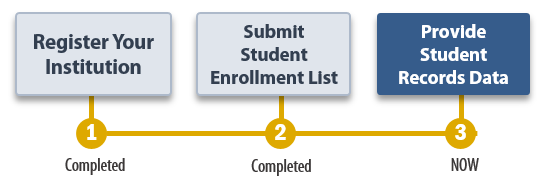
Your Student Records due date is: [DueDate].
If you have any questions or would like to discuss strategies for gathering your student records data, please contact [RTI Contact Name and Title], at [RTIe-mail].
Thank you for your efforts in support of NPSAS:24.
NCES staff name Jennifer Wine, Ph.D.
NCES staff title Director, NPSAS:24
National Center for Education Statistics (NCES) RTI International
Institute of Education Sciences
U.S. Department of Education
Enclosure
Student Records Reminder Letter and E-mail
Dear [Salutation] [LastName]:
I am writing to remind you of the [upcoming/recently passed] due date for your student records submission. This is the final task of the 2023–24 National Postsecondary Student Aid Study (NPSAS:24) field test. Your data are very important for ensuring that the NPSAS:24 field test is successful.
Your current due date is [DueDate].
Please log in to the Postsecondary Data Portal (PDP) and submit your student records data.
PDP Website: https://surveys.nces.ed.gov/xxxx
Your User ID: [UserID]
If you need to set a new due date, or you have any further questions about the study, please contact us at [email protected] or [HelpDeskNumber].
Sincerely,
[RTI Contact Name and Title]
Student Records Thank You E-mail
Subject: NPSAS:24 Field Test Student Records submitted
Dear [Salutation] [CCLastName]:
Thank you for submitting your NPSAS:24 field test student records data.
We will contact you if our student records team has questions about your data. Once your submission passes our quality control processes, we will notify you that the participation of [InstitutionName] in the NPSAS:24 field test is complete.
We strongly suggest that you take a moment to access the Archive Notes or Other Documentation task on the Postsecondary Data Portal. This optional task allows you to upload the notes, queries, and code you used to gather your data. All files you upload now will be available to your institution’s coordinator the next time [InstitutionName] is sampled for NPSAS, making participation easier and more efficient.
PDP Website: https://surveys.nces.ed.gov/xxxx
Your User ID: [UserID]
We very much appreciate your participation in this important study!
[RTI Contact Name and Title]
NPSAS:24 Field Test Participation Complete E-mail
Subject: NPSAS:24 Field Test Participation Complete
Dear [Salutation] [CCLastName]:
I am pleased to inform you that your NPSAS:24 field test student records data have passed our quality control checks. Your participation on behalf of [InstitutionName] in the field test is now complete.
Thank you very much for your contribution to NPSAS:24!
[RTI Contact Name and Title]
NPSAS:24 Field Test Participation Thank You Letter and Email to Campus Coordinator
[Date]
[Salutation] [FirstName] [LastName]
[Institution]
[Address]
[City], [State] [Zip]
Dear [Salutation] [CCLastName]:
I would like to thank you for your institution’s participation in the 2023-24 National Postsecondary Student Aid Study (NPSAS:24) field test. Your participation will help us refine our approach and make the full-scale study as successful as possible.
You can access the most recent NPSAS data for your own use. NCES’s DataLab (https://nces.ed.gov/datalab) provides a suite of powerful and intuitive online data tools for creating tables and conducting analyses using NPSAS and other NCES datasets. A variety of reports and publications are also available for download from the main NCES website. Institutions can use NPSAS data to expand their benchmarking work and provide a useful complement to their Integrated Postsecondary Education Data System (IPEDS) data.
Again, thank you for your participation and your continued support of NCES postsecondary studies.
Sincerely,
NCES staff name Jennifer Wine, Ph.D.
NCES staff title Director, NPSAS:24
National Center for Education Statistics (NCES) RTI International
Institute of Education Sciences
U.S. Department of Education
End of Data Collection E-mails
The following e-mails will be sent toward the end of the student records data collection period. There are two versions of the Final Weeks of Data Collection E-mail: one from the NPSAS:24 project director and the other from the NCES project officer. These are meant to prompt institutions that have not yet submitted student records data. The NPSAS Field Test Is Complete Thank You E-mail is sent to the chief administrator of the institution (as well as the Campus Coordinator) to give credit to institution staff who worked on the institution’s submission. |
Final Weeks of Student Records E-mail – From Project Director
Subject: NPSAS:24 Field Test Ends Soon – We need your participation.
Dear [Salutation] [CCLastName]:
We are in the final weeks of this NPSAS:24 field test data collection. NPSAS provides data on key postsecondary measures to leaders, legislators, researchers in postsecondary education, and others who will use the data in ways that ultimately benefit students. By participating in the field test, you will help us tailor our approach to NPSAS:24, which includes exploring ways to reduce burden on institutions, and therefore ensure a successful full-scale study.
What to do next? Please provide student records data for [InstitutionName] on the Postsecondary Data Portal (PDP) website:
PDP Website: https://surveys.nces.ed.gov/xxxx
Your User ID: [UserID]
Please contact the data collection team for your region at [HelpDeskNumber] or [email protected] if you have questions or need assistance with the process. (To facilitate a quicker response, please reference your institution’s ID number, [schoolID].)
Thank you for your support of NPSAS. Your participation will ensure that NPSAS:24 can provide the highest quality data to the postsecondary community.
Sincerely,
Jennifer Wine,
Ph.D.
Director, NPSAS:24
Final Weeks of Student Records E-mail – From NCES
Subject: NPSAS:24 Field Test – Last chance to participate
Dear [Salutation] [CCLastName]:
I am e-mailing to encourage your institution’s participation in the 2023–24 National Postsecondary Student Aid Study (NPSAS:24) field test. The last day to provide student records data for inclusion in the study is [EndDate]. NPSAS:24 is conducted by the National Center for Education Statistics (NCES) under a congressional mandate to gather information from postsecondary institutions on how students and their families finance college. Your participation is important to making this study a success.
NPSAS data play a key role in evaluating the effectiveness of federal financial aid programs in meeting the needs of students. Data from previous NPSAS studies, which have been cited in journal and newspaper articles and foundation policy briefs, are focused on a variety of topics important to the higher education community, including financial aid use and debt accumulation, education outcomes, and changing demographics of today’s students. We want to make sure these data accurately represent institutions like yours.
We try to accommodate institutions’ individual needs whenever possible, and we do have some flexibility in certain aspects of the study. To discuss this, or if you have any questions about your participation, please contact the NPSAS Project Director, Dr. Jennifer Wine, at [JWPhoneNumber] or via e-mail at [JWe-mailAddr]. If you have any comments or general feedback that you would like to provide to NCES about this data collection, please contact me at [NCESPhoneNumber] (e-mail address: [NCESe-mailAddr]).
Please let us know how we can assist you. Thank you again for your cooperation and interest.
Please log on and provide data at: https://surveys.nces.ed.gov/xxxx Your
User ID: [UserID] If
you do not recall your password, click Forgot Password. 
NCES staff person
NCES staff title
National Center for Education Statistics (NCES)
Institute of Education Sciences
U.S. Department of Education
.
NPSAS Field Test Is Complete Thank You E-mail – From Project Director
Subject: Thank you for participating in the NPSAS:24 field test
Dear [Salutation] [CALastName]:
On behalf of our entire team, I would like to thank you for your institution’s participation in the 2023-24 National Postsecondary Student Aid Study (NPSAS:24) field test. In an effort to thank all who participated in the success of this collection, we would like to recognize [this individual/these individuals] at your institution:
[ListPDPContacts]
Your institution’s participation in the field test will help us tailor our approach to NPSAS:24, which includes exploring ways to reduce burden on institutions, and therefore ensure a successful full-scale study.
Again, thank you for your participation and your continued support of NCES postsecondary studies.
Sincerely,
Jennifer Wine, Ph.D.
Director, NPSAS:24
PDP Website Content for Student Records Collection
This section includes content of the Postsecondary Data Portal (PDP) that is available to users at sampled institutions, after logging in to the website, and specifically pertains to the student records collection. All other PDP content for NPSAS:24 can be seen in this document beginning on p. D-42. |
Frequently Asked Questions – Student Records (SR) Collection
This section includes FAQs that specifically apply to the student records collection. FAQs pertaining to other parts of the NPSAS:24 collection can be seen in this document beginning on p. D-57. |
What data are you requesting?
NPSAS requests data about student demographics, enrollment, budget (costs of attendance), and financial aid. For a brief overview of the data items requested, see the NPSAS:24 Field Test Student Records Data Item Overview. For full details about item definitions and file layout specifications, see the NPSAS:24 Field Test Student Records Codebook. These documents are available on the Resources page on the PDP.
Where can I find the data requested?
NPSAS requests data about student demographics, enrollment, budget (costs of attendance), and financial aid. These data are typically collected from the Institutional Research Office, the Admissions or Registrar’s Office, the Bursar’s or Business Office, and/or the Financial Aid Office, depending on how your institution structures its data systems. You may need to coordinate with multiple offices at your institution to compile the data. See the Student Records Handbook for more details about the data requested. If you need assistance, please contact the Help Desk with your questions at [number] or [EMAIL ADDRESS].
What has changed since NPSAS:20?
If you participated in the NPSAS:20 student record collection in 2020, you will notice some data item changes have been made for NPSAS:24. These changes are intended to increase data quality, clarify item definitions, and improve instructions. You can find the list of changes in the NPSAS:24 Field Test Student Records Codebook and the “What’s New” page of the NPSAS:24 Field Test Student Records Handbook, which are available on the Resources page of the PDP.
How long does it take to collect student records data for NPSAS:24?
We estimate that providing the requested student records data will take about 30 hours on average. If you have any concerns about the amount of time it is taking you to provide the requested data, please call the Help Desk at [number]. RTI will work with you to successfully complete this data collection effort.
How do we provide the data?
There are three methods, or modes, available for providing the student records data through the PDP website:
Web mode: keying data into the PDP, one student at a time
Excel mode: filling in and then uploading an Excel template
CSV mode: uploading CSV (comma separated value) data files created by you or a programmer
If you cannot provide data using one of these modes, please contact our Help Desk to discuss custom options.
What assistance is available from the NCES contractor, RTI International, staff?
The NPSAS Help Desk is available to answer your questions from 9:00 am to 8:00 pm ET, Monday - Friday. Please call [number] or e-mail us at [EMAIL ADDRESS].
Student Records Debriefing
This section includes debriefing questions that institutions will be prompted to answer after they submit student records data. |
We have a few additional questions that will help us improve NPSAS data collection in the future.
How long did it take your institution to prepare the student records data? ____ hours
NCES is exploring whether data about instructional setting should be collected in future rounds of NPSAS. By instructional setting, we mean whether students’ courses were offered in-person, through distance education, or a mix of in-person and distance education. To aid in the decision-making process, we would like to gather information about the range of instructional settings offered at your institution.
At any time between July 1, 2022 to June 30, 2023 year, which of the following instructional mode(s) were offered by your institution (choose all that apply)? If there are additional scenarios at your institution not covered by these scenarios, please describe them in the “Other” section.
Courses conducted entirely in-person.
Courses conducted entirely online.
Courses with content delivered using a mix of in-person and online instruction.
Courses conducted primarily in-person, with accommodations for some students to take the course online.
Courses conducted in-person at one site, which simultaneously delivered online to students located at another site.
Courses conducted online with in-person meetings outside of class time (e.g., labs or discussion groups).
Other (please describe): _________
NCES is interested in collecting data on the prevalence of Open Educational Resources (OER) and the impact of these resources on the cost of books and supplies. By OER, we mean open access textbooks, course materials and full courses, modules, streaming videos, software, and any other tools or materials used to support instruction. OER are freely and publicly available teaching, learning, and research resources that reside in the public domain or have been released under an intellectual property license that permits their free use and re-purposing by others.
Does your institution offer Open Educational Resources (OER) to students?
Yes
No
Don’t Know
If yes, please provide a brief description of the types of resources available at your institution: ____________
Would you or someone else at your institution be willing speak with a member of the NPSAS team to discuss the use of OER at your institution and the impact of these resources on students’ cost of attendance?
Yes
No
If there are any comments that you would like to share with us about your institution’s data or your experience completing NPSAS:24 Field Test, please provide them below.
Comments ______________
Scripts and Storyboards for Instructional Videos
Mode Selection Video
Script for Audio |
Visual |
Scene Description |
To get started, select a
mode for providing student records data. You can choose from three
mode options: web mode, Excel mode, and CSV mode. |
|
Shot of mode selection screen. Mouse over mode selection buttons. |
In Web Mode, you will key student records data one student at a time. We recommend web mode for smaller institutions, such as those with fewer than 20 sampled students. You can also use web mode to edit data that you entered using Excel or CSV mode. |
|
Mouse over Web Mode button, inset shot of web mode data entry in top right corner of video. |
In Excel Mode, you will download an Excel template that is pre-formatted with four data sections, and then enter your student data offline. When you’ve finished entering data into the Excel template, you will upload it to the Portal website. We recommend Excel mode for institutions with up to 100 sampled students. |
|
Mouse over Excel Mode button, inset shot of Excel mode data entry in top right corner of video. |
In CSV mode, you will download your list of sampled students and a specifications document for creating Comma Separate Value, or CSV, files. You will create 4 CSV files following the specifications document and upload the completed files. We recommend CSV mode for institutions with more than 100 sampled students. You can switch modes at any time, and any data that you previously entered will be pre-filled for you. |
|
Mouse over CSV Mode button, inset shot of CSV mode data entry in top right corner of video. |
Web Mode Video
Script for Audio |
Visual |
Scene Description |
The web mode grid displays a list of your institution’s sampled students and your progress entering data for each section. |
|
Shot of web mode grid page. Mouse over columns in grid to highlight students’ identifying information, legend, and progress indicator icons. |
Click on a student’s name to start providing data for that student.
|
|
Cursor selects first sampled student in list. |
Once you have chosen the sampled student, provide data in each of the four sections on the page: General Student Information, Enrollment, Budget, and Financial Aid. When you change a field, it will turn green to indicate that the data have been saved. You can use Web Mode to enter all your student records data, or you can use it to edit data you uploaded in Excel or CSV Mode. |
|
Shot of web mode data entry page. Cursor navigates to each tab: General, Enrollment, Budget and Financial Aid. |
When you have finished entering data for each section, click the Check for Errors button at the bottom of the section. This will check the data you provided and indicate whether there are any errors.
|
|
Close-up shot of web mode navigation buttons. Cursor clicks finalize button and scrolls up to view errors. |
When you have finished entering data for all students, click the “Continue” button at the bottom of the web mode grid. You will be asked to answer some brief questions about how you submitted your data. Then, click the “Finalize All Student Record Information” button. |
|
Shot of web mode grid. Cursor clicks the “Finalize All Student Record Information” button. |
A final confirmation notification pop up box will appear for you to confirm finalizing all Student Records information. Once you finalize, you will no longer be able to make changes. |
|
Shot of web mode grid with confirmation box. Cursor clicks OK to dismiss the box. |
Excel Mode Video
CSV Mode Video
Script for Audio |
Visual |
Scene Description |
In CSV mode, you will download a file specifications document, and then create comma separate value, or CSV, files according to the specs. |
|
Shot of CSV file specifications document. |
There are four files, one for each data section: General Student Information, Enrollment, Budget, and Financial Aid. The file specifications indicate the number of fields that are required for each file, the order in which the data elements should be submitted, and the valid values for each data element. |
|
Cursor clicks through the tabs on the CSV file specifications document. |
It is extremely important that your files include the exact number of fields, and in the same order, as noted in the file specifications.
If your CSV files do not have the correct number of fields, the data will not be read into the Portal. If you find yourself needing to skip a data element, be sure to include a comma as a placeholder for that data element. |
|
Shot of CSV file specifications. Cursor scrolls down and highlights the number of fields in the file. Inset shot at top-right shows a correctly formatted CSV file. |
Once you’ve created your files, upload them on the Portal website. There are separate upload areas for each of the four file types; be sure you upload them in the correct section. You can upload the files multiple times; the most recent upload will overwrite previous uploads. |
|
Shot of the CSV page on the PDP. Cursor highlights the upload box for each file type. |
If your files have any errors or are missing critical items, the Portal will alert you. A list of errors and their corresponding students will appear in the Portal and can also be downloaded as an Excel file. You will be able to review your data issues and upload fixes as needed. |
|
Shot of CSV page on PDP. Cursor scrolls to list of uploaded files and expands the list of upload errors. |
When you have finished uploading data for all students, click the “Continue” button at the bottom of the page. |
|
Shot of CSV page on PDP. Cursor clicks “Continue” button. |
You will be asked to answer some brief questions that will help us review your institution’s data. Then, click the “Finalize All Student Record Information” button. Once you finalize, you will no longer be able make changes.
|
|
Shot of confirmation pop-up window. Cursor clicks OK to dismiss the window. |
Resources
Financial Aid Types Cheat Sheet
This document will be posted on the Resources page of the PDP and will serve as an aid for institutions that need assistance categorizing financial aid programs. The table below serves as an example of aid programs that may appear on the document. The actual list of financial aid programs will be customized based on the institution’s state. |
The table below lists common financial aid programs for your institution’s state and how they should be reported for NPSAS:24 Field Test student records collection. For all financial aid awards, please provide the program name in your data submission. Aid program names will not be released with the final data, but they will help NPSAS staff verify that reported amounts fall within statutory limits and ensure that the financial aid type and source are correctly coded.
Need-based versus merit-based aid: Need-based aid is awarded based on an applicant's financial resources. Merit-based aid is awarded based on an applicant's academic achievement. Merit aid that was awarded without consideration of financial resources should be considered merit aid. However, if any part of the awarding criteria includes a student's financial resources, the aid is considered either “need-based” or “both need and merit-based.” Aid based on neither need nor merit may include an applicant's non-academic talents, demographic, or other characteristics as the awarding criteria.
For additional help categorizing aid awards, contact the Help Desk at [number] or [email address].
Financial Aid Program |
Aid Source |
NPSAS:24 student records section |
Financial Aid Type |
DOD Armed Forces Grant |
Federal |
Priv/Oth Gvmt |
15=ROTC/Armed Forces Grant |
Emergency SEOG |
Federal |
Priv/Oth Gvmt |
1=Grant/scholarship, need-based |
CA Promise Grant |
State |
State |
6=Tuition waiver, non-faculty/staff |
FL Bright Futures |
State |
State |
2=Grant/scholarship, merit-based |
WA College Bound Scholarship |
State |
State |
1=Grant/scholarship, need-based |
NJ Skills Partnership Training Grant |
State |
State |
18=WIA/job training/vocational rehabilitation |
AZ Leap Grant |
State |
State |
1=Grant/scholarship, need-based |
GA Hope Scholarship |
State |
State |
2=Grant/scholarship, merit-based |
IA National Guard Grant |
State |
State |
15=ROTC/armed forces grant |
NM Lottery Scholarship |
State |
State |
2=Grant/scholarship, merit-based |
KY Veteran Dependent |
State |
State |
16=Veterans' benefits |
NJ Class Loan |
State |
State |
7=Loan |
WA Opportunity Grant |
State |
State |
3=Grant/scholarship, both need and merit |
WA Passport to College |
State |
State |
4=Grant/scholarship, neither need nor merit |
Student Records Codebook
This codebook includes a list of all items in the student records instrument. The content of the instrument is detailed in appendix H. This codebook document will be available to institutions as a PDF file in the Resources section of the PDP and will be included in the Excel template file and the CSV file specifications document. The codebook will also include the “What’s New” section of the Student Records Handbook, listed on page D-156 of this document. The final codebook document may include aesthetic changes that do not impact the content of the codebook. |
NPSAS:24 Field Test Student Records Item Codebook |
This
file includes all data items requested for the NPSAS:24 Field Test
student records collection. There are 4 data sections: General
Student Information, Enrollment, Budget (Cost of Attendance), and
Financial Aid. |
Important
Note: Customized Item Wording |
Changes
since NPSAS:20 |
Missing
Data Items If you are providing .csv files, do not omit the field from your file – if you upload a file with the wrong number of fields, the upload will fail. Instead, insert a comma for the field, but leave the value blank. |
Critical
Data Items |
Formatting
Data
In
this codebook, several data fields include a limited set of valid
values and suggested data formats. For example, we request that dates
be provided using a 2-digit month. We ask that you provide data in
the suggested format if possible. If you are not able to provide data
in the suggested format, the PDP website will accept data in other
formats. Please contact the Help Desk if you have questions or
concerns about formatting data. Our team may be able to work with
your institution’s data without reformatting. There is no
maximum length for any field.
Section
1 of 4: General Student Information
Field # |
Item Label |
Item Description |
Critical Data Item? |
Valid Values & Data Format |
Item Notes & Help Text |
1 CSV only |
VERSION |
File Specification Version Number |
Yes |
1 |
This item is required for CSV files. In the Excel template, this field will be pre-filled for you. |
2 CSV only |
INSTID |
Institute ID |
Yes |
|
Your institution's IPEDS ID. This item is required for CSV files. In the Excel template, this field will be pre-filled for you. |
3 CSV only |
STUDYID |
Study ID |
Yes |
|
The student's 8-digit study ID number, issued by RTI. This item is required for CSV files. In the Excel template, this field will be pre-filled for you. |
4 CSV only |
STUDID |
Student ID |
|
|
Your institution's student ID. In the Excel template, this field will be pre-filled for you. |
5 |
FNAME |
First Name |
Yes |
|
|
6 |
MNAME |
Middle Name |
Yes |
|
|
7 |
LNAME |
Last Name |
Yes |
|
|
8 |
SUFFIX |
Suffix |
|
|
|
9 |
SSN |
Social Security Number (SSN) |
Yes |
|
Enter
the student's 9-digit SSN with no spaces or dashes. |
10 |
DOBM |
DOB Month |
Yes |
01 - 12 |
|
11 |
DOBD |
DOB Day |
Yes |
01 - 31 |
|
12 |
DOBY |
DOB Year |
Yes |
1932 - 2007 |
|
13 |
SEX |
Sex |
Yes |
0=Male |
|
14 |
ELIGIBLE |
Student is eligible for NPSAS:24 Field Test? |
Yes |
1=Yes 0=No |
Note [Web and Excel mode]: this item defaults to Yes unless you change the selection. Note [CSV mode]: if you leave this item blank, the student will be treated as eligible for NPSAS:24 Field Test. If you think that this student is ineligible for NPSAS:24 Field Test, indicate No and select a reason that the student is ineligible. You do not need to provide any other data for ineligible students. The student is ineligible for NPSAS:24 Field Test if he or she meets any of the following conditions: •Not enrolled at institution: Student was not enrolled at this institution at any time from July 1, 2022 to June 30, 2023. •Tuition refund: Student was enrolled at one time but received a full tuition refund for all terms in study period from July 1, 2022 to June 30, 2023. •Enrolled in another institution: Student attends this institution under joint arrangements with another institution and pays tuition solely to the other institution. •Length of program: Student was enrolled in an occupational/technical program of study that required less than 3 months or 300 clock/contact hours of instruction. •Non-credit: Student was enrolled, but not in at least one course that could be applied toward fulfilling requirements for an academic degree, a certificate or diploma program, or in a term for credit that could be transferred to another school. •Completing high school: Student was still completing high school requirements for the last term enrolled. •GED or high school completion program: Student was enrolled solely in a GED or high school completion program for the last term enrolled. •Adult basic education program: Student was enrolled solely in an adult basic education program (e.g., ESL, literacy) for the last term enrolled. |
15 |
ELIGREASON |
Ineligible Reason |
Yes* |
1=Not
enrolled |
Select
the reason that the student is not eligible for NPSAS:24 Field
Test. •Tuition refund: Student was enrolled at one time but received a full tuition refund for all terms in study period from July 1, 2022 to June 30, 2023. •Enrolled in another institution: Student attends this institution under joint arrangements with another institution and pays tuition solely to the other institution. •Length of program: Student was enrolled in an occupational/technical program of study that required less than 3 months or 300 clock/contact hours of instruction. •Non-credit: Student was enrolled, but not in at least one course that could be applied toward fulfilling requirements for an academic degree, a certificate or diploma program, or in a term for credit that could be transferred to another school. •Completing high school: Student was still completing high school requirements for the last term enrolled. •GED or high school completion program: Student was enrolled solely in a GED or high school completion program for the last term enrolled. •Adult basic education program: Student was enrolled solely in an adult basic education program (e.g., ESL, literacy) for the last term enrolled. |
16 |
MARITAL |
Marital Status |
Yes |
0=Not
married (single, widowed, divorced)
|
This item is critical because it contributes to determining students’ dependency status. If you do not know this student’s marital status, please select Unknown. |
17 |
MAIDNAME |
Maiden Name |
|
|
|
18 |
SFNAME |
Spouse First Name |
|
|
|
19 |
SMNAME |
Spouse Middle Name |
|
|
|
20 |
SLNAME |
Spouse Last Name |
|
|
|
21 |
CITIZEN |
Citizenship Status |
|
1=US citizen or US national 2= Permanent resident or other eligible non-citizen 3=Foreign/International Student with student visa -1=Unknown |
Please indicate the student's citizenship status using one of the response options provided. Do not provide the student's country of origin. |
22 |
VETERAN |
Veteran or Active Duty Military |
Yes |
0=No |
Please indicate whether the sample member is a veteran of the U.S. Armed Forces or is serving on active duty (not whether the sample member is receiving veteran's benefits). |
23 |
HSCOMP |
High School Completion Type |
Yes |
1=High
School Diploma -2=Does Not Apply |
This item applies to undergraduate students only; for graduate students, select Does Not Apply (-2).
|
24 |
HSYEAR |
High School Completion Year |
|
1940 - 2023 |
|
25 |
ETHNICITY |
Ethnicity |
Yes |
0=Not
Hispanic or Latino |
Note
that these items are critical, and you will receive an error
message for leaving them blank. If you do not know a student’s
ethnicity or race, please select Unknown. |
26 |
RACEW |
Race: White |
Yes |
1=Yes |
You will receive an error message if you (a) leave all race items blank, or (b) select No for all race items. To resolve the error message, you may either select Yes for at least one race item or select Unknown for all race items. |
27 |
RACEB |
Race: Black or African American |
Yes |
1=Yes |
You will receive an error message if you (a) leave all race items blank, or (b) select No for all race items. To resolve the error message, you may either select Yes for at least one race item or select Unknown for all race items. |
28 |
RACEAS |
Race: Asian |
Yes |
1=Yes |
You will receive an error message if you (a) leave all race items blank, or (b) select No for all race items. To resolve the error message, you may either select Yes for at least one race item or select Unknown for all race items. |
29 |
RACEAI |
Race: American Indian or Alaska Native |
Yes |
1=Yes |
You will receive an error message if you (a) leave all race items blank, or (b) select No for all race items. To resolve the error message, you may either select Yes for at least one race item or select Unknown for all race items. |
30 |
RACENH |
Race: Native Hawaiian or Other Pacific Islander |
Yes |
1=Yes |
You will receive an error message if you (a) leave all race items blank, or (b) select No for all race items. To resolve the error message, you may either select Yes for at least one race item or select Unknown for all race items. |
31 |
PMADD1 |
Permanent Address Line 1 |
|
|
|
32 |
PMADD2 |
Permanent Address Line 2 |
|
|
|
33 |
PMADDC |
Permanent Address City |
|
|
|
34 |
PMADDC |
Permanent Address State |
|
|
Enter the 2-character postal abbreviation. |
35 |
PMADDZ |
Permanent Address Zip |
|
|
Enter a 5-digit or 9-digit ZIP code with no spaces, parentheses, or dashes. |
36 |
PMADDCY |
Permanent Address Country (if not USA) |
|
|
If USA, leave blank. |
37 |
PERMRES |
Permanent resident |
|
1=Yes |
Is the student a permanent resident of the state in which your institution is located? |
38 |
LADD1 |
Local/Most Recent Address Line 1 |
|
|
|
39 |
LADD2 |
Local/Most Recent Address Line 2 |
|
|
|
40 |
LADDC |
Local/Most Recent Address City |
|
|
|
41 |
LADDS |
Local/Most Recent Address State |
|
|
Enter the 2-character postal abbreviation. |
42 |
LADDZ |
Local/Most Recent Address Zip |
|
|
Enter the 5-digit or 9-digit ZIP code with no spaces, parentheses, or dashes. |
43 |
PHONE1 |
Phone 1 Number |
|
|
Enter a valid 10-digit phone number with no spaces, parentheses, or dashes. Example: 2025551234 |
44 |
TYPE1 |
Phone 1 Type |
|
1=Home |
|
45 |
PHONE2 |
Phone 2 Number |
|
|
Enter a valid 10-digit phone number with no spaces, parentheses, or dashes. |
46 |
TYPE2 |
Phone 2 Type |
|
1=Home |
|
47 |
CAMEMAIL |
Campus Email |
|
|
Example: [email protected] |
48 |
PERMEMAIL |
Personal Email |
|
|
|
49 |
PFNAME |
Parent First Name |
|
|
|
50 |
PMNAME |
Parent Middle Name |
|
|
|
51 |
PLNAME |
Parent Last Name |
|
|
|
52 |
PSUFFIX |
Parent Suffix |
|
|
|
53 |
PADD1 |
Parent Address Line 1 |
|
|
|
54 |
PADD2 |
Parent Address Line 2 |
|
|
|
55 |
PADDC |
Parent Address City |
|
|
|
56 |
PADDS |
Parent Address State or Province |
|
|
Enter the 2-character postal abbreviation. |
57 |
PADDZ |
Parent Address Zip |
|
|
Enter a 5-digit or 9-digit ZIP code with no spaces, parentheses, or dashes. |
58 |
PADDCY |
Parent Country (if not USA) |
|
|
If USA, leave blank. |
59 |
PEMAIL |
Parent Email |
|
|
|
60 |
PPHONE |
Parent Phone |
|
|
Enter a valid 10-digit phone number with no spaces, parentheses, or dashes. |
61 |
PCELL |
Parent Cell Phone |
|
|
Enter a valid 10-digit phone number with no spaces, parentheses, or dashes. |
62 |
PINTPHONE |
Parent International Phone |
|
|
|
63 |
OFNAME |
Other Contact First Name |
|
|
|
64 |
OMNAME |
Other Contact Middle Name |
|
|
|
65 |
OLNAME |
Other Contact Last Name |
|
|
|
66 |
OSUFFIX |
Other Contact Suffix |
|
|
|
67 |
OTHREL |
Relationship of Other Contact to Student |
|
1=Parent |
|
68 |
OADD1 |
Other Contact Address Line 1 |
|
|
|
69 |
OADD2 |
Other Contact Address Line 2 |
|
|
|
70 |
OADDC |
Other Contact Address City |
|
|
|
71 |
OADDS |
Other Contact Address State or Province |
|
|
Enter the 2-character postal abbreviation. |
72 |
OADDZ |
Other Contact Address Zip |
|
|
Enter a 5-digit or 9-digit ZIP code with no spaces, parentheses, or dashes. |
73 |
OADDCY |
Other Contact Country (if not USA) |
|
|
If USA, leave blank. |
74 |
OEMAIL |
Other Contact Email |
|
|
|
75 |
OPHONE |
Other Phone |
|
|
Enter a valid 10-digit phone number with no spaces, parentheses, or dashes. |
76 |
OCELL |
Other Cell Phone |
|
|
Enter a valid 10-digit phone number with no spaces, parentheses, or dashes. |
Section
2 of 4: Enrollment
Field # |
Item Label |
Item Description |
Critical Data Item? |
Valid Values & Data Format |
Item Notes & Help Text |
1 CSV only |
VERSION |
File Specification Version Number |
Yes |
1 |
This item is required for CSV files. In the Excel template, this field will be pre-filled for you. |
2 CSV only |
INSTID |
Institute ID |
|
|
Your institution's IPEDS ID. This item is required for CSV files. In the Excel template, this field will be pre-filled for you. |
3 CSV only |
STUDYID |
Study ID |
|
|
The student's 8-digit study ID number, issued by RTI. This item is required for CSV files. In the Excel template, this field will be pre-filled for you. |
4 CSV only |
STUDID |
Student ID |
|
|
Your institution's student ID. This item is required for CSV files. In the Excel template, this field will be pre-filled for you. |
5 |
FDATEM |
Date First Enrolled at this Institution (Month) |
|
01 - 12 |
Enter the date the student enrolled at this institution for the first time, even if this date occurred prior to this academic year.
|
6 |
FDATED |
Date First Enrolled at this Institution (Day) |
|
01 - 31 |
|
7 |
FDATEY |
Date First Enrolled at this Institution (Year) |
|
1940 - 2023 |
|
8 |
LDATEM |
Date Last Enrolled at this Institution (Month) |
|
01 - 12 |
If the student is no longer enrolled at this institution, enter the student’s last date of enrollment. If the student is still enrolled at the institution, leave this item blank. Indicate whether your institution accepted transfer credits for this student from another postsecondary institution. Please exclude remedial or developmental courses. |
9 |
LDATED |
Date Last Enrolled at this Institution (Day) |
|
01 - 31 |
|
10 |
LDATEY |
Date Last Enrolled at this Institution (Year) |
|
1940 - 2023 |
|
11 |
TRANSFER |
Accepted Transfer Credit? |
|
1=Yes |
Indicate whether your institution accepted transfer credits for this student from another postsecondary institution. Please exclude remedial or developmental courses. |
12 |
REMEDIAL |
Ever Taken Remedial Course(s)? |
|
1=Yes |
Since
completing high school, has the student taken any
remedial/developmental courses to improve their basic skills in
English, math, reading, or writing? If possible, answer Yes if
your records indicate that the student took any remedial courses
since high school, even if they were not taken at your
institution. If you do not have records to indicate whether
remedial courses were taken at a prior institution, please
respond based on your own institution’s records. |
13 |
RECBACH |
Received Bachelor's Degree? |
|
1=Yes |
Select Yes if the student has already obtained a bachelor's degree, even if it was not awarded by this institution. |
14 |
BACHDATEM |
Date Bachelor's Received (Month) |
|
1 - 12 |
If the student has obtained a bachelor's degree, enter the date the degree was received. If the student has not yet received a bachelor’s degree, leave this item blank. |
15 |
BACHDATED |
Date Bachelor's Received (Day) |
|
1 - 31 |
|
16 |
BACHDATEY |
Date Bachelor's Received (Year) |
|
1950 - 2023 |
|
17 |
ACTE |
ACT English Score |
|
1 - 36 |
Enter the student’s ACT English score. If this student has multiple scores on record, enter the score that is used according to your institution’s admissions policy. |
18 |
ACTM |
ACT Mathematics Score |
|
1 - 36 |
Enter the student’s ACT Math score. If this student has multiple scores on record, enter the score that is used according to your institution’s admissions policy. |
19 |
ACTR |
ACT Reading Score |
|
1 - 36 |
Enter the student’s ACT Reading score. If this student has multiple scores on record, enter the score that is used according to your institution’s admissions policy. |
20 |
ACTS |
ACT Science Score |
|
1 - 36 |
Enter the student’s ACT Science score. If this student has multiple scores on record, enter the score that is used according to your institution’s admissions policy. |
21 |
ACTC |
ACT Composite Score |
|
1 - 36 |
Enter the student’s ACT Composite score. If this student has multiple scores on record, enter the score that is used according to your institution’s admissions policy. |
22 |
SATREAD |
SAT Evidence-Based Reading and Writing Score |
|
200 - 800 |
Enter the student’s SAT Evidence-Based Reading and Writing score. If this student has multiple scores on record, enter the score that is used according to your institution’s admissions policy. For students who took the SAT test prior to March 2016, please report the Critical Reading score in this field. |
23 |
SATMATH |
SAT Math Score |
|
200 - 800 |
Enter the student’s SAT Math score. If this student has multiple scores on record, enter the score that is used according to your institution’s admissions policy. For students who took the SAT test prior to March 2016, please report the Mathematics score in this field. |
24 |
PROGRAM |
Program/Degree |
Yes |
1=Enrolled
in undergraduate courses, not in a degree program
|
In
what degree program was this student enrolled on June 30, 2023?
If the student was no longer enrolled on June 30, 2023, report
the degree program for his or her last term enrolled between July
1, 2022 and June 30, 2023. |
25 |
GRADTYPE |
Graduate Degree Type (FOR GRADUATE DEGREES ONLY) |
|
1=Master
of Science (MS) 11=Doctor
of Philosophy (PhD) |
FOR GRADUATE STUDENTS ONLY. In what type of graduate degree program was this student enrolled on June 30, 2023? If the student was no longer enrolled on June 30, 2023, report the graduate degree program type for his or her last term during his or her last term enrolled between July 1, 2022 and June 30, 2023.
|
26 |
CLASSLVL |
Class Level |
Yes |
1=1st Year/Freshman 2=Sophomore 3=Junior 4=Senior 5=5th Year or Higher Undergraduate 6=Undergraduate (unclassified) 7=Student with bachelor's or advanced degree taking undergraduate courses 8=1st year Graduate 9=Beyond 1st year Graduate 10=Graduate (unclassified) -1=Unknown |
Enter the student's class level as of June 30, 2023. If the student was no longer enrolled on June 30, 2023, provide the student’s class level during his or her last term enrolled between July 1, 2022 and June 30, 2023.
If class level was used to determine financial aid eligibility, report that class level for this item. Otherwise, report the class level as defined by your institution. Institutions typically define class level based on the number of earned credits.
An example of a commonly used classification: • 0-29 earned credit hours for first-year/freshman • 30-59 earned credit hours for sophomore • 60-89 earned credit hours for junior • 90+ earned credit hours for senior. |
27 |
DEGDATEM |
Degree Completion Date (Month) |
|
01 - 12 |
If the student has completed the degree program, enter the date the degree was received. |
28 |
DEGDATED |
Degree Completion Date (Day) |
|
01 - 31 |
|
29 |
DEGDATEY |
Degree Completion Date (Year) |
|
1950 - 2023 |
|
30 |
EXPECT |
Expected to complete degree requirements before June 30, 2023? |
|
1=Yes -1=Unknown/unable to determine -2=Does not apply |
Is the student expected to have completed the requirements for their current degree program on or before June 30, 2023? This item is used to identify potential eligible sample members for the Baccalaureate and Beyond Longitudinal Study. This item applies ONLY to students enrolled in bachelor’s degree programs.
Completion
of the requirements means all required classes have been taken
and passed and sufficient credit or clock hours have been earned.
Some students may not yet have been awarded their degree or
certificate by the institution, even though the requirements have
been completed. • The student has completed his or her degree (completed degrees are collected separately in this section). • The student is no longer enrolled in this institution. • The student is not enrolled in a bachelor’s degree program.
Enter “Unknown/unable to determine” (-1) if the student is enrolled in a bachelor’s degree program, but you cannot state whether the student is likely to complete degree requirements by June 30, 2023. |
31 |
CUMGPA |
Cumulative (Unweighted) GPA |
|
N.NN or NNN.N |
Please provide the student’s cumulative GPA as of June 30, 2023. If your institution uses a 4-point scale, please enter GPA with two decimal places (x.xx). If your institution uses a 100 point scale, enter the grade with one decimal place (xx.x). |
32 |
MAJOR1 |
First Major |
|
|
|
33 |
MAJOR1CIP |
First Major CIP Code |
|
NNNNNN |
Please
provide the CIP code for this student’s first major as of
June 30, 2023. If the student was no longer enrolled on June 30,
provide the student’s major during his or her last term
enrolled between July 1, 2022 and June 30, 2023.
|
34 |
MAJOR2 |
Second Major |
|
|
|
35 |
MAJOR2CIP |
Second Major CIP Code |
|
NNNNNN |
Please provide the CIP code for this student’s first major as of June 30, 2023 If the student was no longer enrolled on June 30, provide the student’s major during his or her last term enrolled between July 1, 2022 and June 30, 2023.
CIP (Classification of Instructional Programs) codes are used by the National Center for Education Statistics (NCES) for major or field of study reporting, assessment, and tracking. The current taxonomy, CIP 2020, is preferred. For more information about the Classification of Instructional Programs, see https://nces.ed.gov/ipeds/cipcode/.
If you cannot report the major CIP code, please leave this column blank and enter the student's current or most recent second major or field of study in the Second Major item in this section. If the student has not yet declared a major, please leave this item blank and select "Yes" for the "undeclared" item in this section. |
36 |
MAJUND |
Major Undeclared |
|
1=Yes |
Indicate Yes if the student's major was undeclared. |
37 |
PROGCLOCK |
Total Number of Clock Hours in Program |
|
|
If this student is enrolled in a clock hour program, what is the total length of the program in clock/contact hours? If the student is not enrolled in a clock hour program, leave blank. |
38 |
CUMCLOCK |
Cumulative Clock Hours Completed |
|
|
Please provide the total cumulative clock hours earned by this student as of June 30, 2023. Include all clock hours earned, even if they do not count toward the student’s degree/program requirements. |
39 |
PROGCRED |
Total Number of Credit Hours in Program |
|
|
If this student is enrolled in a credit hour program, what is the total length of the program in credit/contact hours? If the student is not enrolled in a credit hour program, leave blank. |
40 |
CUMCRED |
Cumulative Credit Hours Completed |
|
|
Please provide the total cumulative credit hours earned by this student as of June 30, 2023. Include all credit hours earned, even if they do not count toward the student’s degree/program requirements. |
41 |
TUITION |
Total Tuition and Mandatory Fees Charged ($) |
Yes |
0 - 120000 |
NOTE:
CUSTOM WORDING The
amount entered should be the amount CHARGED for the period(s) in
which the student was enrolled between July 1, 2022 and June 30,
2023, prior to any aid, discounts, or waivers. Please enter the specific amount charged for this student (typically obtained from the business or bursar's office), not the budgeted tuition amount or the average tuition amount charged for students. |
42 |
RESIDENCY |
Residency for Tuition Purposes |
|
1=In-district |
Please
indicate the student's tuition classification for the 2022-2023
academic year. |
43 |
ENRSTAT1 |
Term 1 Enrollment Status |
Yes |
0=Not enrolled 1=Full-time 2=3/4-time 3=Half-time 4=Less than half-time |
NOTE: CUSTOM WORDING. This document includes generic wording that you can use to begin compiling your institution's data, but you must download the CSV file specifications or the Excel template codebook to see the customized wording. You can download both of these documents on the PDP. • For term-based institutions, this item will repeat for each term that your institution reported on the Registration page. The item descriptions will be pre-filled with your institution's term names. • For continuous enrollment institutions, this item will be listed 12 times - once for each month in the July 1, 2022 to June 30, 2023 federal financial aid year.
Enter the student’s enrollment status in this term/month. If enrollment status was used to determine financial aid eligibility, report that enrollment status for this item. Otherwise, report the enrollment status as defined by your institution. Institutions typically define enrollment status based on the number of credit or clock hours attempted. For example, students who are enrolled as a full-time student typically carry at least • 12 semester or quarter hours per term at the undergraduate level or 9 credit hours per term at the graduate level. • 24 semester hours or 36 quarter hours per academic year for an educational program using credit hours for a program of less than one academic year. • 24 clock hours per week for an education program using clock hours. |
44 |
CRED |
Term 1 Credit Hours |
Yes |
|
NOTE:
CUSTOM WORDING. This document includes generic wording that you
can use to begin compiling your institution's data, but you must
download the CSV file specifications or the Excel template
codebook to see the customized wording. You can download both of
these documents on the PDP. |
Section
3 of 4: Budget (Cost of Attendance)
Field # |
Item Label |
Item Description |
Critical Data Item? |
Valid Values & Data Format |
Item Notes & Help Text |
1 CSV only |
VERSION |
File Specification Version Number |
Yes |
1 |
This item is required for CSV files. In the Excel template, this field will be pre-filled for you. |
2 CSV only |
INSTID |
Institute ID |
|
|
Your institution's IPEDS ID. This item is required for CSV files. In the Excel template, this field will be pre-filled for you. |
3 CSV only |
STUDYID |
Study ID |
|
|
The student's 8-digit study ID number, issued by RTI. This item is required for CSV files. In the Excel template, this field will be pre-filled for you. |
4 CSV only |
STUDID |
Student ID |
|
|
Your institution's student ID. This item is required for CSV files. In the Excel template, this field will be pre-filled for you. |
5 |
BUDPER |
Budget Period |
Yes |
1=Full-time,
full-year |
Select the budget period that matches the budgeted costs of attendance you will provide for this student.
Option 2: If a full-time, full-year budget is not available, you can use Pell guidelines to prorate the amount to reflect the costs for a full-time student enrolled for a full academic year in the student’s academic program. See page X of the Student Records Handbook (available on the Resources page of the PDP) for definitions and more information about prorating costs of attendance.
Option 3: If a full-time, full-year budget is not available, and you cannot provide a prorated amount, you may provide budgeted costs of attendance for other budget periods.
Option
4: If you cannot provide an individualized budget (a budget that
includes costs of attendance specific to the student’s
program and residence), you can provide a generic budget. For additional guidance and examples, please see the Student Records Handbook (available on the Resources page of the PDP).
|
6 |
FULLYEAR |
Full-year Budget |
Yes* |
1=Yes,
the full-year budget includes summer term(s) |
If you provided a full-year budget for this student (Budget Period = 1, 3, 5, or 7), please indicate whether the budgeted costs of attendance include summer terms. If you provided a one term budget, leave this item blank. |
7 |
STURES |
Student Residence |
|
1=On-campus
or school-owned housing |
For purposes of determining the student’s budgeted cost of attendance for the 2022-2023 academic year, what was the student’s housing/residence status? |
8 |
BTUITION |
Tuition/Fees ($) |
Yes |
0 - 120000 |
For
the budget period you specified for this student, enter the
BUDGETED cost for tuition and fees for this student. This amount
may differ from the total tuition and fees CHARGED (requested in
the enrollment section), and is typically obtained from the
financial aid office. |
9 |
BBOOKS |
Books/Supplies ($) |
|
0 - 10000 |
For
the budget period you specified for this student, enter the
BUDGETED cost for books & supplies for this student. |
10 |
BBOARD |
Room and Board ($) |
|
0 - 40000 |
For
the budget period you specified for this student, enter the
BUDGETED cost for room & board for this student. |
11 |
BHEALTH |
Health Insurance ($) |
|
0 - 10000 |
For the budget period you specified for this student, enter the BUDGETED cost for health insurance for this student. Enter an amount with no decimals, commas, or dollar signs. Round values with decimals to the nearest whole number. |
12 |
BTRANS |
Transportation ($) |
|
0 - 10000 |
For
the budget period you specified for this student, enter the
BUDGETED cost for transportation for this student. |
13 |
BCOMP |
Computer/Technology ($) |
|
0 - 10000 |
For
the budget period you specified for this student, enter the
BUDGETED cost for computer/technology for this student. For
example: a reasonable cost, as determined by your institution,
for the rental or purchase of a personal computer that the
student will use for study for budget period you specified for
this student. |
14 |
BOTHER |
All Others ($) |
|
0 - 10000 |
For the budget period you specified for this student, enter the total budgeted cost of attendance not included in any of the previous budget categories. |
15 |
BTOTAL |
Total Budgeted Cost of Attendance ($) |
Yes |
0 - 200000 |
For the budget period you specified for this student, enter the total budgeted cost of attendance. |
Section
4 of 4: Financial Aid
Student Records Handbook
This document will provide detailed instructions for providing student records data. It will be available as a PDF file in the Resources section of the PDP. The images below are provided as examples of the content that will appear in the Handbook. Because the PDP website is still being developed, some images display sample content from NPSAS:20. The final images may include aesthetic changes that do not impact the content of the pages. In November 2022, ED published a Federal Register notice (87 FR 66683) announcing changes authorized by the FAFSA Simplification Act. While these changes do not take effect until the 2023-24 award year, many institutions will implement changes to their Student Information Systems (SIS) in spring 2023, which will coincide with NPSAS:24 Field Test student records collection. The impact that these SIS changes will have on NPSAS:24 Field Test collection is still unknown and may not crystallize until data collection is underway. If needed, minor changes will be made to this Handbook during data colletion to provide additional instructions or respond to common questions received by institutions. |
About This Handbook
This handbook will help guide you through using the Postsecondary Data Portal (PDP) to provide NPSAS:24 Field Test student records data.
Contents
Tour of the Postsecondary Data Portal
Student Records Data Items
What’s New
Selecting a Mode to Provide Data
Web Mode
Excel Mode
CSV Mode
Guide to the General Student Information Section
Guide to the Enrollment Section
Guide to the Budget Section
Guide to the Financial Aid Section
Student Records Codebook [included on page D-111]
Help Desk
Need Help? Contact the Help Desk toll free at [number] or via e-mail at [EMAIL ADDRESS]. The Help Desk is available from 9:00 am to 8:00 pm ET, Monday - Friday.
Tour of the Postsecondary Data Portal (PDP)
You will use the Postsecondary Data Portal, or PDP, to submit student records data for NPSAS:24 Field Test.
Getting Started
To get started, go to https://surveys.nces.ed.gov/xxxx. Use the credentials you were provided to log in to the PDP. If you need help logging in, please contact the Help Desk.
When you log in the first time, you will be prompted to update your password as a security measure. From each subsequent login, you will also be emailed a secondary security code.
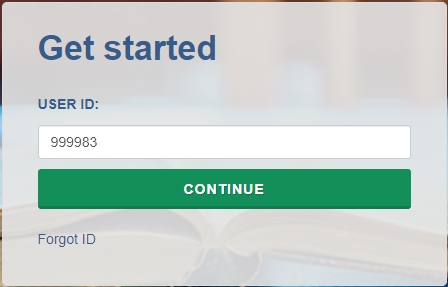
The Task Menu will guide you through providing data for NPSAS:24 Field Test and the steps you need to complete next.
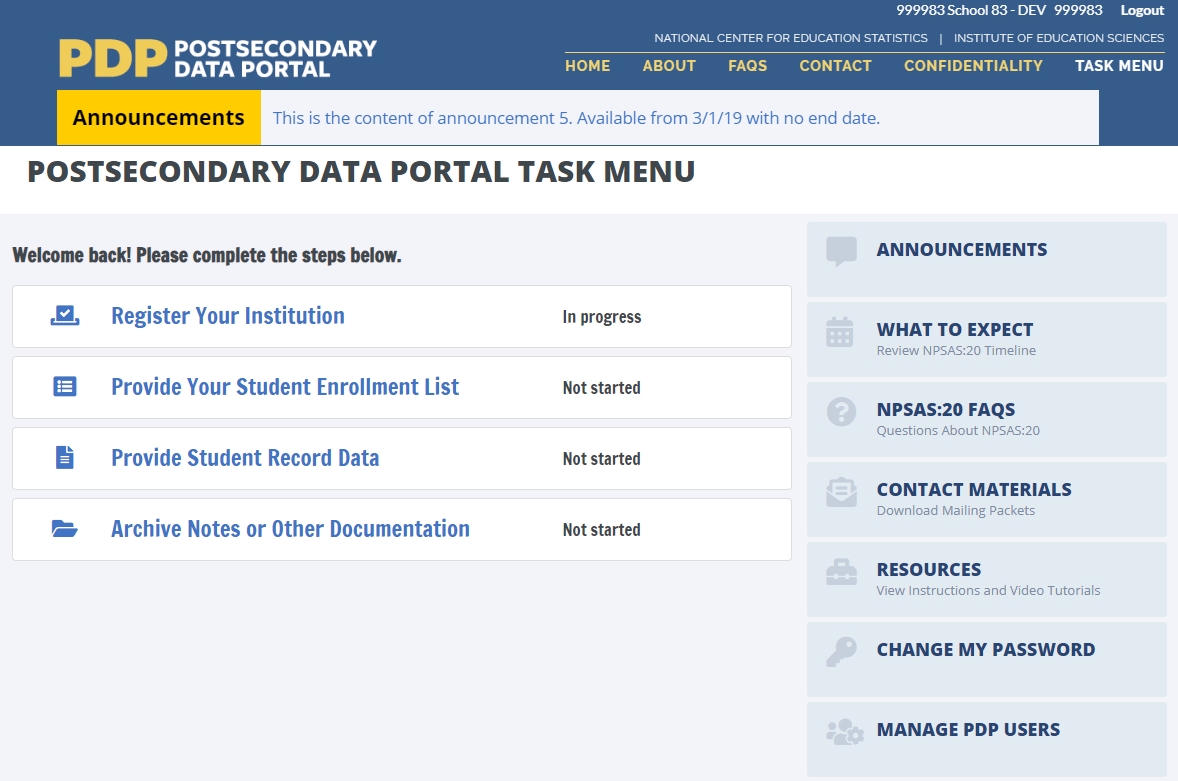
The Announcements bar will be used to post announcements on the PDP during data collection, if needed. Content of these announcements may include upcoming deadlines or website maintenance.
Help Menu
The PDP also features a number of resources on the right-hand help menu.
The What to Expect page includes schedule of NPSAS:24 Field Test data collection.
The NPSAS:24 FAQs page includes answers to Frequently Asked Questions about the study.
The Contact Materials page allows you to view contact materials and supporting documents that were sent to your institution.
The Resources page includes instructions, videos, and other resources that will help you complete the NPSAS:24 Field Test.
The Manage PDP Users page allows you to create PDP login credentials for additional staff from your institution. For many institutions, NPSAS:24 will likely require coordination between multiple departments within your institution (such as Institutional Research, Bursar’s, and Financial Aid offices).
Student Records Data Items
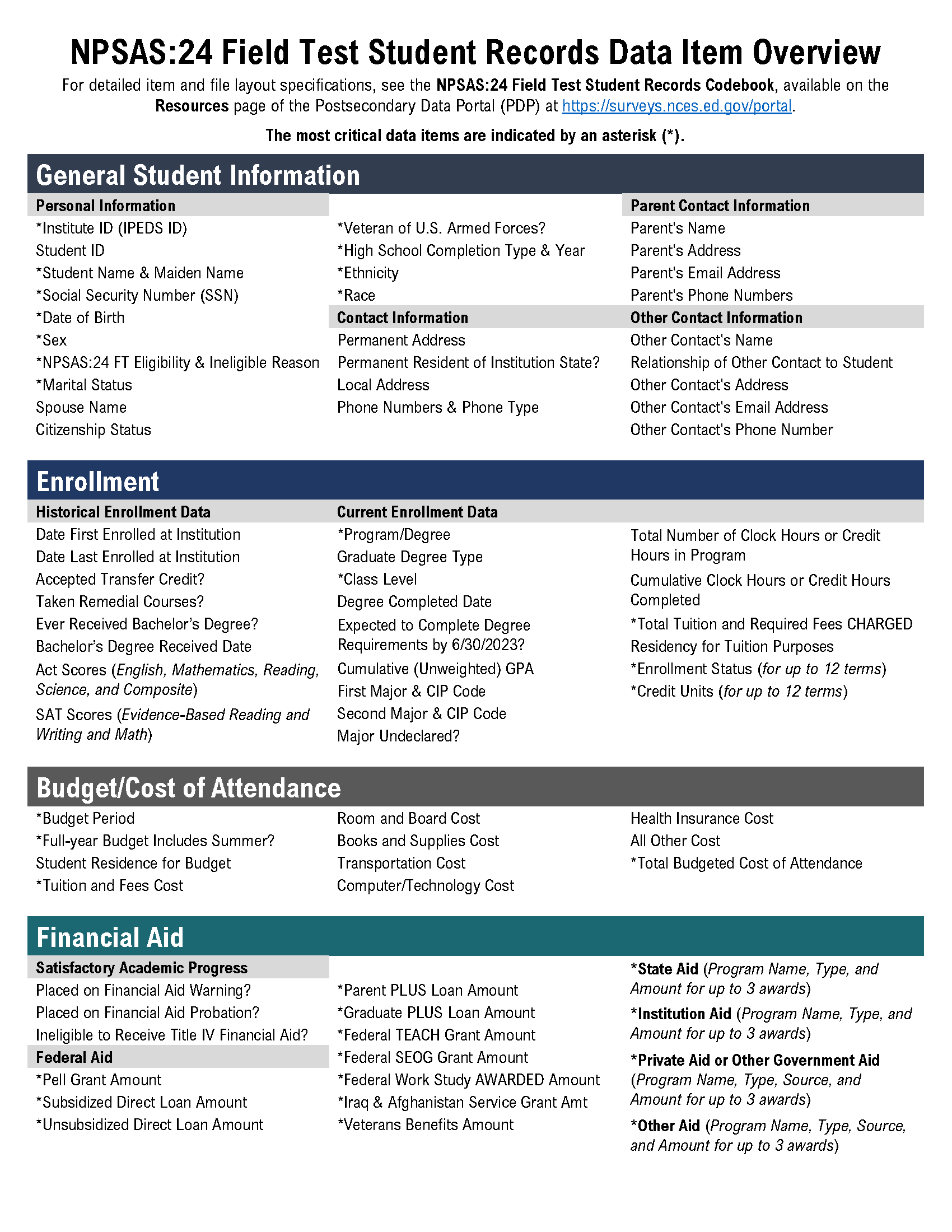
What’s New
If you participated in the NPSAS:20 student record collection in 2020, you will notice some data item changes have been made for NPSAS:24 Field Test. These revisions are intended to increase data quality, clarify item definitions, and improve instructions. The list of revisions below will help you to make updates to the programs you use to retrieve the requested data.
Section |
Item |
Section & Field # |
Revision |
Overall |
-- |
-- |
NPSAS:20 collected enrollment, budget, and financial aid data for the 2019-2020 academic year. NPSAS:24 Field Test collects data for the 2022-2023 academic year. All items that refer to specific date ranges have been updated accordingly. |
Overall |
-- |
-- |
Several NPSAS:20 data items included special instructions for providing data for students impacted by COVID-19 related disruptions of study. These instructions have been removed for NPSAS:24 Field Test. |
General Student Information |
Citizenship Status |
G #21 |
Response options updated to remove reference to “resident alien.” |
Enrollment |
Remedial Course-taking |
E #12 |
Item definition revised to provide clarification about how to report courses taken at other institutions. |
First-time Beginning Student |
n/a (formerly E #13) |
Item removed. |
|
SAT Essay |
n/a (formerly E #13) |
Item removed. |
|
Expected to Complete Degree Requirements |
E #30 |
Response options updated to provide options for “Unknown” and “Does not apply.” |
|
First Major CIP Code and Second Major CIP Code |
E #33 and E #35 |
Item definition updated to use CIP 2020 taxonomy. |
|
Tuition & Fees Refunded due to COVID-19 |
n/a (formerly E #44) |
Item removed. |
|
Room & Boarded Refunded due to COVID-19 |
n/a (formerly E #45) |
Item removed. |
|
Budget |
Budget Period |
B #5 |
Item definition revised to provide four options for providing budget data, numbered in order of preference. |
Student Residence |
B #7 |
Response options updated to refer to “with/without family” instead of “with/without parents.” |
|
Financial Aid |
Perkins Loan |
n/a (formerly F #15) |
Item removed. |
Federal SEOG |
F #15 |
Item definition updated to specify that Emergency SEOG should be reported separately. |
|
Financial Aid Program Type (all awards) |
Multiple |
New financial aid type response option added for emergency aid. |
Selecting a Mode to Provide Data
We offer three modes for providing student records data. You can choose any mode and switch modes at any time.
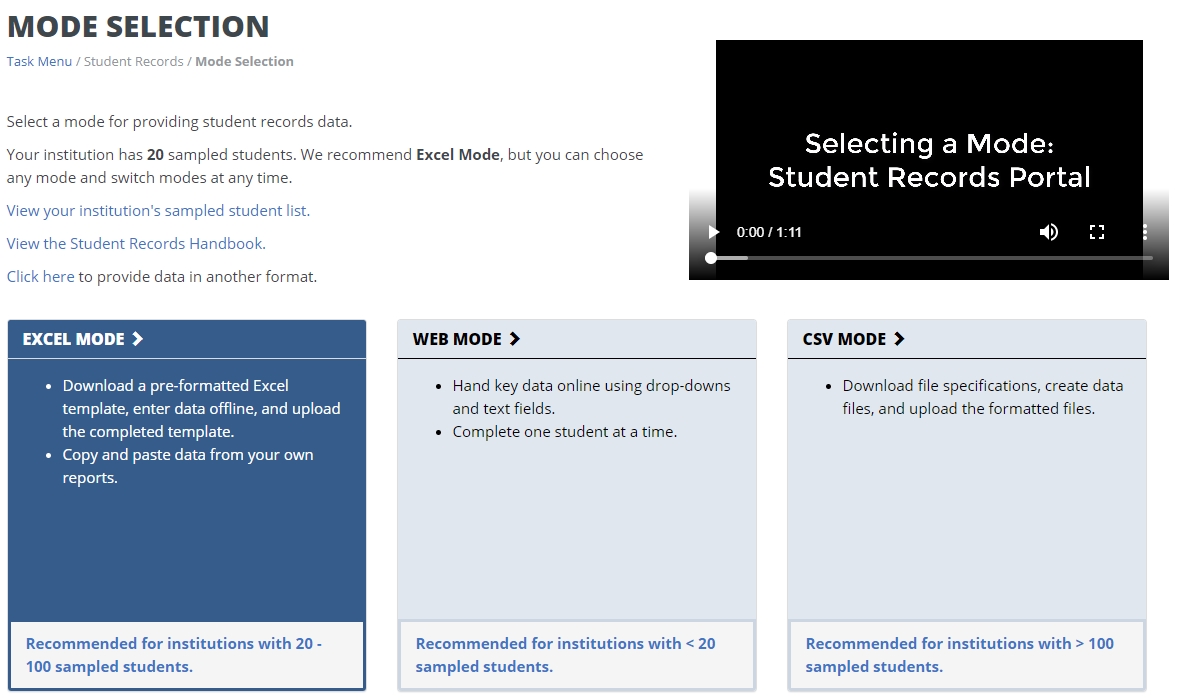
Web mode: In web mode, data are entered online, one student at a time, using drop-down and text entry fields. You can also use web mode to edit data that you have already provided in Excel or CSV mode. Web mode is an ideal mode for institutions with fewer than 20 sampled students.
Excel mode: In Excel mode, you download a pre-formatted Excel spreadsheet from the Portal website, fill it out offline, and upload the completed file to the Portal. You can hand key data into the Excel fields, or copy and paste data from other reports. Excel mode is recommended for institutions with 20 to 100 sampled students.
CSV mode: In CSV mode, you download customized file specifications from the Portal, create your comma separated value (.csv) files offline, and upload the files to the Portal. CSV mode is best for institutions with 100 or more sampled students and the ability to program data files.
Web mode
The Web Mode Grid displays a list of your institution’s sampled students and your progress providing data for each section. The icons indicate whether each section is not started [icon], in progress [icon], errors present [icon], or complete [icon].
Select a student from the list and click his or her name to begin entering data.
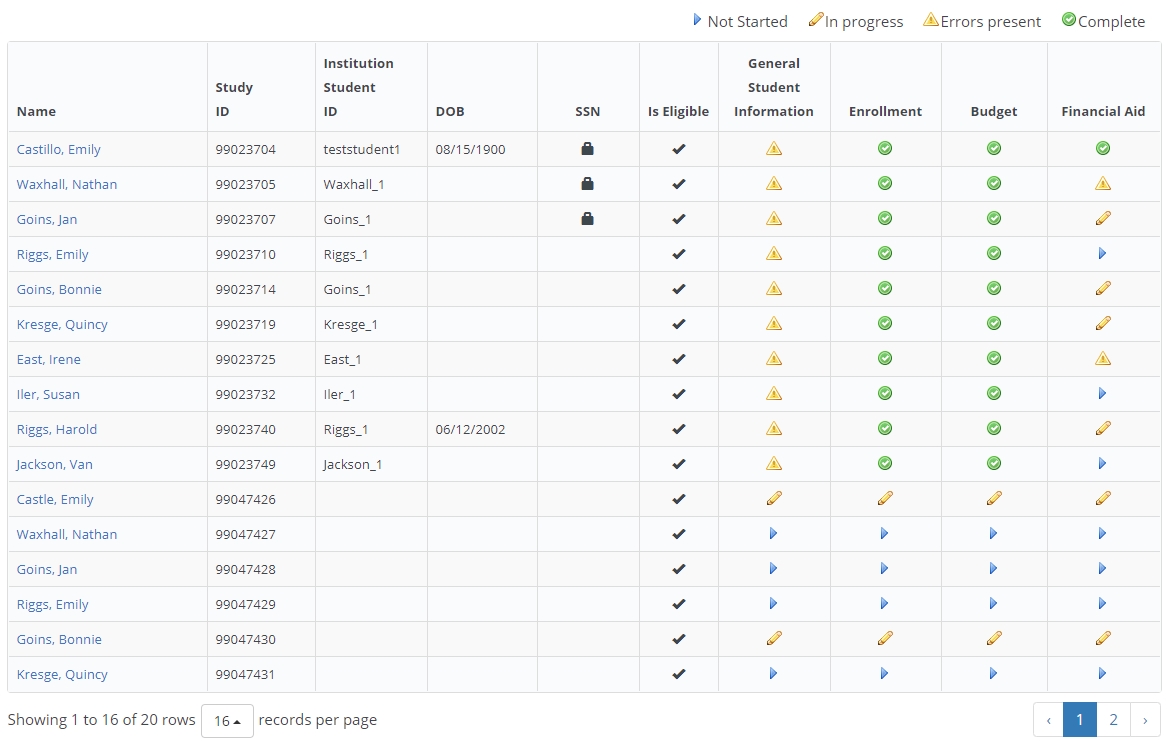
There are four data sections: General Student Information, Enrollment, Budget, and Financial Aid. To advance to the next section of data entry, click the buttons at the top of the page. If you want to jump directly to another student’s data entry page, you can enter their name or ID into the search bar.
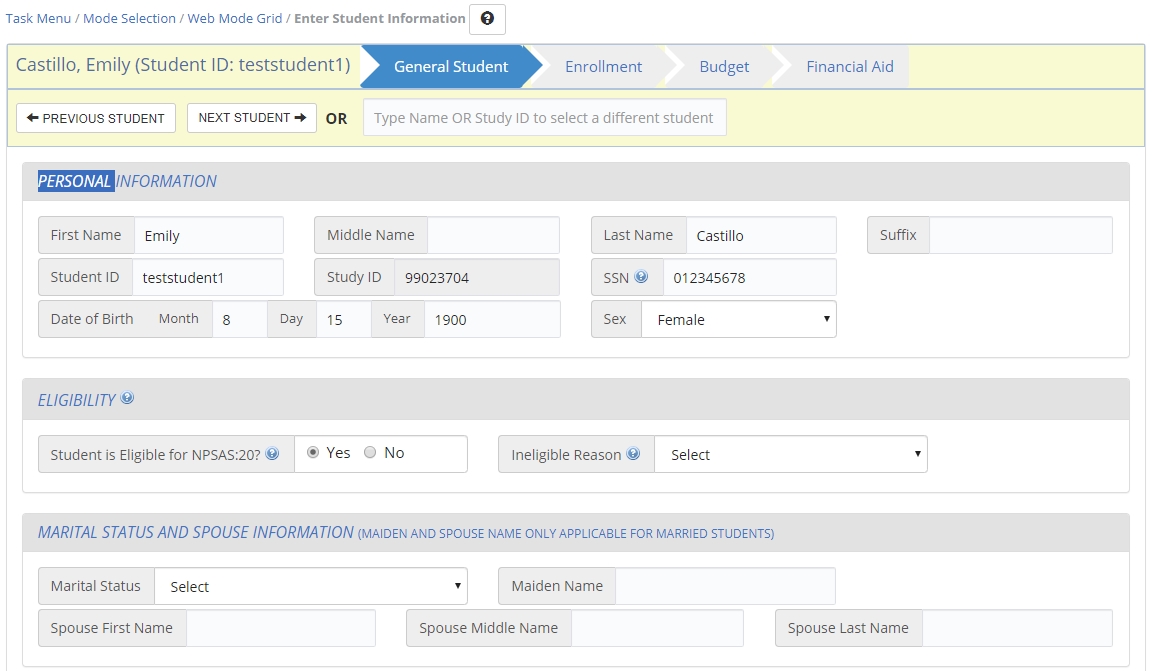
Many items in the survey also include clarifying help text. When [blue icon] is visible next to an item, that lets you know help text is available for that item. When clicked, the help text will appear like the text box below.
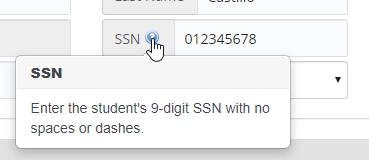
When you are done entering data for all students, or if you want to check on your progress, return to the Web Mode Grid page. After you have entered all available data for all students, click Finalize All Student Record Information at the bottom of the Web Mode Grid page. You will no longer be able to edit or enter data.
Excel mode
The Excel mode page includes numbered steps to guide you through the process of providing data using Excel mode.
Prior to downloading the Excel template, you must check the “I agree” box to indicate that you agree to safeguard the file. Once you check the box, you will be able to click the Download Excel Template button and download the file.
Any data that you have previously provided will be pre-filled in the template.
There are six tabs in the file:
1) Instructions for uploading the file.
2) Item Codebook, which lists all the requested data elements and the valid response options for each item.
3-6) Student data sections: General Student Information, Enrollment, Budget, and Financial Aid.

The file is restricted to prevent edits that could damage the file or misalign data between students. You will not be able to add or remove columns or rows, filter, or sort.
Enter your student record data into the template by keying, selecting drop-down options, or copying and pasting. Always save your file in a secure location.
For data fields with a finite set of valid response options (i.e., drop-down fields), there are three options for entering data:
Select the response from the drop-down list
Paste the exact text of the response option into the cell
Paste/enter the code associated with the response option into the cell.
For example, for Program/Degree field, you could provide “Bachelor’s Degree” by doing any of the following:
Select “Bachelor’s Degree” from the drop-down field.
Paste the text “Bachelor’s Degree” into the field from another source.
Enter or paste “4” into the field, which is the code that corresponds to “Bachelor’s Degree.”
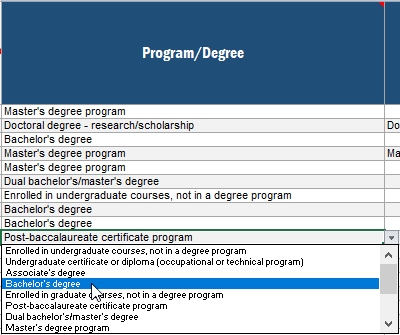
Note: You can paste over multiple cells at once. You do not have to enter data one cell at a time.
Formatting data: The Student Records Codebook includes valid values and suggested data formats. For example, we request that dates be provided using a 2-digit month. We ask that you provide data in the suggested format if possible. If you are not able to provide data in the suggested format, the PDP website will accept data in other formats. Please contact the Help Desk if you have questions or concerns about formatting data. Our team may be able to work with your institution’s data without reformatting. There is no maximum length for any field.
When you have finished entering data, return to the Excel mode page on the Portal and upload your completed file. You will be asked to select which sections of your file you would like to upload. You can select individual sections or upload all four sections at once.
You can upload your files multiple times; the most recent upload will overwrite previous uploads based on the sections you select.
When your upload is complete, a grid will display a list of each file you have uploaded and the status of the upload. Do not email your template to the help desk!
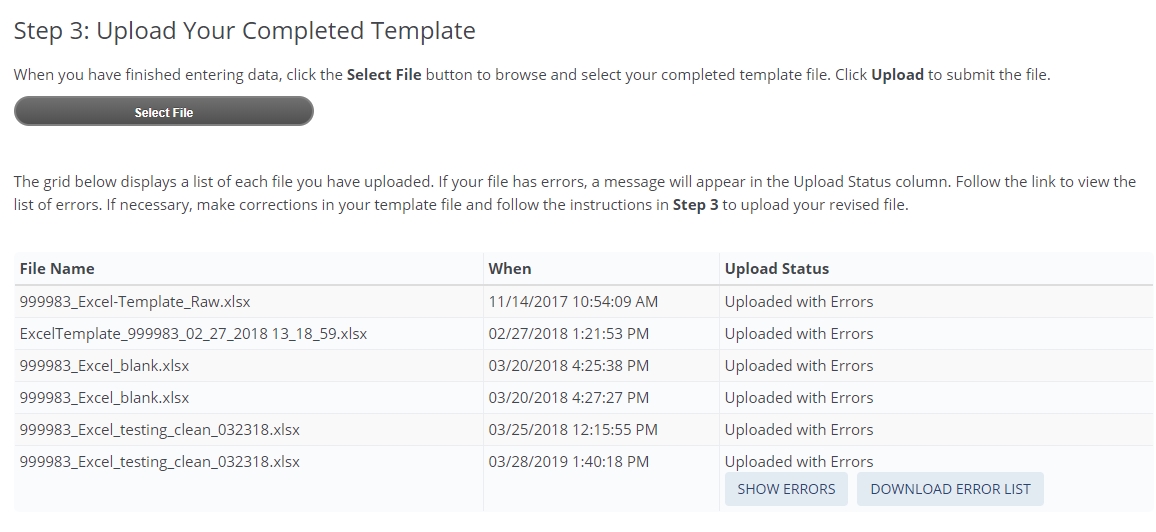
If any errors are detected, they will be indicated by “Uploaded with Errors” in the Upload Status column. You may view the errors on screen by clicking “Show Errors.” You can also download the list of errors as an Excel file.
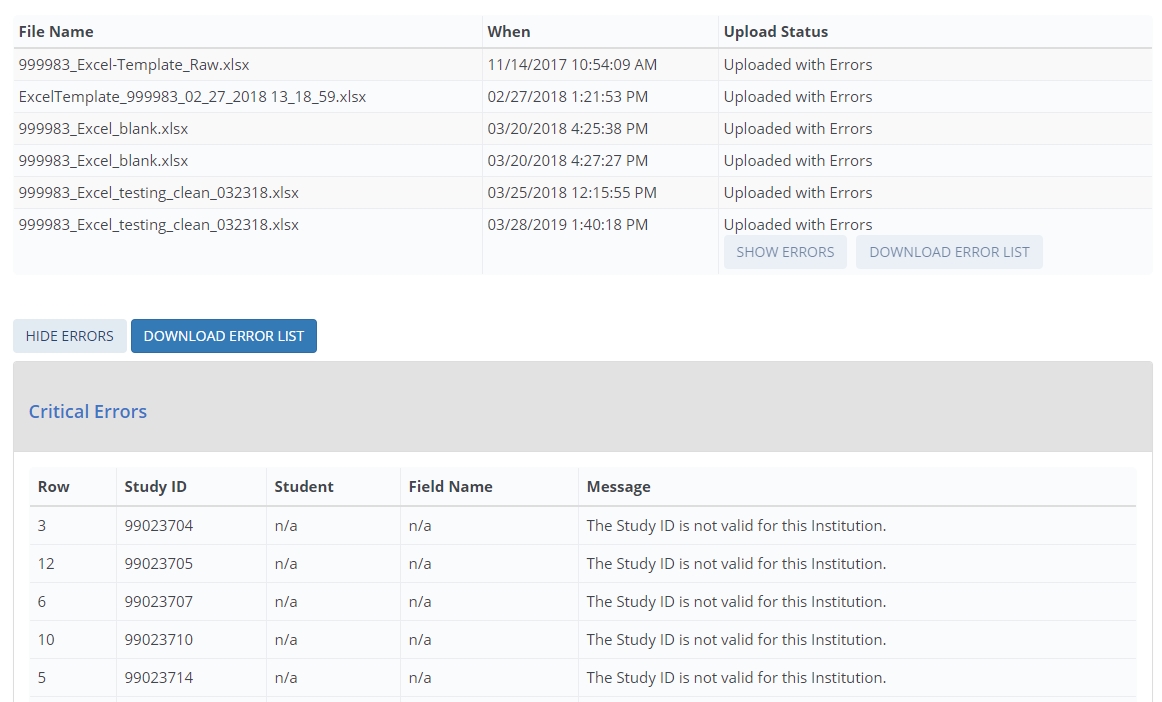
You can upload as many Excel templates as needed – if your file had errors, revise the file and upload again. The most recent file will overwrite previous uploads.
When you have finished uploading data for all students, click Finalize All Student Record Data. Once you finalize, you will no longer be able to make changes.
CSV mode
The CSV mode page includes numbered steps to guide you through the process of providing data using CSV mode.
You will download two files:
The list of students sampled from your institution
CSV file specifications document
Prior to downloading the list of sampled students, you must check the “I agree” box to indicate that you agree to safeguard the file. Once you check the box, you will be able to click the Download Student List button and download the file.
The file specifications will provide file layout instructions for creating four CSV files: the General Student Information file, the Enrollment file, the Budget file, and the Financial Aid file. The file specifications indicate the number of fields that are required for each file, the order in which data elements should be submitted, and the valid values for each data element.
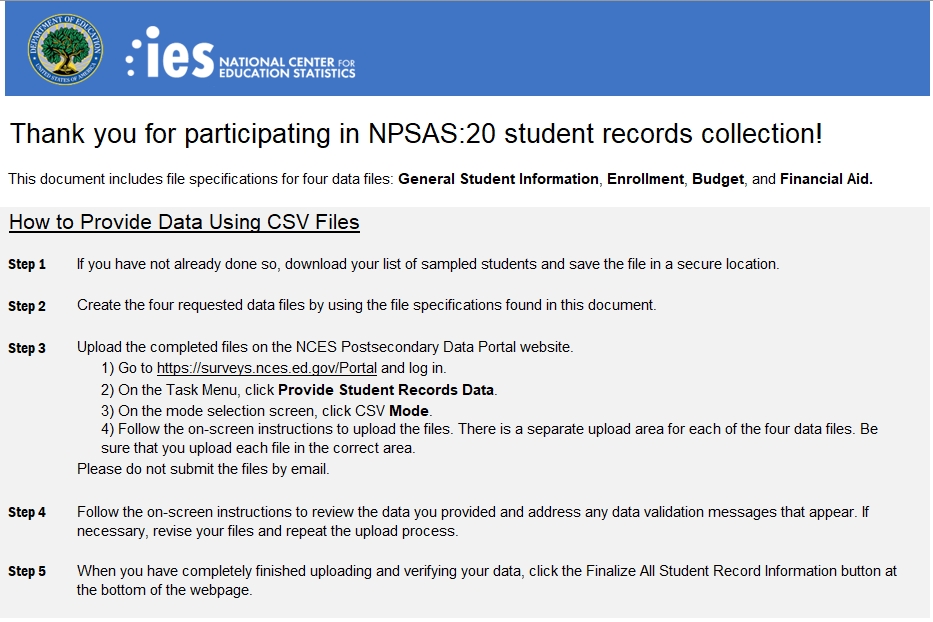
It is extremely important that you follow the file specifications exactly. If your CSV files don’t have the correct number of fields, the data will not be read into the Portal. If you find yourself needing to skip a data element, be sure to include a comma as a placeholder for that data element.
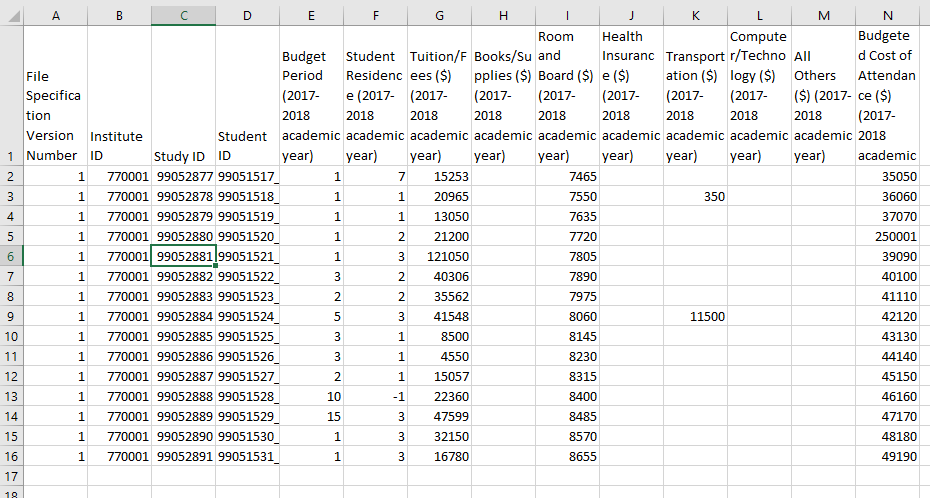
Formatting data: The Student Records Codebook includes valid values and suggested data formats. For example, we request that dates be provided using a 2-digit month. We ask that you provide data in the suggested format if possible. If you are not able to provide data in the suggested format, the PDP website will accept data in other formats. Please contact the Help Desk if you have questions or concerns about formatting data. Our team may be able to work with your institution’s data without reformatting. There is no maximum length for any field.
When you have finished entering data, return to the Excel mode page on the Portal and upload your completed file. You will be asked to select which sections of your file you would like to upload. You can select individual sections or upload all four sections at once.
When you’ve finished entering data, return to the CSV mode page on the Portal and upload your completed files. There are separate upload areas for each of the four file types; be sure you upload them in the correct section. Do not email your files to the help desk!
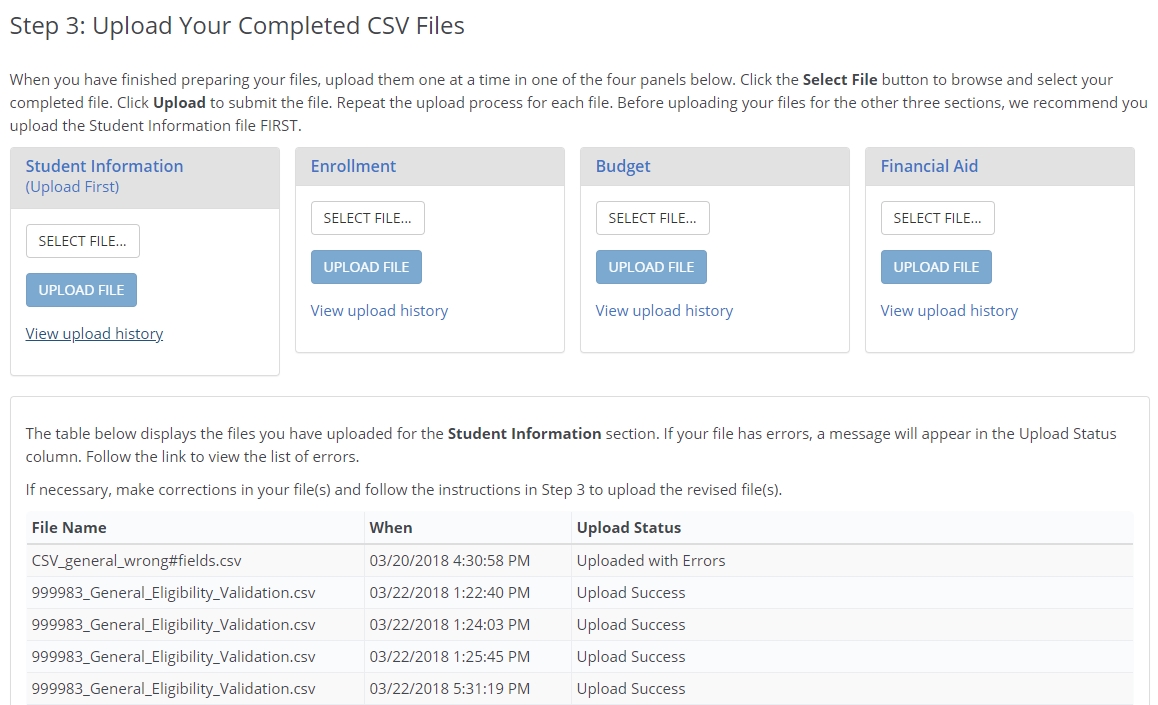
When your upload is complete, a grid will display a list of each file you have uploaded and the status of the upload.

If any errors are detected, they will be indicated by “Uploaded with Errors” in the Upload Status column. You may view the errors on screen by clicking “Show Errors.” You can also download the list of errors as an Excel file.
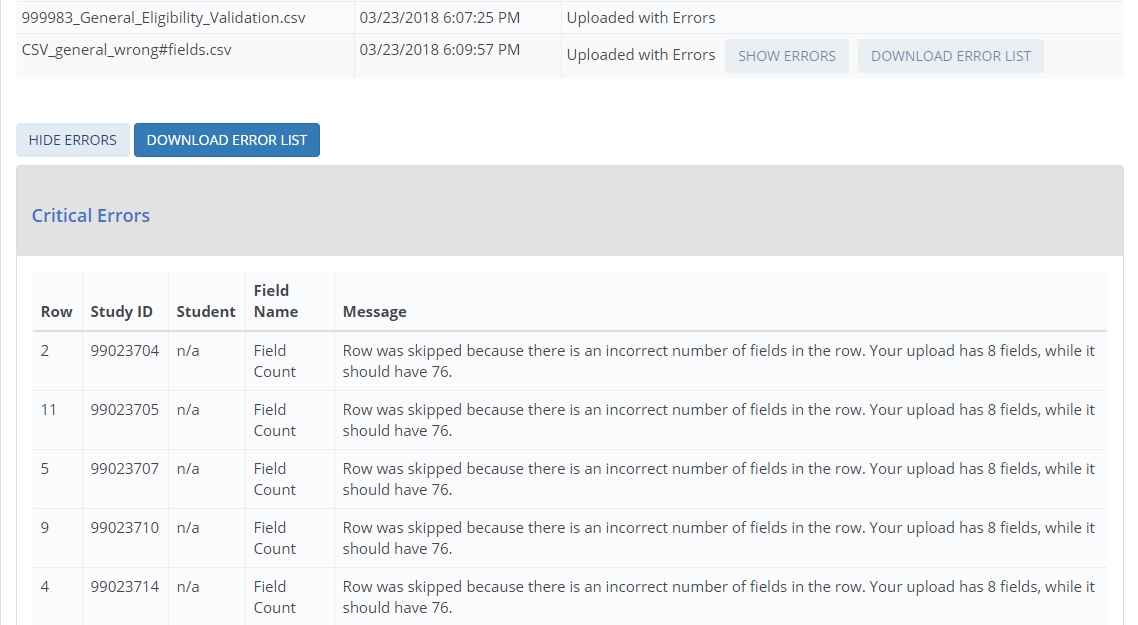
You can upload as many CSV files as needed – if your file has errors, revise the file and upload again. The most recent file will overwrite previous uploads.
When you have finished uploading data for all students, click Finalize All Student Record Data. Once you finalize, you will no longer be able make changes.
Guide to the General Student Information Section
The General Student Information section collects demographic, contact, and other background information about sampled students.
Data item spotlight: Race and Ethnicity
Race and ethnicity are collected in two parts:
Ethnicity collects whether students are Hispanic or Latino.
Race collects students’ race in one or more of five categories: White, Black or African American, Asian, American Indian or Alaska Native, and Native Hawaiian or Other Pacific Islander.
For NPSAS, there are no race categories for Hispanic, Two or more races, or Nonresident Alien, which are used for IPEDS reporting. While these race and ethnicity categories differ from those reported to IPEDS, institutions are required to collect and store race and ethnicity data using the same 2-question format used for NPSAS. Details about this requirement may be reviewed at https://surveys.nces.ed.gov/ipeds/public/hrsoc-browse/faq-re.
When you submit NPSAS:24 Field Test student records data, you will receive an error message if you (a) leave all race items blank, or (b) select No for all race items. To resolve the error message, you may either select Yes for at least one race item or select Unknown for all race items.
Data item spotlight: NPSAS eligibility
Once you begin providing data, you may realize that a student from your institution is not eligible for NPSAS:20. If that happens, make sure that you indicate the student is ineligible on the PDP and provide a reason. You do not need to provide any other data for ineligible students. If you skip a student without indicating that he or she is ineligible, you will continue to receive error messages for missing data.
Note that in Web and Excel mode, the “Eligible for NPSAS:24 Field Test” item defaults to Yes unless you change the selection. In CSV mode, if you leave this item blank, the student will be treated as eligible for NPSAS:24 Field Test.
The Eligibility items are part of the General Student Information section of student records.

Reasons that a student may be ineligible for NPSAS:24 Field Test
Not enrolled at institution: Student was not enrolled at this institution at any time from July 1, 2022 to June 30, 2023.
Tuition refund: Student was enrolled at one time but received a full tuition refund for all terms in study period from July 1, 2022 to June 30, 2023.
Pays tuition to another institution: Student attends this institution under joint arrangements with another institution and pays tuition solely to the other institution.
Length of program: Student was enrolled in an occupational/technical program of study less than 3 months or 300 clock/contact hours of instruction.
Non-credit program: Student was enrolled, but not in at least one course that could be applied toward fulfilling requirements for an academic degree, a certificate or diploma program, or in a term for credit that could be transferred to another school.
Completing high school: Student was still completing high school requirements as of the last term enrolled in the July 1, 2022- June 30, 2023 academic year.
GED or high school completion program: Student was enrolled solely in a GED or high school completion program as of the last term enrolled in the July 1, 2022 - June 30, 2023 academic year.
Adult basic education program: Student was enrolled solely in an adult basic education program (e.g., ESL, literacy) as of the last term enrolled in the July 1, 2022 - June 30, 2023 academic year.
Guide to the Enrollment Section
The enrollment section collects information about students’ program, academic progress, and enrollment intensity.
Some items in the enrollment section, such as program/degree and class level, were requested on your institution’s student enrollment list. These data were needed on the enrollment list for selecting a representative sample of students.
If you provided these items on the enrollment list, the data will be preloaded into Web mode and the Excel template. Please verify that this data is still current and update as necessary.
If you submit data using CSV mode, we ask that you still provide these data elements in your data files. The student’s program, class level, and other data may have changed since your student enrollment list was submitted.
Data item spotlight: Total Tuition and Required Fees Charged
This item collects the total amount of tuition and fees charged to the student. You will be asked to report using one of the following options, depending on your institution’s calendar system:
For term-based institutions: the terms that constitute your institution’s 2022-2023 academic year. The list of terms you should include will be prefilled into the item wording and were selected based on your institution’s responses during the Registration step of NPSAS:20. If you have questions or concerns about the prefilled terms, please contact the Help Desk.
For continuous enrollment institutions: the period July 1, 2022 to June 30, 2023.
Data item spotlight: Enrollment Status
This series of items asks you to indicate the student’s enrollment intensity in each term or month in the period between July 1, 2022 and June 30, 2023, depending on your institution’s calendar system.
Valid enrollment status options:
0 = Not enrolled
1 = Full-time
2 = 3/4-time
3 = Half-time
4 = Less than half-time
Note that “part-time” is not one of the valid response options. If possible, please select the part-time status that matches the student’s enrollment pattern (3/4 time, half-time, or less than half-time). If your institution can only report students as “part-time,” it is critical that you also provide the number of credit or clock hours enrolled in the item that immediately follows Enrollment Status. NPSAS staff will use the units enrolled to calculate students’ enrollment intensity.
Guide to the Budget (Cost of Attendance) Section
The Budget section collects budgeted costs for tuition and fees, room and board, and six other budget categories for the 2022-23 academic year.
There are four options for providing budgeted cost of attendance data:
Option 1 (preferred): Please provide the full-time, full-year budget that matches this student’s program and residence, even if the student was not enrolled full-time for the entire year. Note that there is a separate item in the Budget section for you to indicate whether your “full-year” budget does or does not include summer sessions.
Option 2: If a full-time, full-year budget is not available, you can use Pell guidelines to prorate the amount to reflect the costs for a full-time student enrolled for a full academic year in the student’s academic program. For more information about prorating costs of attendance for Pell, visit [link]. A link to the FSA Handbook is also available on the Resources page of the PDP.
Option 3: If a full-time, full-year budget is not available, and you cannot provide a prorated amount, you may provide budgeted costs of attendance for other budget periods (such as full-time/one term, half-time/full-year, etc).
Option 4: If you cannot provide an individualized budget (a budget that includes costs of attendance specific to the student’s program and residence), you can provide a generic budget.
Definitions:
Academic year: An academic year must include at least 30 weeks of instructional time for credit-hour based programs, or 26 weeks of instructional time for clock-hour based programs.
At a semester-based institution, the academic year typically includes fall and spring terms. At a trimester-based institution, the academic year typically includes fall, spring, and summer terms.
Full-time: The following minimum coursework standards are for undergraduate students enrolled full-time in the academic year:
For credit-hour programs, at least 24 semester or trimester credit hours, or 36 quarter credit hours; or
For clock-hour programs, at least 900 clock hours.
Callout: How does the NPSAS budget differ from our Pell budget(s)? The budget requested for NPSAS is similar to the full-time/full-year budgeted costs of attendance reported for Pell. While Pell budgets do not include summer terms, you should include summer session(s) in your budget for NPSAS if possible. If you cannot report budgeted costs of attendance for summer session(s), or the student did not attend during the summer, your institution’s NPSAS budget may be the same as the Pell budget for this student’s program and residence (e.g., on-campus, off-campus with parents, off-campus not with parents).
The budget is one of the most important parts of NPSAS:24 student records, so if you are not sure what to provide, please do not leave this section blank. Our Help Desk staff are available to assist if you have questions about reporting budgeted costs of attendance.
Guide to the Financial Aid Section
The Financial Aid section collects all financial aid received by your institution’s sampled students for the 2022-2023 financial aid year. Financial aid is collected in five subsections based on the source of the aid: federal, state, institution, private or other government aid, or other aid.
The Federal Aid section collects aid amounts for each of the following federal aid programs:
Pell Grant
Subsidized Direct/Stafford Loan
Unsubsidized Direct/Stafford Loan
Parent PLUS Loan
Graduate PLUS Loan
Federal TEACH Grant
Federal SEOG Grant
Federal Work Study Awarded
Iraq & Afghanistan Service Grant
Veterans Benefits
The State Aid, Institution Aid, Private Aid or Other Government Aid, and Other Aid sections collect data differently. For each of these awards received by the student, provide the aid program name, type, source (if requested), and amount disbursed for up to 3 awards in each subsection. If the student has received more than 3 awards in each category, use the Other Aid section for overflow.
For help categorizing financial aid awards, see the Financial Aid Type Cheat Sheet. The Cheat Sheet includes the most common financial aid awards reported in your state and guidelines for how to report those awards.
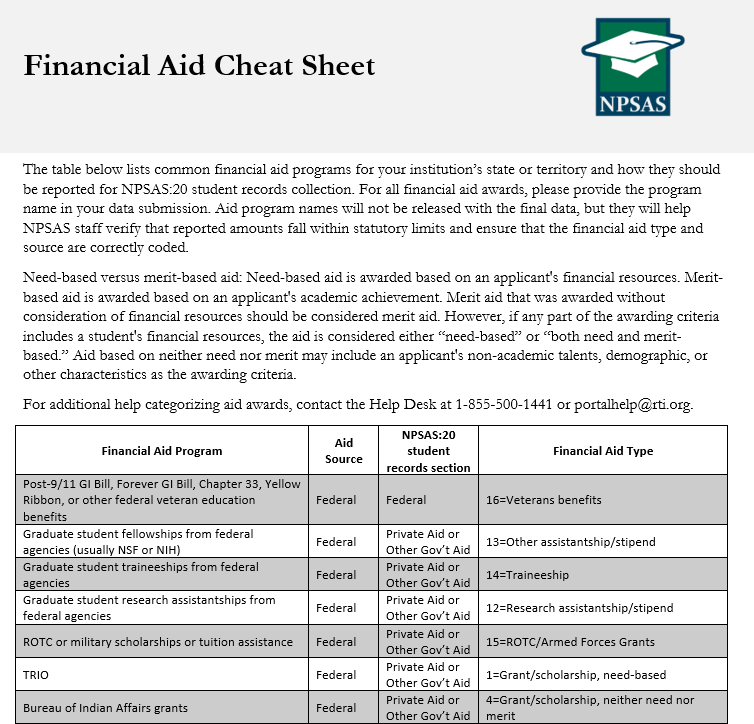
Each section begins with a Yes/No question asking if the student received that type of aid in 2022-2023. For example, the first question in the State Aid section is “Student had state aid for the 202922023 financial aid year?” If the student did not have state aid, select No and skip the remaining items in the State Aid section.
These Yes/No questions are critical, and you will receive error messages for leaving them blank. You will also receive error messages if you select Yes but do not provide details about the financial aid award.
Which Financial Aid to Report:
For term-based institutions, the financial aid section will ask you to report aid disbursed for the terms in your institution’s 2022-2023 academic year. These terms will be prefilled into the item wording and were selected based on your institution’s responses during the Registration step of NPSAS:24 Field Test.
For example, if your institution considers Fall 2022, Spring 2023, and Summer 2023 to be part of the 2022-2023 academic year, the instructions for the State Aid subsection will be as follows:
“For each state aid award received by the student, report the total whole dollar amount disbursed for Fall 2022, Spring 2023, and Summer 2023...”
For continuous enrollment institutions, the financial aid section will ask you to report aid disbursed for the 2022-2023 financial aid year (July 1, 2022 to June 30, 2023).
If the student has aid for the period requested that has not yet been disbursed, include the amount awarded that you expect to be disbursed.
Other tips for reporting financial aid data:
Report financial aid as whole dollar amounts; round decimals to the nearest whole dollar.
Report the total combined amount of aid for each award, not separate amounts for each term.
Report each aid program separately: do not combine multiple aid programs together
How to report financial aid for students with more than 3 awards:
The State Aid, Institution Aid, Private Aid or Other Government Aid, and Other Aid sections collect up to 3 financial aid awards in each subsection. If the student has received more than 3 awards in each category, please try the following steps:
Review the awards to see if they should be collapsed into one award. If a student received multiple disbursement of the same aid program in 2022-2023, they can be reported as one award. For example, if a student received separate private loans for Fall 2022, Spring 2023, and Summer 2023, those awards can be reported as a single private loan.
A student that received a $1200 private loan for Fall 2022, a $1200 private loan for Spring 2023, and a $600 private loan for Summer 2023 should be reported as follows:
|
Student had private aid or other gov’t aid for the 2022-2023 financial aid year? |
Private/Other Government Program 1 Name |
Private/Other Government Program 1 Type |
Private/Other Government Aid Program 1 Amount |
Student 1 |
Yes |
Private Loan |
Private Loan |
3000 |
Review your data to make sure you are not listing awards for students that did not receive those awards. For example, the following example incorrectly lists state aid for students who did not receive the award.
|
Student had state aid for the 2022-2023 financial aid year? |
State Aid Program 1 Name |
State Aid Program 1 Type |
State Aid Program 1 Amount |
Student 1 |
Yes |
GA HOPE Scholarship |
Grant/scholarship, merit-based |
2152 |
Student 2 |
No |
GA HOPE Scholarship |
Grant/scholarship, merit-based |
0 |
Student 3 |
Yes |
GA HOPE Scholarship |
Grant/scholarship, merit-based |
1077 |
Student 4 |
No |
GA HOPE Scholarship |
Grant/scholarship, merit-based |
0 |
Instead, the program name, type, and amount fields should be left blank for students who did not receive aid.
|
Student had state aid for the 2022-2023 financial aid year? |
State Aid Program 1 Name |
State Aid Program 1 Type |
State Aid Program 1 Amount |
Student 1 |
Yes |
GA HOPE Scholarship |
Grant/scholarship, merit-based |
2152 |
Student 2 |
No |
|
|
|
Student 3 |
Yes |
GA HOPE Scholarship |
Grant/scholarship, merit-based |
1077 |
Student 4 |
No |
|
|
|
If you still have more than 3 awards to report in one section, use the Other Aid section for overflow.
Do not combine multiple aid programs together or drop awards. If you need assistance determining how to report data for students with more than 3 awards, please contact the Help Desk.
Student Records Item Overview Handout
This handout includes a summary list of all items in the student records instrument. The content of the instrument is detailed in appendix H. This handout document will be available to institutions as a PDF file in the Resources section of the PDP. The final handout document may include aesthetic changes that do not impact the content of the handout. |

| File Type | application/vnd.openxmlformats-officedocument.wordprocessingml.document |
| Author | Wescott, Jamie |
| File Modified | 0000-00-00 |
| File Created | 2023-08-27 |
© 2025 OMB.report | Privacy Policy
